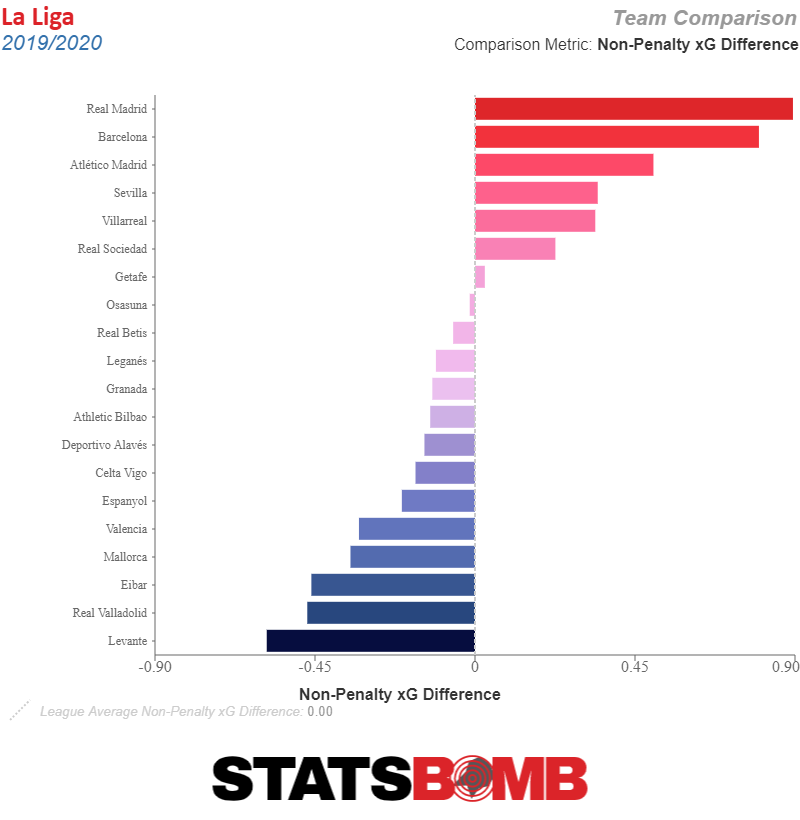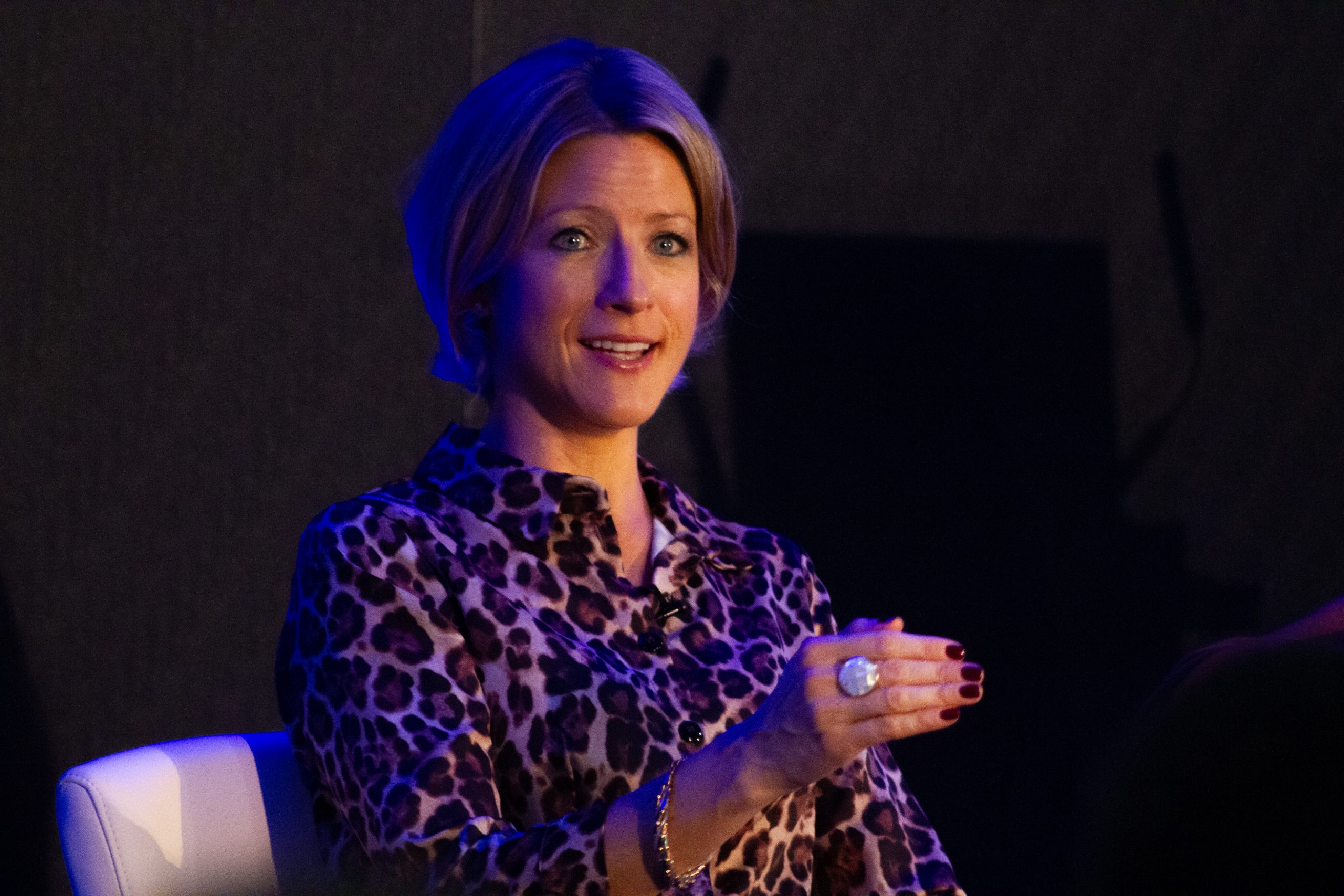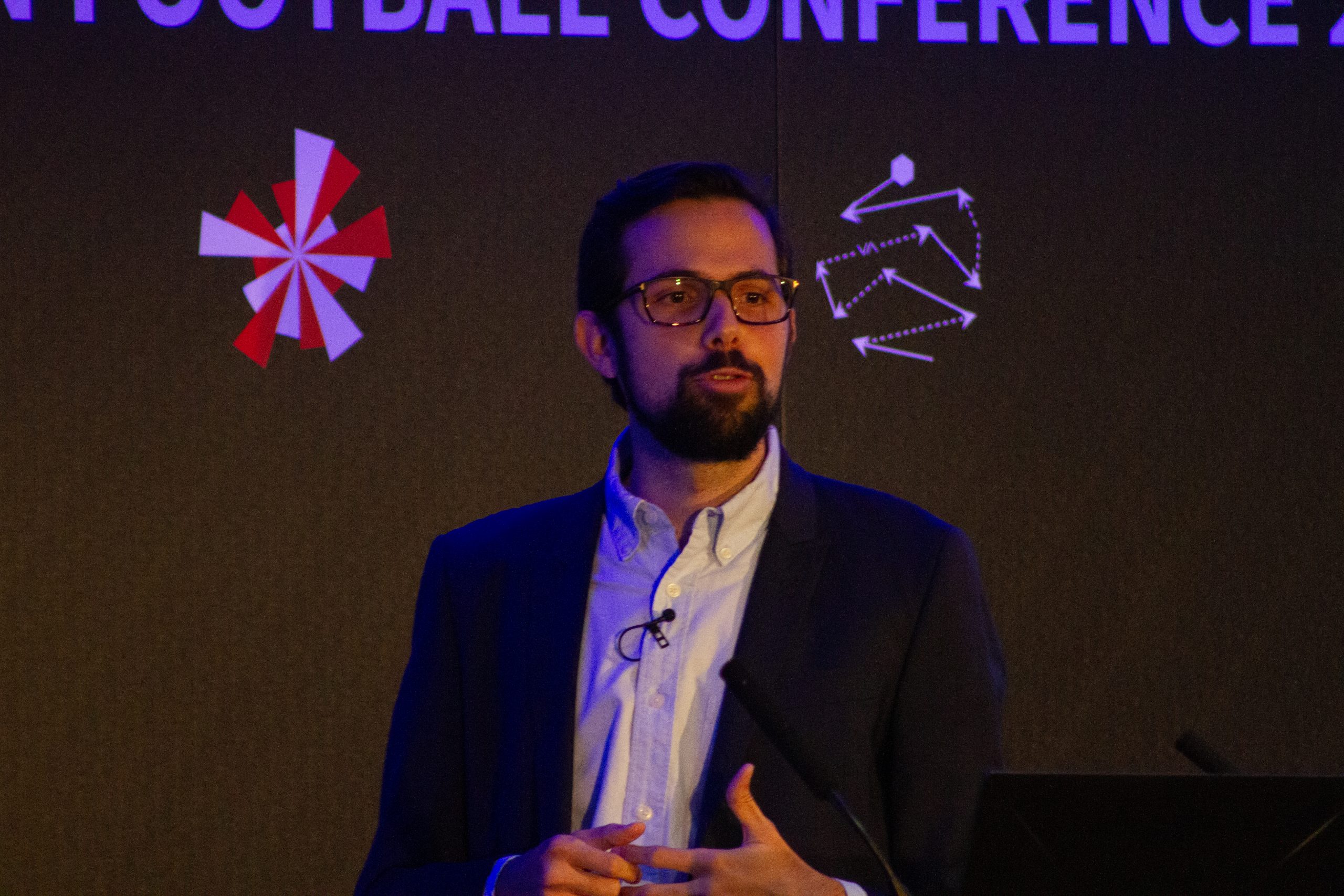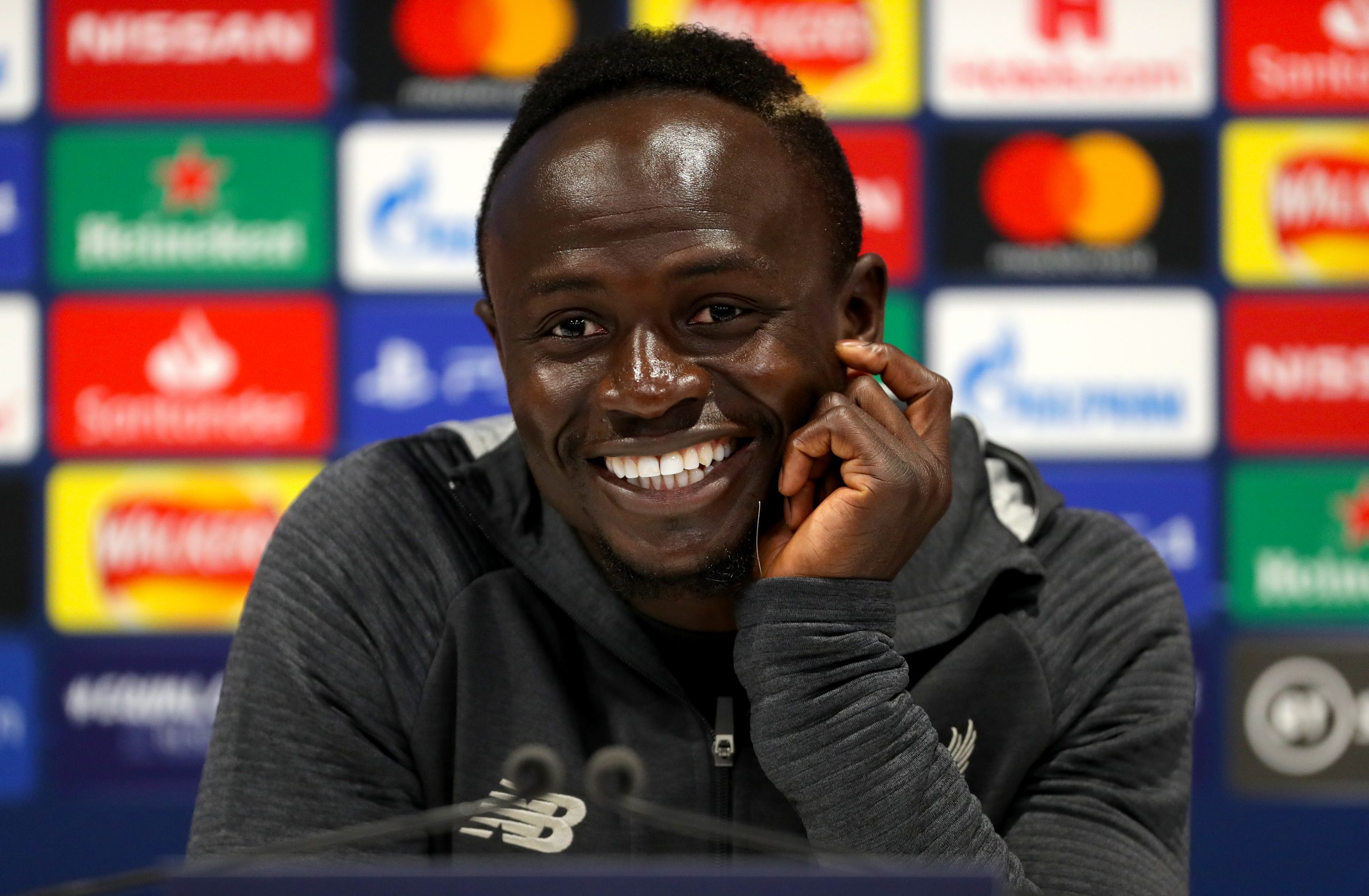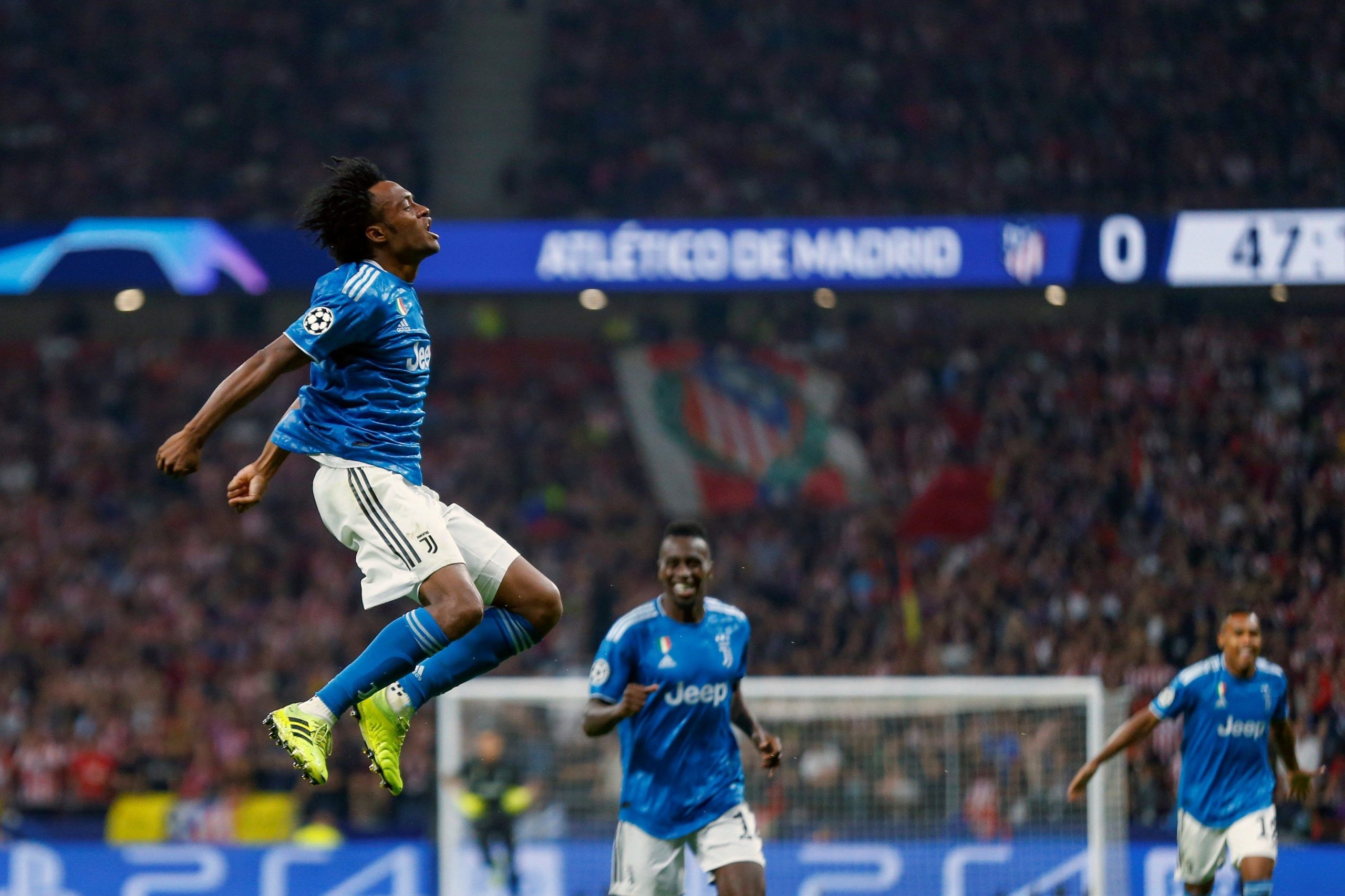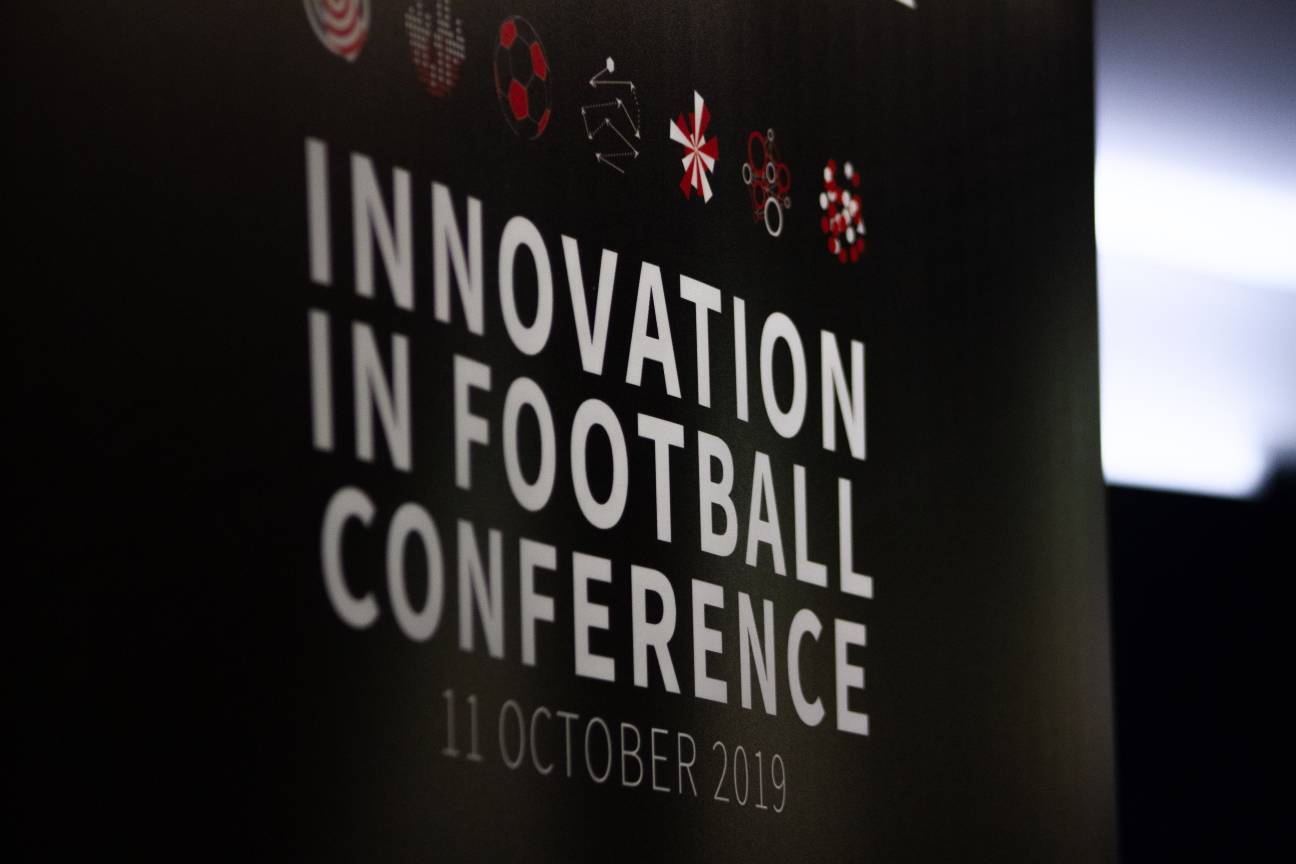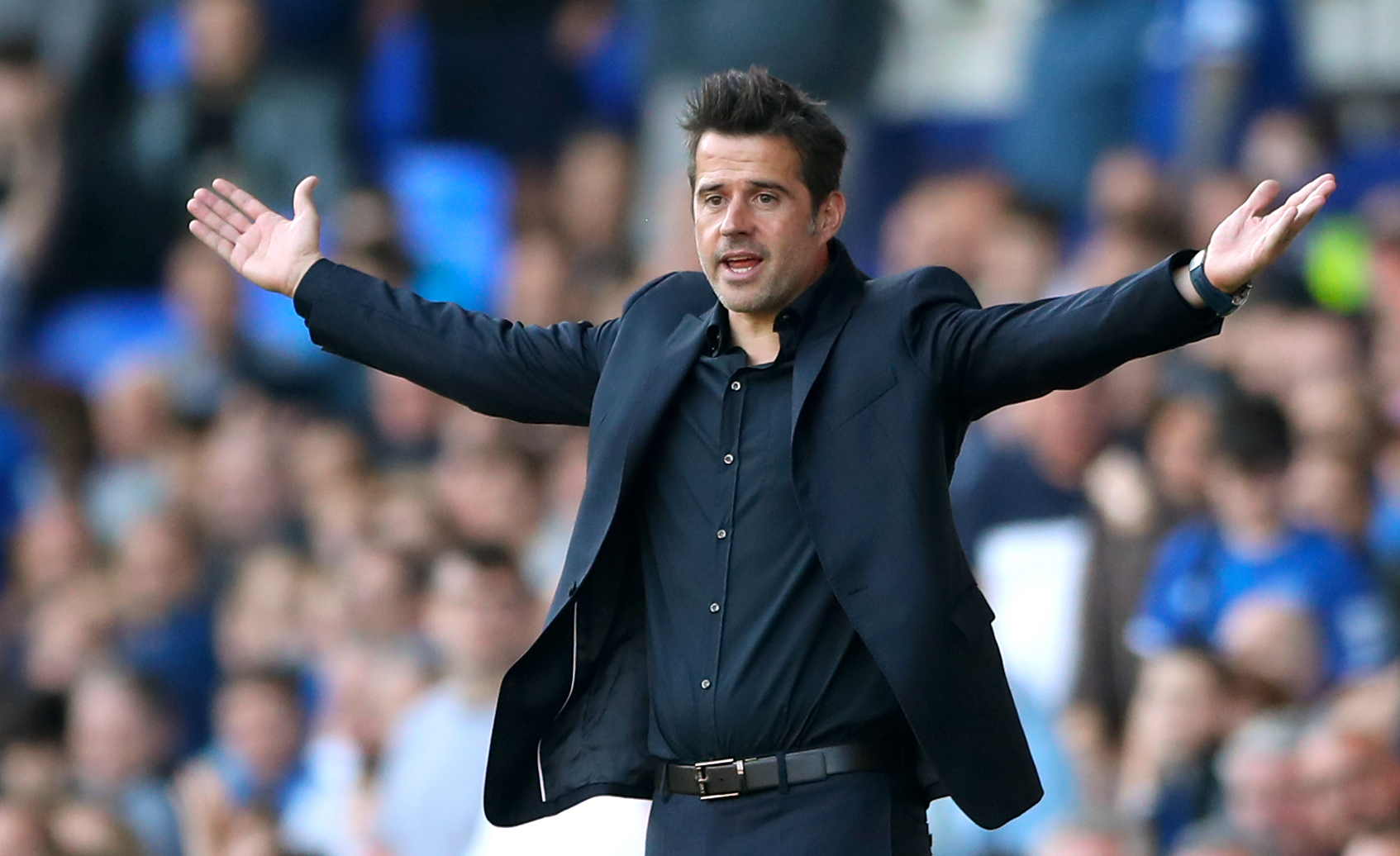Today for your viewing pleasure we have two more videos from our StatsBomb Innovation in Football Conference. First up we have the Working in Football Panel: Opportunities and Difficulties, with Emma Hayes (Head Coach Chelsea Women), Vosse de Boode (Head of Sports Science and Analytics at Ajax), and Jacqui Oatley MBE (ITV,.Sky, BBC). https://www.youtube.com/watch?v=I82lcPHP5zo From the research room we have Michael Caley (@MC_of_A) and his talk, Pressing, Press-Breaking, and Footedness: Exploring StatsBomb's New Data. https://www.youtube.com/watch?v=CZNHD2MUTlU
Month: October 2019
StatsBomb Conference Videos: Javi Fernandez and Karun Singh
We're beginning the process of getting our conference videos out into the wide wide world. First up today, we have Javi Fernandez (@JaviOnData) and his talk "Finding the Free Man: A Contextual Approach for Identifying Spaces." https://youtu.be/nfPEEbKJbpM But wait there's more. We also have Karun Singh (@karun1710) and his talk "Expected Threat and Beyond, A Practical Guide." https://youtu.be/mE3sUVCIwfA
Seattle Sounders vs FC Dallas: A case study on using data to prepare to administer the eye test
Over the weekend the Seattle Sounders beat FC Dallas 4-3. It was a rollicking affair that went into extra time with Jordan Morris completing his hattrick and scoring the winner in the 113th minute. Afterwards, Steve Zakuani said this about the match. https://twitter.com/Zakuani11/status/1185685586167775233?s=20 That wasn’t particularly in line with what the statistics of the match suggested. StatsBomb, for example, had the expected goals at 2.98 for Seattle to 1.59 for Dallas. Zakuani didn’t agree with the stats. https://twitter.com/Zakuani11/status/1185700289644335104?s=20 Given his clarification I don’t think there’s anything particularly wrong with what he’s saying about stats here. Football is a game of tiny sample sizes, all good stats work is a matter of interpretation and context. Doing analytics right is a matter of improving the guesses in the guesswork. Beware of anybody selling absolute certainty about anything. But, it did get me thinking about what using stats in concert with your eyes really means on a granular level. What does it mean to reconcile an assessment of this match with stats that tell a dramatically different story. It can’t just be a matter of saying, “stats are good unless I disagree with what they suggest, then I’ll ignore them.” Usually when I write about a match or a team, I make sure to have watched them. It’s exceedingly rare for me to form a strong opinion based on numbers alone. Frequently, however, I’ll be watching things after I’ve already seen the stats for the match. That is, I’m filtering my eye test through what the stats have primed me for, letting the numbers set my expectations. Today, rather than watching the match and writing about it, I’m going to write about what that process looks like. Given the stats I have at my disposal, and Zakuani’s interpretation, one which was echoed by Matt Doyle who knows more than more or less anybody about the goings on in MLS, let's walk through the process of marrying that assessment to the numbers we have at our disposal. Okay, enough throat clearing. By xG, this match was extremely not close. 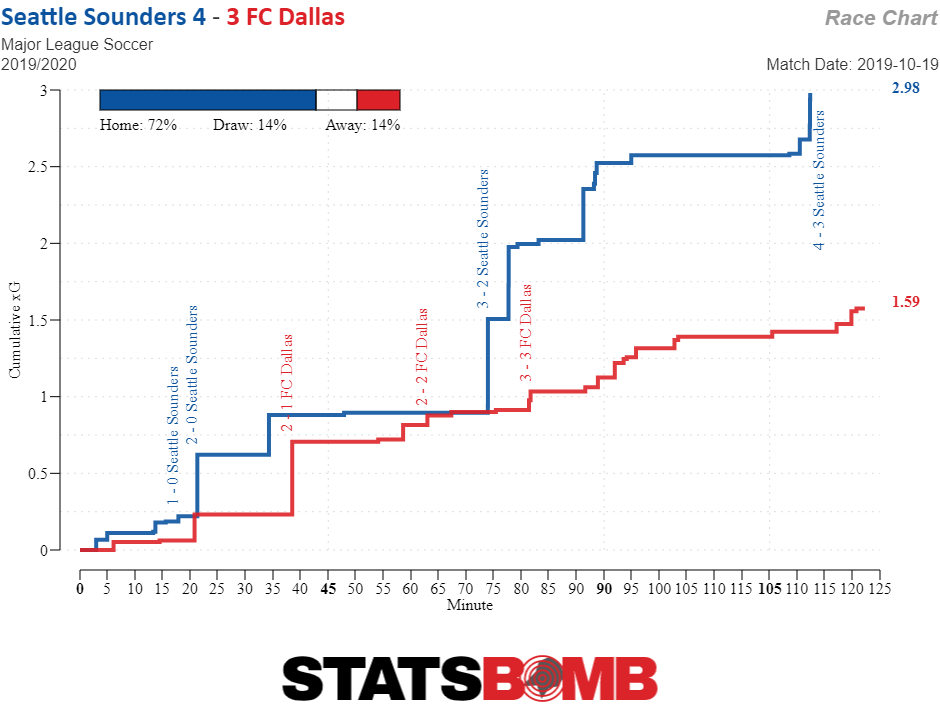 It was a dead even affair until the 74th minute at which point Seattle really pulled away. The mechanics of what happened seem pretty simple. Jordan Morris scored a massive chance from a corner.
It was a dead even affair until the 74th minute at which point Seattle really pulled away. The mechanics of what happened seem pretty simple. Jordan Morris scored a massive chance from a corner. 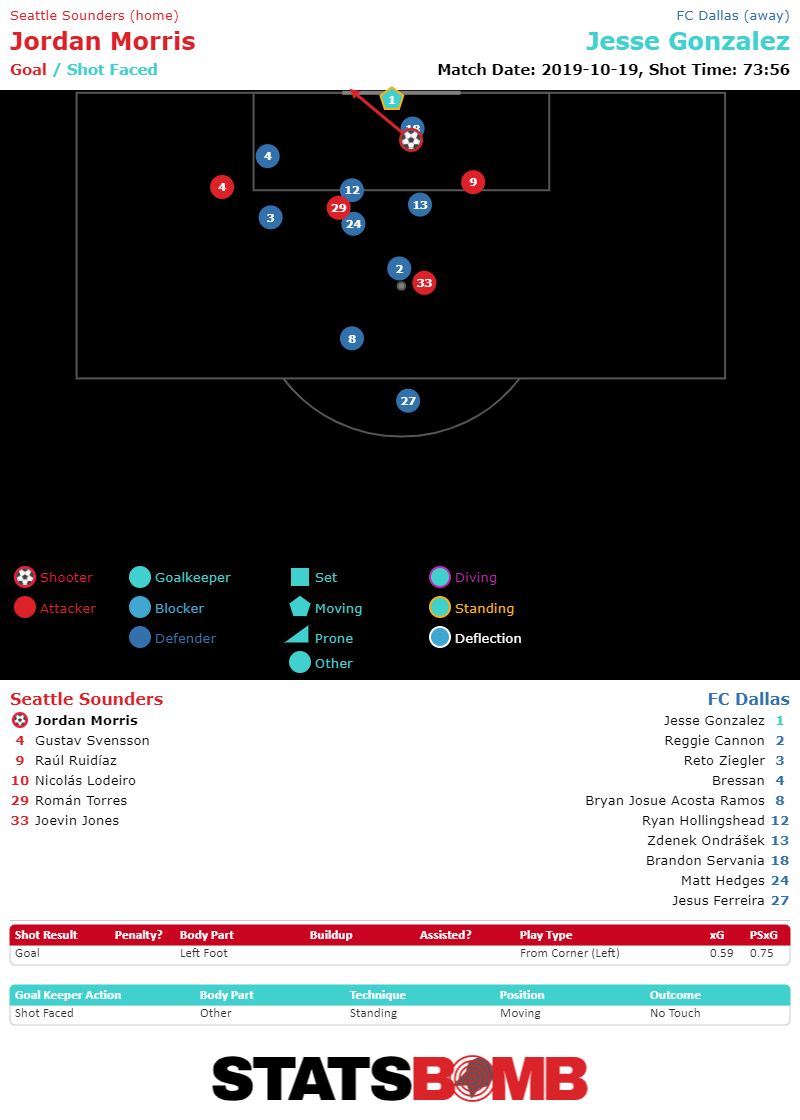 That was followed quite quickly by two pretty good chances from open play. First Victor Rodriguez got this shot off.
That was followed quite quickly by two pretty good chances from open play. First Victor Rodriguez got this shot off. 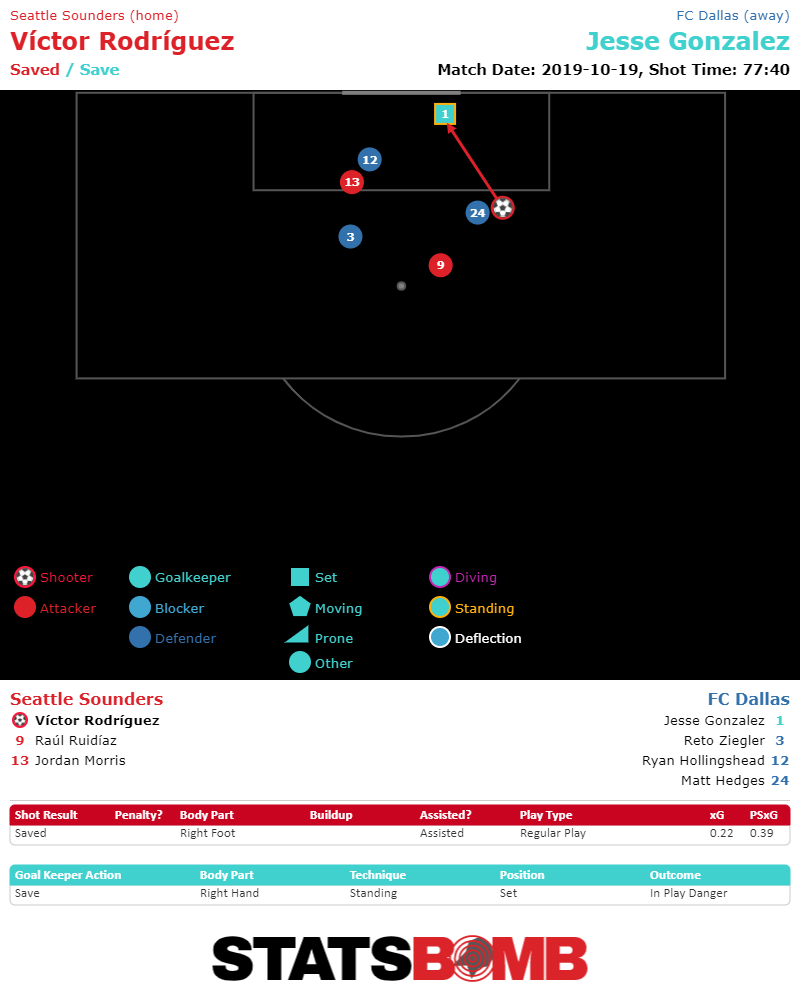 Then Raúl Ruidíaz had this shot blocked from point blank range.
Then Raúl Ruidíaz had this shot blocked from point blank range. 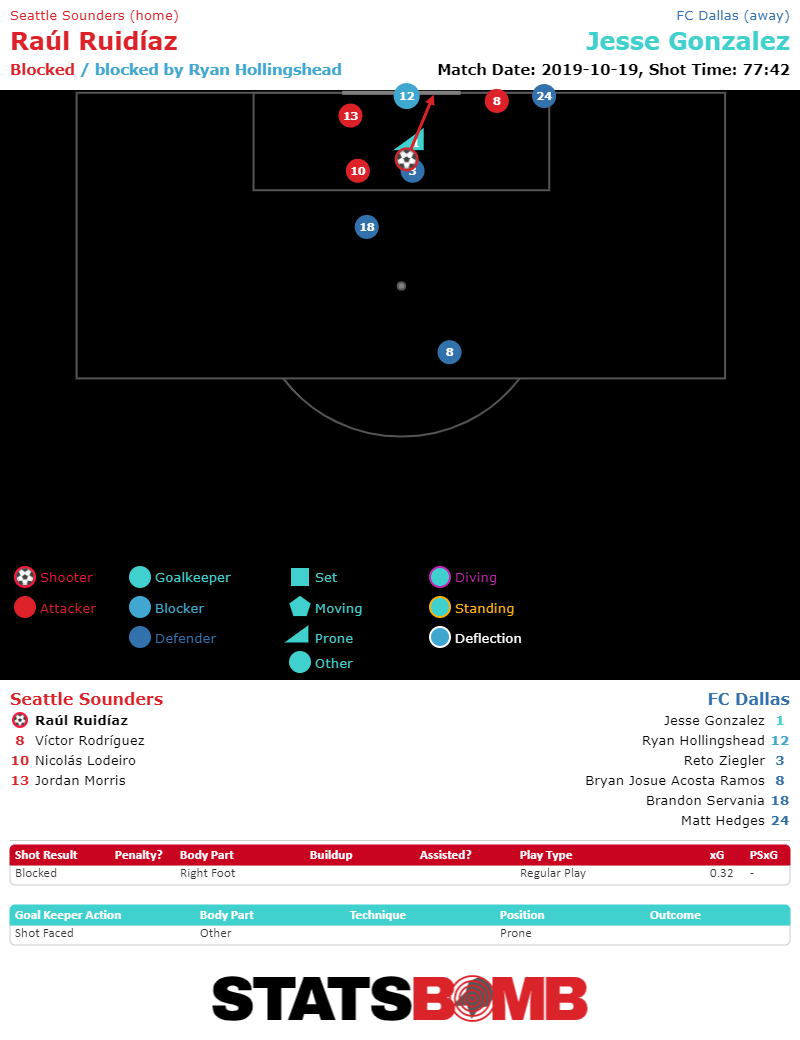 From that point on, Dallas had 11 shots, but not a single one, not even Bryan Acosta’s equalizer was worth even 0.10 xG. Even though the game was tied until late, from an xG perspective that span from 73-78 minutes is what sealed Seattle’s claim to having “played better” from an xG perspective. So, when watching the match I’d want to keep an eye on those chances and see if they were, in fact, as strong as xG believes they were, I’d also want to look at Dallas’s flurry of attempts and see if maybe xG was missing something, and if perhaps Dallas’s chances were more threatening than the calculations appeared to show. In a single game, and especially when looking at a single chance, the error bars around football analytics’ most fundamental building block can be big. Still, that overall xG gap is huge, and I’d expect to walk away from watching the match thinking that even if it wasn’t perfect, it more or less captured a real gap in the value of chances created by the two sides. However, that’s only the beginning of the story. Next, I’d want to look at the teams’ post-shot xG. That is, rather than the measure of the chances created, I want to look at a measure of the quality of the shots that the teams actually took. This is a less predictive measure of a team’s future performance, but it will more closely resemble the actions that took place on the pitch. There are good reasons to prefer xG to post-shot xG when analyzing a team, but given that what we’re trying to do here is both big picture analysis, and garner a small-picture understanding of what went on on the pitch (regardless of its predictive power for the future), it is helpful to look at both. And here something wild jumps out. Seattle’s post-shot xG of 2.92 is fairly in line with their standard xG, but Dallas has a crazy different total. Their post-shot xG is a massive 3.14, way above what their standard xG looks like. On average, Dallas might have created a lot less than Seattle did, but they did the absolute most with it.
From that point on, Dallas had 11 shots, but not a single one, not even Bryan Acosta’s equalizer was worth even 0.10 xG. Even though the game was tied until late, from an xG perspective that span from 73-78 minutes is what sealed Seattle’s claim to having “played better” from an xG perspective. So, when watching the match I’d want to keep an eye on those chances and see if they were, in fact, as strong as xG believes they were, I’d also want to look at Dallas’s flurry of attempts and see if maybe xG was missing something, and if perhaps Dallas’s chances were more threatening than the calculations appeared to show. In a single game, and especially when looking at a single chance, the error bars around football analytics’ most fundamental building block can be big. Still, that overall xG gap is huge, and I’d expect to walk away from watching the match thinking that even if it wasn’t perfect, it more or less captured a real gap in the value of chances created by the two sides. However, that’s only the beginning of the story. Next, I’d want to look at the teams’ post-shot xG. That is, rather than the measure of the chances created, I want to look at a measure of the quality of the shots that the teams actually took. This is a less predictive measure of a team’s future performance, but it will more closely resemble the actions that took place on the pitch. There are good reasons to prefer xG to post-shot xG when analyzing a team, but given that what we’re trying to do here is both big picture analysis, and garner a small-picture understanding of what went on on the pitch (regardless of its predictive power for the future), it is helpful to look at both. And here something wild jumps out. Seattle’s post-shot xG of 2.92 is fairly in line with their standard xG, but Dallas has a crazy different total. Their post-shot xG is a massive 3.14, way above what their standard xG looks like. On average, Dallas might have created a lot less than Seattle did, but they did the absolute most with it. 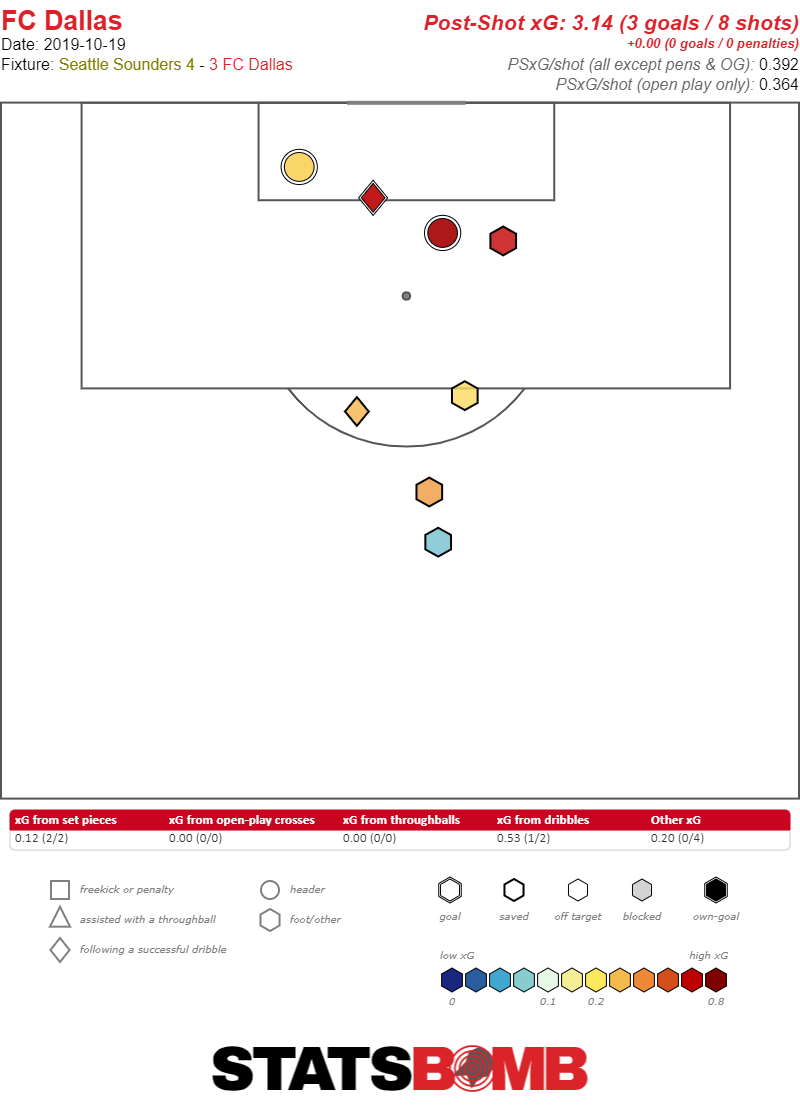 Matt Hedges 63rd minute header pops out as a gorgeously headed ball from the kind of chance that is rarely scored.
Matt Hedges 63rd minute header pops out as a gorgeously headed ball from the kind of chance that is rarely scored. 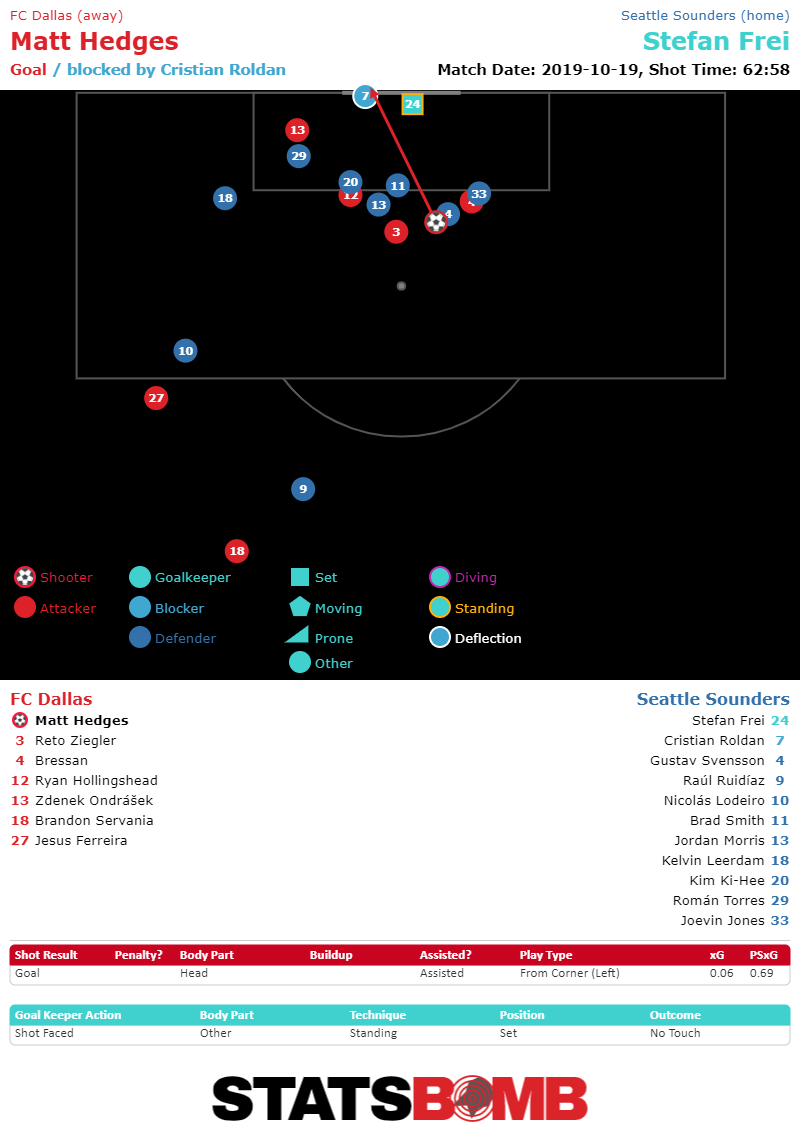 Paxton Pomykal's effort just before the final whistle is similarly notable.
Paxton Pomykal's effort just before the final whistle is similarly notable. 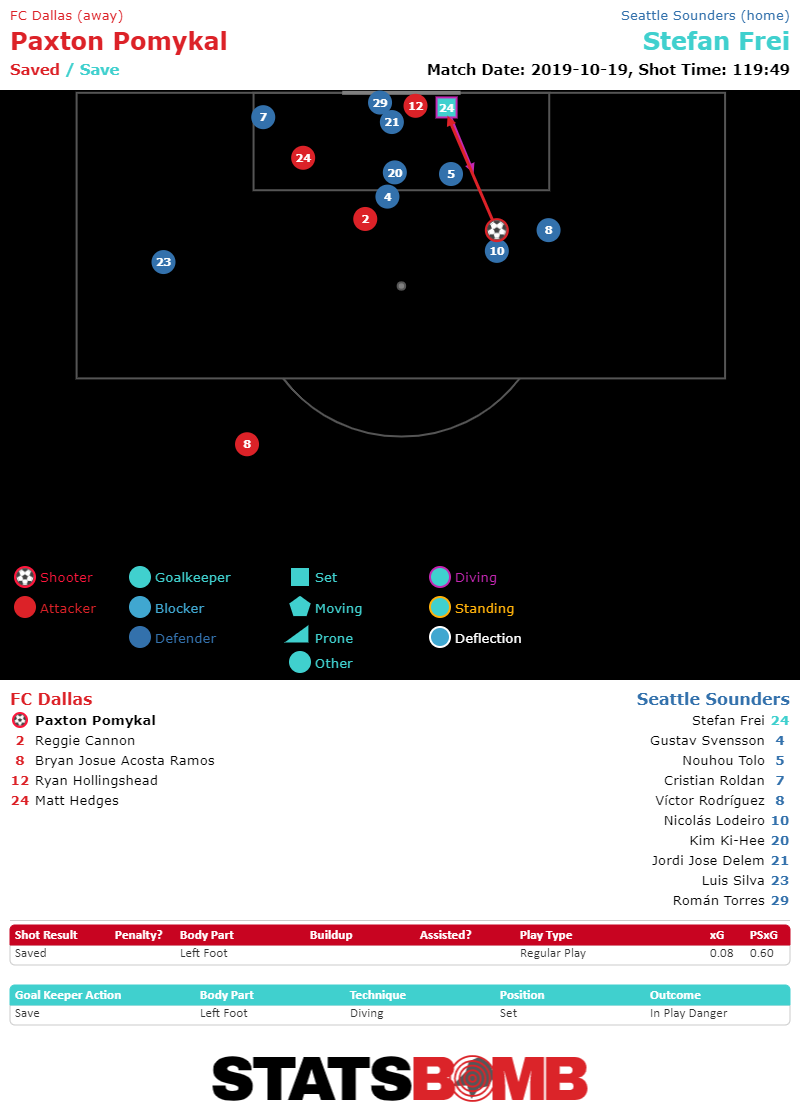 So, how do we reconcile those two numbers. Given the chances created we’d expect Seattle to win this match a lot, somewhere around 72% of the time. However, given what both teams did with those chances it’s reasonable to look at this match and think this easily could have fallen in the other 28%, and Dallas, given how well they struck the actual chances they created, were actually unlucky not to get a little bit more from this match. The analysis then when watching the match is examining that gap. Sometimes a team just hits the ball really well for 90 (or 120 minutes) and there’s not a lot to analyze, but other times there will be reasons that those specific chances appear to be better than xG understands. That’s a major question to answer when watching the match. And this is only looking at shots. You can repeat the same kind of analysis for passing and possessions. We know, for example, that Dallas had more of the ball, completing 568 passes to Seattle’s 457 and completing them at a higher rate, 81% to 77%. So, even before watching the match, the question becomes, if it’s true that Seattle created the better opportunities, why is it true? Were they doing something specific on the defensive side of the ball to foil Dallas’s ability to turn possession into good shots? Or was the problem one of Dallas’s own making? Or neither. Maybe Dallas simply got unlucky with a number of incisive move finishing passes just narrowly missing. Again, this is a specific area of the game to watch closely, determined by looking at numbers beforehand. After looking through the numbers I’d approach watching the game and determining who played better the following way. Going in I’d expect that Seattle would be pretty pleased with their performance. The fact that they walked out of the match with a pretty strong xG edge suggests that they did the kinds of things in this match that are repeatable match to match and week to week. The one major caveat I’d have is that I’d want to watch the defensive side of the ball closely to see if the divergence between Dallas’s xG and post-shot xG was due to mistakes they were making. Dallas, on the other hand, is a trickier question. The first thing I’d be looking for is their finishing. I’m looking for reasons that their post-shot xG diverged so heavily from their normal xG. There may not be any, it may be they just got hot and it almost bailed them out in a match were they were decidedly the worse team. On the other hand, it’s certainly possible that a handful of the shots they got off were, in fact, deceptively good attempts. The fact that, on average, xG evens out doesn’t mean that you can’t gain fleeting edges in a match (or have other teams gain fleeting edges against you) thanks to either smart tactical planning or winning individual matchups, or any one of the hundreds of things that go on in a soccer match. Of course, that stuff evens out over the long run, but we’re not analyzing the long run. Secondly, I’d want to watch Dallas’s possession in the final third. Determining whether they played well will rest heavily on figuring out why they managed to create so few shots that were actually highly valued by xG. Teasing out the answer to that question, and whether to blame Dallas, credit Seattle, or simply shrug and raise your hands to the soccer gods, will go a long way to determining exactly how highly to value Dallas’s performance. I admit that I’m skeptical that when I watch this match I’ll walk away thinking Dallas played better. I think that by far the most likely conclusion to draw is that Dallas’s somewhat sterile possession and hot shooting combined with Seattle missing a handful of good but not great chances to give the impression of a match that was much closer than it was. That’s not a definite conclusion though, it’s a hypothesis formed by data. Forming a strong hypothesis is important, but you also have to then go and test it. And that’s what watching the games is for.
So, how do we reconcile those two numbers. Given the chances created we’d expect Seattle to win this match a lot, somewhere around 72% of the time. However, given what both teams did with those chances it’s reasonable to look at this match and think this easily could have fallen in the other 28%, and Dallas, given how well they struck the actual chances they created, were actually unlucky not to get a little bit more from this match. The analysis then when watching the match is examining that gap. Sometimes a team just hits the ball really well for 90 (or 120 minutes) and there’s not a lot to analyze, but other times there will be reasons that those specific chances appear to be better than xG understands. That’s a major question to answer when watching the match. And this is only looking at shots. You can repeat the same kind of analysis for passing and possessions. We know, for example, that Dallas had more of the ball, completing 568 passes to Seattle’s 457 and completing them at a higher rate, 81% to 77%. So, even before watching the match, the question becomes, if it’s true that Seattle created the better opportunities, why is it true? Were they doing something specific on the defensive side of the ball to foil Dallas’s ability to turn possession into good shots? Or was the problem one of Dallas’s own making? Or neither. Maybe Dallas simply got unlucky with a number of incisive move finishing passes just narrowly missing. Again, this is a specific area of the game to watch closely, determined by looking at numbers beforehand. After looking through the numbers I’d approach watching the game and determining who played better the following way. Going in I’d expect that Seattle would be pretty pleased with their performance. The fact that they walked out of the match with a pretty strong xG edge suggests that they did the kinds of things in this match that are repeatable match to match and week to week. The one major caveat I’d have is that I’d want to watch the defensive side of the ball closely to see if the divergence between Dallas’s xG and post-shot xG was due to mistakes they were making. Dallas, on the other hand, is a trickier question. The first thing I’d be looking for is their finishing. I’m looking for reasons that their post-shot xG diverged so heavily from their normal xG. There may not be any, it may be they just got hot and it almost bailed them out in a match were they were decidedly the worse team. On the other hand, it’s certainly possible that a handful of the shots they got off were, in fact, deceptively good attempts. The fact that, on average, xG evens out doesn’t mean that you can’t gain fleeting edges in a match (or have other teams gain fleeting edges against you) thanks to either smart tactical planning or winning individual matchups, or any one of the hundreds of things that go on in a soccer match. Of course, that stuff evens out over the long run, but we’re not analyzing the long run. Secondly, I’d want to watch Dallas’s possession in the final third. Determining whether they played well will rest heavily on figuring out why they managed to create so few shots that were actually highly valued by xG. Teasing out the answer to that question, and whether to blame Dallas, credit Seattle, or simply shrug and raise your hands to the soccer gods, will go a long way to determining exactly how highly to value Dallas’s performance. I admit that I’m skeptical that when I watch this match I’ll walk away thinking Dallas played better. I think that by far the most likely conclusion to draw is that Dallas’s somewhat sterile possession and hot shooting combined with Seattle missing a handful of good but not great chances to give the impression of a match that was much closer than it was. That’s not a definite conclusion though, it’s a hypothesis formed by data. Forming a strong hypothesis is important, but you also have to then go and test it. And that’s what watching the games is for.
Does Sadio Mané have a shot at winning the Ballon d’Or?
With the 30-man shortlist revealed today, Sadio Mané is among the outsiders to be named the world’s best player this calendar year.
It takes one to know one, they say, so perhaps it made sense that Lionel Messi gave Sadio Mané his first vote for the FIFA World Player of the Year award last month. The Argentine eventually came out top, but if he plans to win the Ballon d’Or as well, he might want to hand his next vote to a less threatening rival.
Mané came fifth for the same award, but perhaps he should have been higher. Since the start of the year he has won the Champions League, helped Liverpool to a 97-point league finish and guided Senegal to the Africa Cup of Nations final, which his country lost 1-0 to Algeria despite leading the shot count 12-1. Arsène Wenger believes Mané should win the award.
The stats reflect a superb year for Mané so far. He takes few shots but lets rip from excellent positions. His open-play expected assists rate (xA) stands at 0.15 per 90 minutes. His number of pressure regains is solid and on the rise: this season Mané has been the forward with the sixth most pressure regains per 90 in the league (4.01).
Though Mané is a winger, the raids of Andrew Robertson down the left let him move into the box like a striker. Not only does Mané take up positions like a poacher, he finishes like one too.
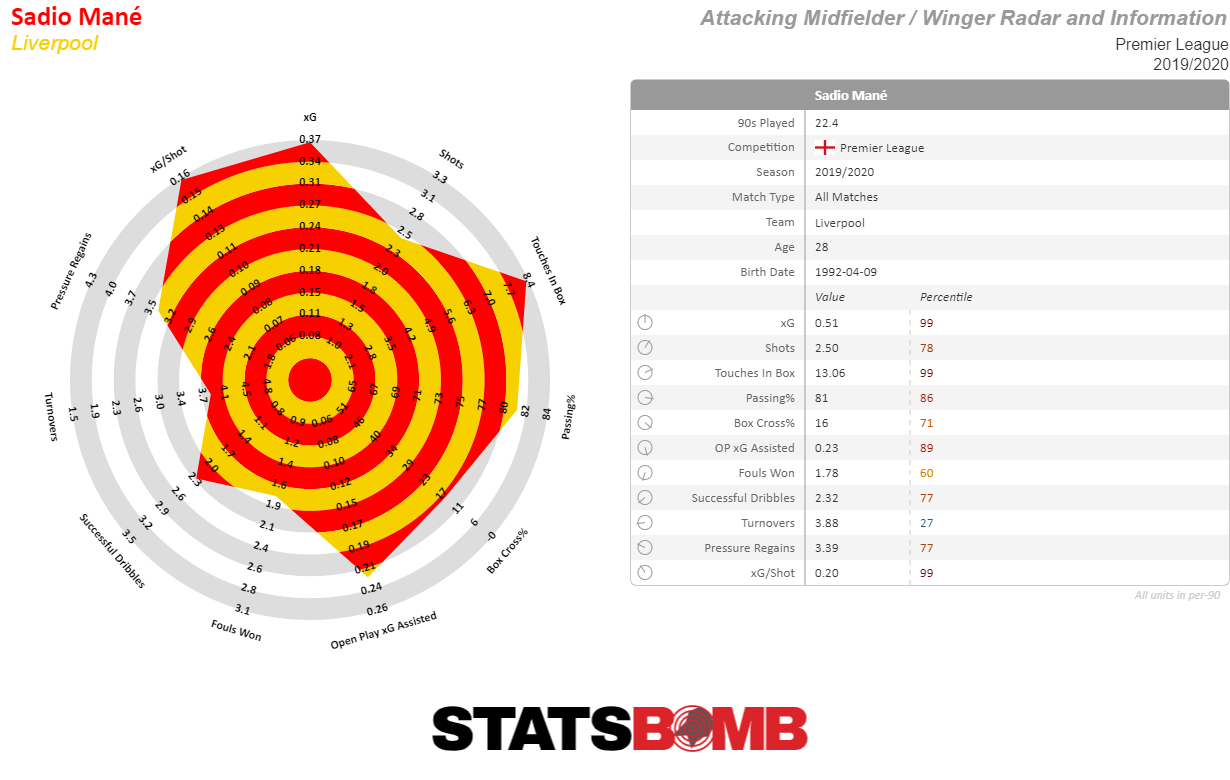
Along with the achievements of his two teams, do these stats give Mané a shout for the Ballon d’Or? Let’s compare him with the other candidates. Those who came ahead of him for the FIFA award were Messi, Virgil van Dijk, Cristiano Ronaldo and Mohamed Salah. But a couple of the players who came just behind Mané might pose a threat too.
The outsiders
A cluster of three players got just a few votes fewer than Mané. One was Frenkie de Jong, but considering Mané won the Champions League, the Dutch playmaker should have a hard time getting ahead of him. Another was Eden Hazard, yet as good as he was in the Premier League last season, Mané has done more in the cups, and a thigh injury has married the Belgian’s start to life in Spain.
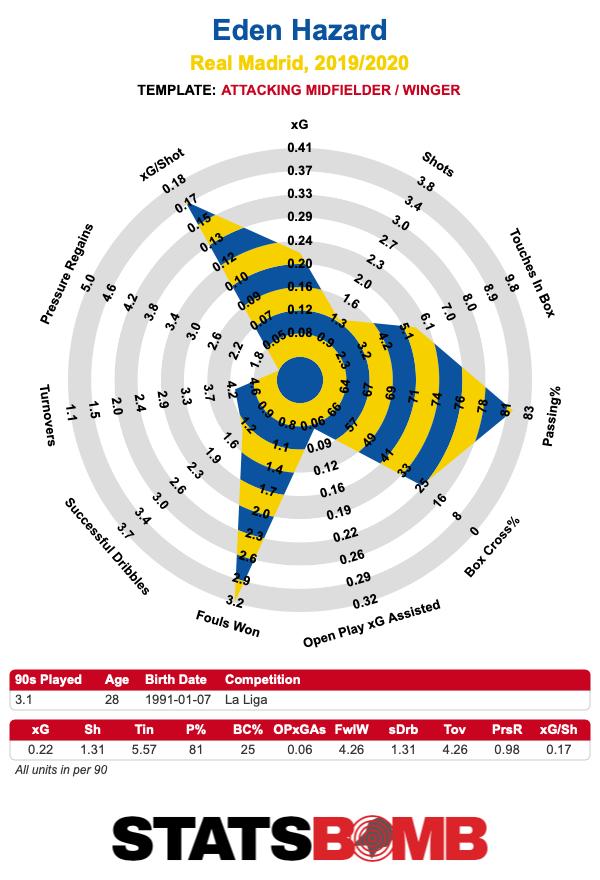
The third is Kylian Mbappé, and here Mané can only beat him on his Africa Cup of Nations displays, the stronger reputation of the Premier League and Paris Saint-Germain’s debacle in the Champions League. As a striker, it doesn’t get much better than this.

Yet collective trophies matter, and so Mané will most likely face a bigger challenge from his two teammates as well as Messi and Cristiano. Let’s begin with fourth place.
The favourites
Just ahead of Mané came Salah, with three votes more. That denotes a close race, yet the stats say Mané should prevail. Whereas Salah takes more shots, Mané selects his attempts better and has a higher expected goals rate (xG) per 90. Most of the other key metrics favour Mané as well: his passing is more accurate, his xA from open play is higher, he loses the ball less often and he presses more efficiently.

After Salah there’s a big gap up to the top three. Third is Cristiano, and again you can make the argument that Mané has been better. Like Salah, Cristiano beats him on shot volume, but Mané comes out top for expected goal involvements and work rate. (You could argue that Cristiano plays more as a striker, though his radar for that position does him no favours here.)

It is also worth highlighting their finishing. Whereas Mané has scored 19 non-penalty goals from an xG of 11.83, Cristiano has nine non-penalty goals from a slightly lower xG. Cristiano won the UEFA Nations League, but Mané became European club champion. Throw in the Africa Cup of Nations and Mané has a strong case.
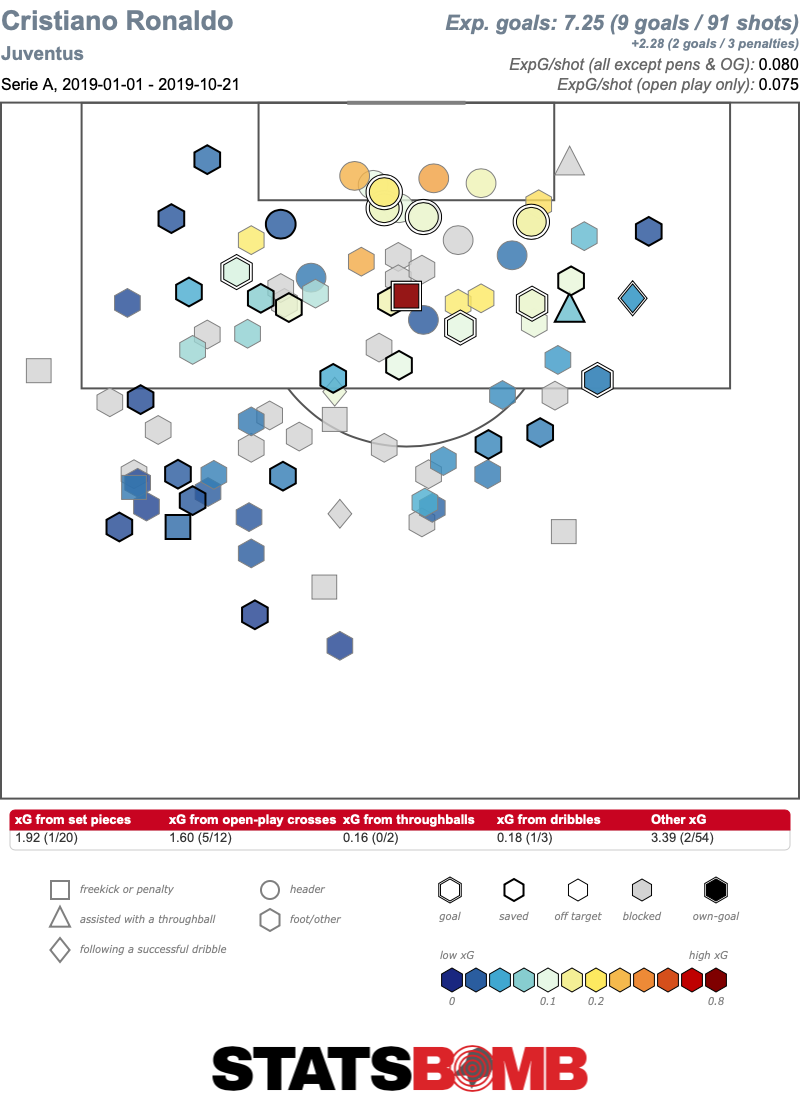
All of which leads us to second place. Here we find Van Dijk, which hands us a tricky comparison between a winger and a centre back. The Dutchman might have the upper hand: he won the UEFA Player of the Year award in late August and, looking at his stats, it is hard to say what more he could have done.
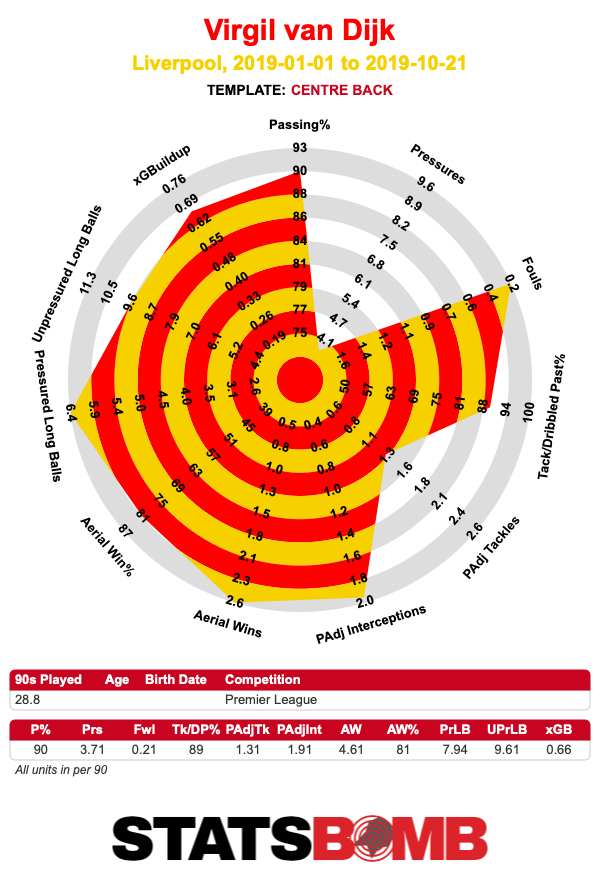
Then comes the king, Messi, who won the FIFA award by a clear margin. Mané has a better shot selection, works harder and loses the ball less often. Beyond that, it’s not really a contest.

But wait. Did Mané not outperform Messi in the Champions League? We remember that Messi supposedly played badly when Barcelona lost 4-0 at Anfield. Do the stats reflect this? Well… no.

The forgotten one
And so while Messi remains Messi, Mané does compare favourably to most of the candidates for the Ballon d’Or.
But have we not forgotten someone?
When the shortlist for the FIFA award came out, Pep Guardiola said he thought no player had had a better season than Bernardo Silva. Yet another City player who got little mention was Raheem Sterling. He was not among the 10 nominees for the award, a call that can only have been based on City’s travails in the Champions League. Compared to Mané, Sterling has been better since the start of the year.

One can only hope Sterling gets more recognition when the Ballon d’Or voting gets underway. Whether he’ll beat Mané is doubtful, however, given the weight the biggest cup titles carry. Mané has been Liverpool’s best attacker this year and, while he’s unlikely to win the Ballon d’Or, a spot among the top three would be well deserved.
Header image courtesy of the Press Association
Ipswich are good, Portsmouth may not be bad, and other early League One storylines
League One Early Storylines This is an unusual iteration of a League One season, a bit of a one-off. We have only 23 teams rather than 24 with Bury unable to avoid expulsion, whilst Bolton survived expulsion but couldn’t avoid a points deduction - they still remain on negative points ten games in. There’s more than one pre-season title favourite that are “dumpster fire” rather than “on fire” and a few fervent underdogs have been happy to replace them in the promotion pack. We’ll touch on pretty much all of those. Welcome to League One Storylines. A caveat – any data used in this article has had fixtures against Bolton stripped out of it due to their fielding of youth team players in the opening weeks of the season. Sorry Wycombe, Coventry, Tranmere, Ipswich, Gillingham, and Rotherham fans but we do not condone the bullying of children here at StatsBomb and will not allow you to reap the padded shot numbers due to that.
Ipswich rev their engines
You probably won’t be used to hearing of Tractor Boys being the quickest out of the blocks unless you’re a fan of Hungarian Tractor Drag Racing but nevertheless that’s where we find ourselves with Ipswich, outright leaders through 11 games and with an 8-3-0 return giving them a four point and game-in-hand lead on second place already. Paul Lambert has them operating a tight tractor ship and for a team that’s conceded just five goals and kept seven clean sheets in 11 games, the old clichéd ‘miserly defence’ is a deserved anointment. We’d be doing them a disservice if we were to just use expected goals when looking under the hood of this well-oiled piece of farming machinery. Their current goal difference (again, excluding their 5-0 thumping of Bolton’s kids) comes in at +11, whilst their expected goal difference, based on the quality of chances they’ve been creating and conceding, comes in at +2.50, with the overperformance shared out both between their forwards finishing well and their defence conceding below the rate expected. 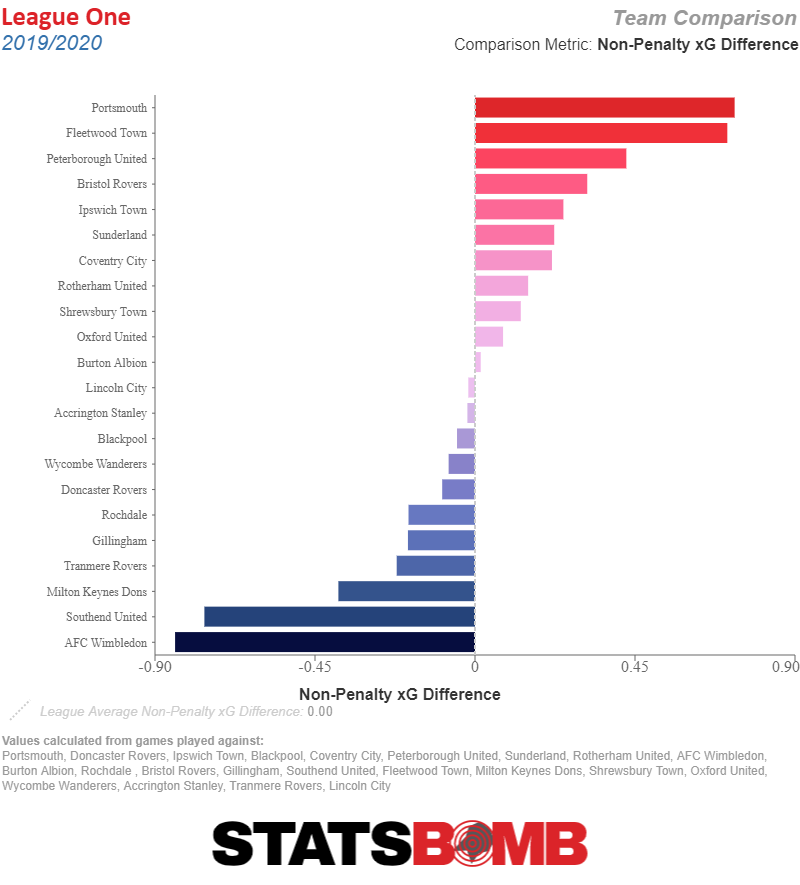 Their underlying numbers may not be as strong as their results but it’s important to note that they’ve been in the lead in games for a longer time than anyone else in League One so far, spending ~55% of their matches in front. With the team ahead for such a long time, it’s definitely fair to assume they’ve been more focused on defending their lead and their opponents more focused on seeking an equaliser, which could easily be applying a skew to Ipswich’s numbers. With that in mind, you might expect their opponents to have been raining shots on the Tractor Boys’ goal. That's not the case though. Ipswich have conceded just 9.50 shots per game, a figure that ranks third best in the league, and the best examples of their stinginess have come in games against potential promotion rivals in Sunderland and Fleetwood. In what are undoubtedly two of the tougher fixtures Ipswich will face this season, they conceded a total of nine shots combined and just one of those hit the target, with the single shot on target across the two games being Sunderland’s equaliser, unfortunately for Ipswich. To conclude, Ipswich are good, particularly defensively. Good luck to the rest of League One breaking down that down.
Their underlying numbers may not be as strong as their results but it’s important to note that they’ve been in the lead in games for a longer time than anyone else in League One so far, spending ~55% of their matches in front. With the team ahead for such a long time, it’s definitely fair to assume they’ve been more focused on defending their lead and their opponents more focused on seeking an equaliser, which could easily be applying a skew to Ipswich’s numbers. With that in mind, you might expect their opponents to have been raining shots on the Tractor Boys’ goal. That's not the case though. Ipswich have conceded just 9.50 shots per game, a figure that ranks third best in the league, and the best examples of their stinginess have come in games against potential promotion rivals in Sunderland and Fleetwood. In what are undoubtedly two of the tougher fixtures Ipswich will face this season, they conceded a total of nine shots combined and just one of those hit the target, with the single shot on target across the two games being Sunderland’s equaliser, unfortunately for Ipswich. To conclude, Ipswich are good, particularly defensively. Good luck to the rest of League One breaking down that down.
Same old at Sunderland
Speaking of Sunderland, what they’d do to be in Ipswich’s position having failed to make an instant return to the Championship last season. With promotion very much still the aim this time around, the Black Cats have again found themselves struggling to impose themselves on the division. A return of 5-4-2 for 19 points from their 11 fixtures this season may not sound too bad, but the same old issues within the side haven’t been addressed and patience with manager Jack Ross finally ran out. He was sacked last week. Those same old issues? The absence of any creative or incisive patterns of play in the attacking third. Their build-up was slow and predictable to defend against, consistently playing with the handbrake on. The side generated just 10.50 shots per game, ranking them in the bottom four against their league rivals, and that just isn’t good enough for a promotion contender. Last season’s protestations that teams would come and sit deep against Sunderland were less true this time around and the Black Cats were arguably their own worst enemies in this aspect anyway, refusing to transition quickly when the opposition defence was unsettled and left gaps to play through. To date Sunderland have created a league-lowest four(!) shots on the counter attack, a metric which they were also bottom of last season too. 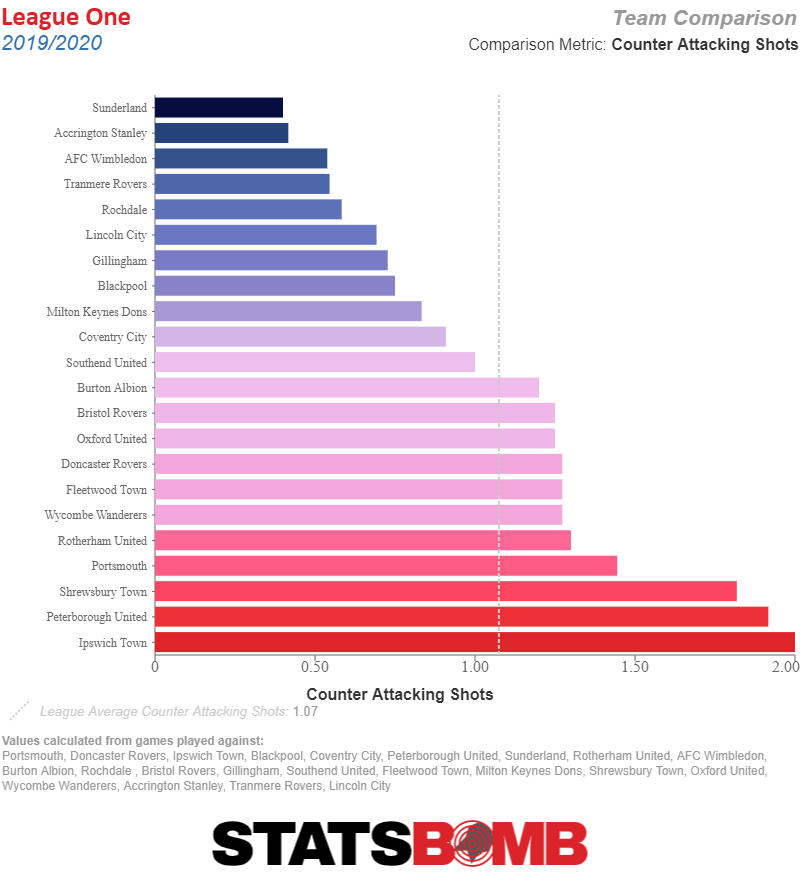 If you’re not going to counter attack as a team, perhaps you might try other ways to unsettle the opposition and create decent opportunities for your side – winning the ball high up the pitch and looking to get shots off before the opponent could set themselves again maybe? Not Sunderland, they’re bottom for High Press shots too (shots generated within 5 seconds of a defensive action in the opposition half).
If you’re not going to counter attack as a team, perhaps you might try other ways to unsettle the opposition and create decent opportunities for your side – winning the ball high up the pitch and looking to get shots off before the opponent could set themselves again maybe? Not Sunderland, they’re bottom for High Press shots too (shots generated within 5 seconds of a defensive action in the opposition half). 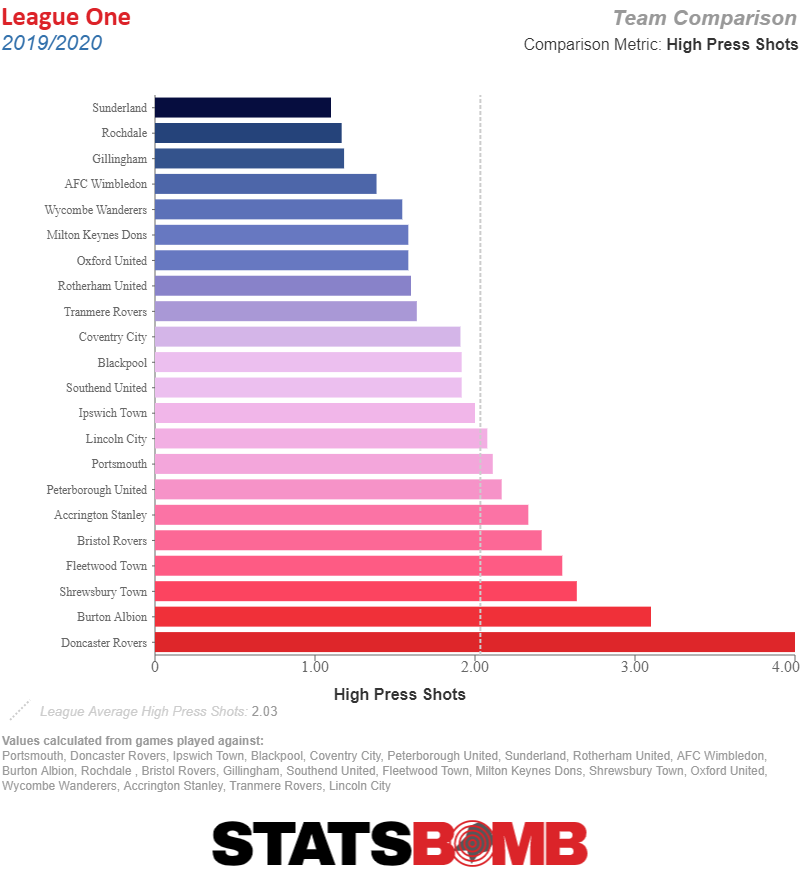 Whilst the attack was failing, a rock solid defence wasn’t bailing them out either with the team yet to keep a clean sheet this campaign. There’s plenty to improve on for the next incumbent of the Sunderland hot seat.
Whilst the attack was failing, a rock solid defence wasn’t bailing them out either with the team yet to keep a clean sheet this campaign. There’s plenty to improve on for the next incumbent of the Sunderland hot seat.
Drilling into Wycombe’s fine start
Here we have ourselves the proverbial surprise package. Operating on one of the tightest budgets in League One, to see the Chairboys dethroning much bigger playing budgets to sit in second place in mid-October has brought a few observers and plenty of fans to the edge of their seat. Having steered Wycombe on an upward trajectory for consecutive seasons now, it should be of no surprise that interest is beginning to be tabled in manager Gareth Ainsworth (including from Sunderland). The main question to ask about this Wycombe side is a straightforward one: can they keep it going? *pulls out giant drawing pin and takes aim at Wycombe-shaped bubble* In a word, no. At least not in their current state. Strip out the game vs Bolton’s youth team and the fact their goalscoring numbers are bumped further by having the most penalties in the league and the most opposition own goals scored for them and Wycombe start to look somewhat more ordinary - which, lest we forget, would still represent an overachievement on their resources. When lacking the resources to acquire individual quality it helps to be a well-coached unit and in that regard they most certainly are, possessing a varied attacking threat. They’re capable of going long and direct to man-mountain Adebayo Akinfenwa or countering at pace down the wings, whilst also creating regularly and frequently at set plays. 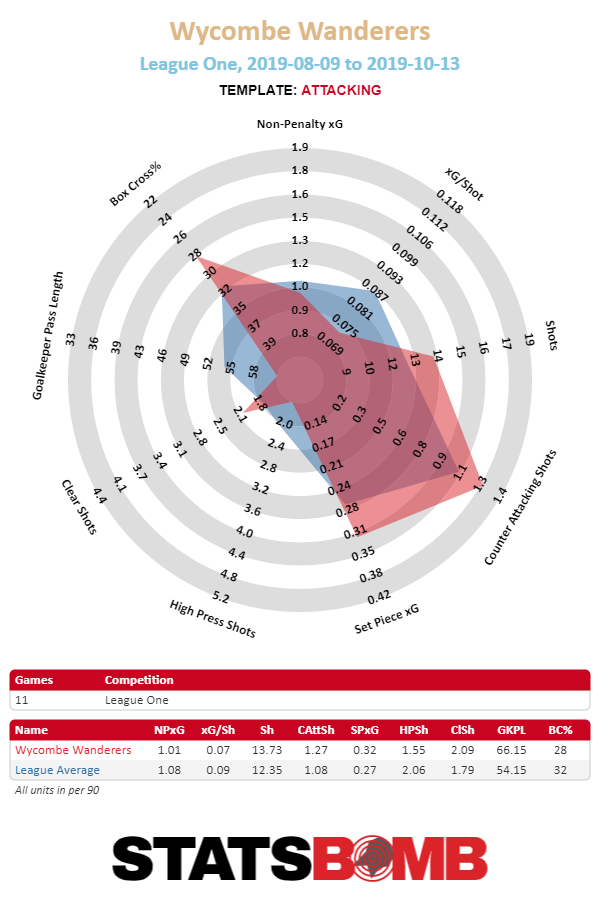 Finishing in the play-offs would be a highly commendable achievement for Ainsworth’s men. It’s just we shouldn’t expect that of them just yet.
Finishing in the play-offs would be a highly commendable achievement for Ainsworth’s men. It’s just we shouldn’t expect that of them just yet.
How do you explain a start like Portsmouth’s?
Speak to fans of the South Coast club and you’d do well to find one pleased with how things are going so far. With the pre-season title favourites in 16th place, manager Kenny Jackett is bearing the brunt of the blame after getting off to a slow start. Losing Matt Clarke and Jamal Lowe in the summer was undoubtedly a blow but the feeling was they’d been replaced adequately enough to make an improvement on last season’s play-off finish. Right now, they’re not even in the top half. There’s a few oddities to unpack when going deeper into where they’ve struggled because looking solely at their underlying numbers would suggest that there’s very little wrong with the process in place. Their expected goal difference, based on the quality of chances they’ve created and conceded, is +0.73 per game, a league-high, but their actual goal difference diverges greatly: -0.33 goals per game once penalties have been stripped out. We’ll start at the back and the first conclusion we can draw is that defensively they’re solid enough and there’s little wrong with the process in that regard. Portsmouth give away the fewest shots in the league (9.00 per game) and the quality of those shots is also the lowest in the league (0.06 xG/shot). If Portsmouth aren’t giving much away in terms of goalscoring chances, then their issue comes down to the fact that their opposition aren’t having to do much to score, an issue that is no more apparent than when looking at the shots they’ve conceded when in winning positions. Looking squarely at the shot map, it’s fair to say they’ve suffered a bit as their opponents have just finished their chances to equalise at an above-average rate. 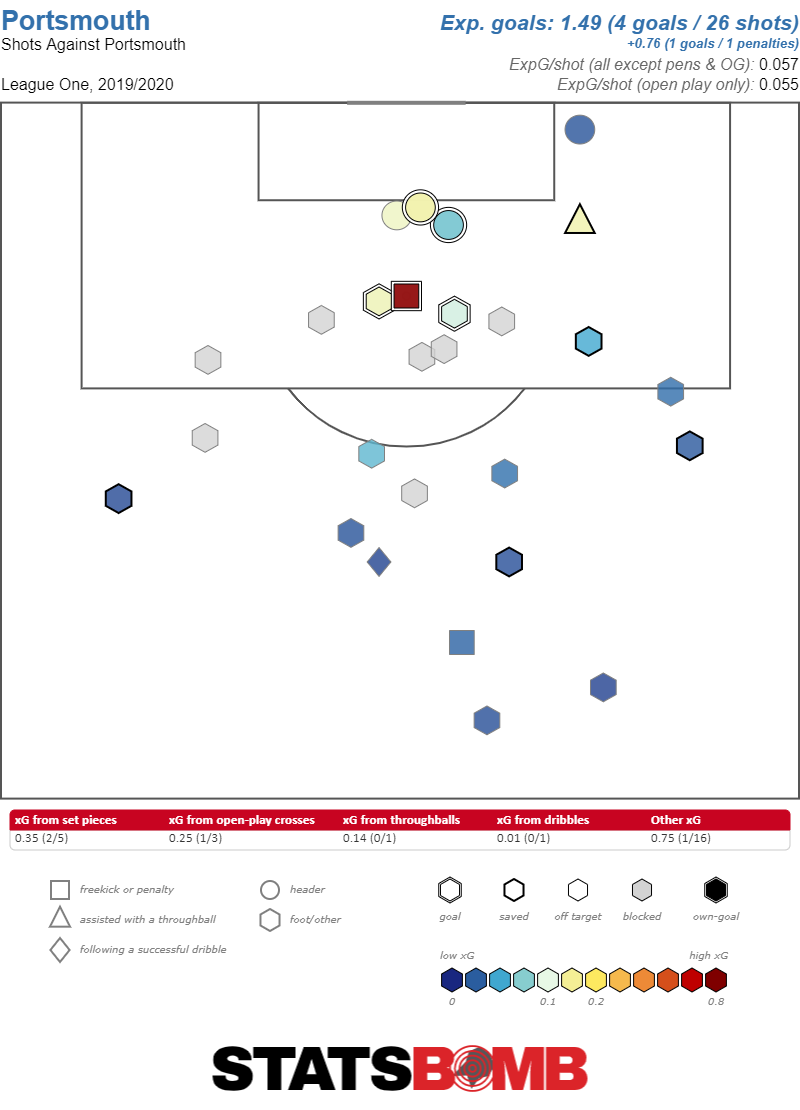 It’s not only when Pompey are ahead that their opponents have been finishing their chances well though. Burton Albion turned up at Fratton Park in mid-September and promptly scored their first two shots of the game, one of which was heavily deflected, to put Portsmouth 2-0 down and on the back foot six minutes in. Likewise Shrewsbury on the opening day turned what was a very robust defensive performance from Portsmouth (they conceded 3 shots all game) into an uninspiring defeat thanks to a 30 yard Ryan Giles rocket.
It’s not only when Pompey are ahead that their opponents have been finishing their chances well though. Burton Albion turned up at Fratton Park in mid-September and promptly scored their first two shots of the game, one of which was heavily deflected, to put Portsmouth 2-0 down and on the back foot six minutes in. Likewise Shrewsbury on the opening day turned what was a very robust defensive performance from Portsmouth (they conceded 3 shots all game) into an uninspiring defeat thanks to a 30 yard Ryan Giles rocket. 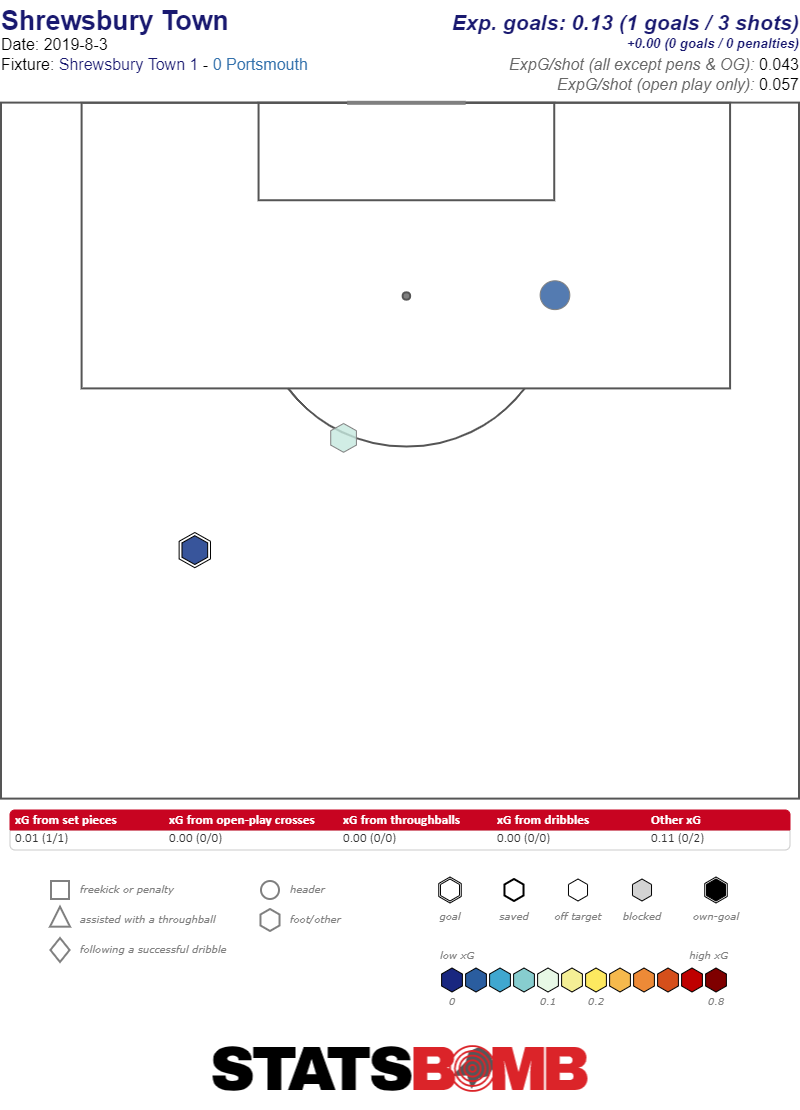 That’s not to say the story is solely one of hard luck. Arguments that Jackett is too wedded to his sit-deep-and-counter system that can leave them inflexible at times and unable to adapt to the game situation they find themselves in are definitely fair. If the opposition aren’t going to be drawn out, as will often be the case particularly in Pompey’s home games, then they tend to struggle to create enough and the amount of rotation that’s been made in the shape and personnel of Pompey’s frontline this season suggests that Jackett isn’t exactly pleased with what he’s seeing either. It’s true to say that there isn’t too much wrong with what Portsmouth are doing so far, but it’s also true that certain things do need tuning up if they’re to push on towards the top end. Being a full 14 points behind Ipswich likely means the title is already beyond their reach but Pompey could achieve their promotion aims yet with the aid of a few tweaks to the system. Jackett remaining in charge long enough to implement them though will depend on a pretty immediate uptick in short term results.
That’s not to say the story is solely one of hard luck. Arguments that Jackett is too wedded to his sit-deep-and-counter system that can leave them inflexible at times and unable to adapt to the game situation they find themselves in are definitely fair. If the opposition aren’t going to be drawn out, as will often be the case particularly in Pompey’s home games, then they tend to struggle to create enough and the amount of rotation that’s been made in the shape and personnel of Pompey’s frontline this season suggests that Jackett isn’t exactly pleased with what he’s seeing either. It’s true to say that there isn’t too much wrong with what Portsmouth are doing so far, but it’s also true that certain things do need tuning up if they’re to push on towards the top end. Being a full 14 points behind Ipswich likely means the title is already beyond their reach but Pompey could achieve their promotion aims yet with the aid of a few tweaks to the system. Jackett remaining in charge long enough to implement them though will depend on a pretty immediate uptick in short term results.
Juan Cuadrado and Takehiro Tomiyasu are thriving in Serie A as unconventional fullbacks
Finding high caliber fullbacks on the market is becoming increasingly complicated and major European teams are systematically forced to overpay for their wide defenders.
At the same time, one of the most important tactical trends sees fullbacks playing an increasingly important role in build-up and progression of the ball, as most teams tend to remain compact at the center and adopt strategies to limit the influence of central midfielders in the game.
Serie A is no exception Fullbacks like Dani Alves during his two-year spell at Juventus, Aleksandar Kolarov for AS Roma, João Cancelo for Inter first and then for Juventus last season, have had an increasing influence as a source of play for their team.
But the number of fullbacks that can play such an important role in large areas while also holding their own on the defensive side of the ball is limited and coaches are often adopting creative solutions, trying out players who normally play other roles as fullbacks.
In this first phase of the 2019/20 Serie A season, two players in particular are having success in their new full-back role: Juan Cuadrado and Takehiro Tomiyasu.
Juan Cuadrado
A big part of the credit for Juventus going to Milan and walking away with a win against Inter, as well as sole possession of first place in the table is also due to many players whose future seemed to be far from Turin this summer.
According to the newspapers, Blaise Matuidi and Sami Khedira seemed to be almost a burden to get rid of, while now they are starters in Maurizio Sarri's midfield at the expense of the new acquisition Adrien Rabiot. Paulo Dybala and Gonzalo Higuaín were ready to be sold to the first bidder, but they scored the two decisive goals against Antonio Conte's team. Finally, and perhaps even more surprisingly, winger Juan Cuadrado is now shining in a new role for him.
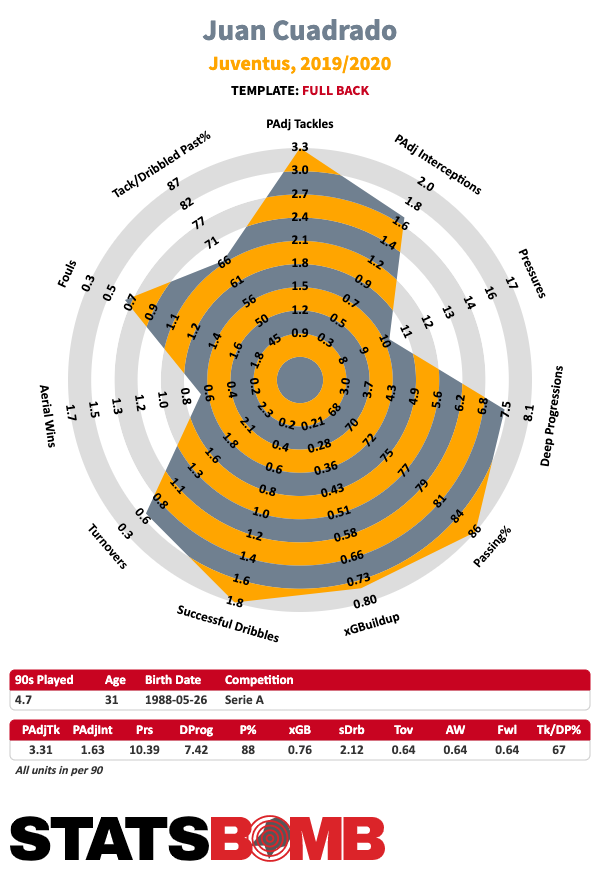
Due to the injuries of Mattia De Sciglio and Danilo, Sarri found himself without a right back already on matchday five and so the ex-Napoli’s manager, considering the options available, chose to employ the Colombian, after a decisive performance in the Champions League match against Atlético Madrid, where he scored the first goal, from the right outside of the defense.
Cuadrado has enthusiastically taken on his new tasks and has also benefited from the help of his former teammate Andrea Barzagli, now on Sarri’s coaching staff. “I am very happy. From the start when talking to the coach, I tried to change my mentality and be fully concentrated, as I know that I can do better, but Barzagli is on me constantly, so I can’t relax for a second!” he said after playing their again in a Champions League win against Bayer Leverkusen.
Among Juve players with at least 360 minutes played in the league, Miralem Pjanic is the only one who has completed more deep progressions (10.66 per 90 minutes) than Cuadrado (7.42 per 90). The Colombian is 13th in the league in volume of open play passes per 90 among players with at least 300 minutes and given that is XGBuildup of 0.76 is roughly the same as the Pjanic’s 0.79 it suggests he is as important as the Bosnian to Juventus’s possession game.
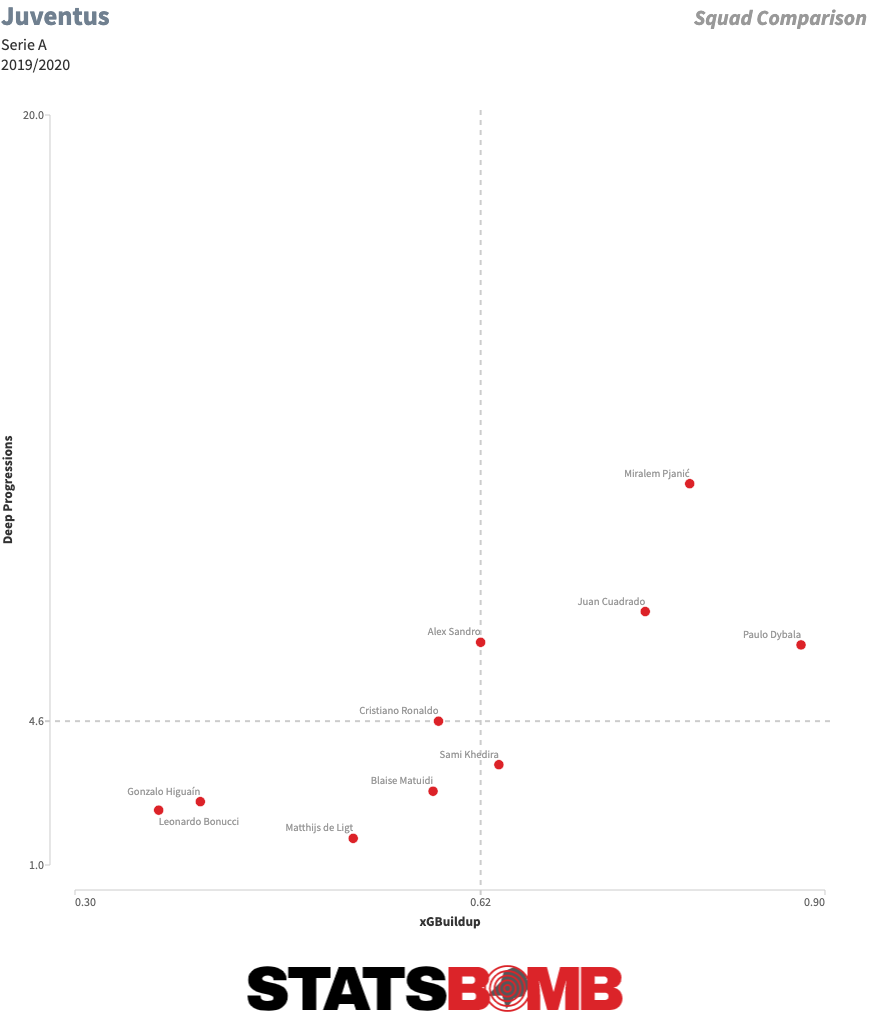
At 31 years old, Cuadrado is a mature footballer in terms of decision-making (he committed a single turnover in his last three games as a fullback) and his composure in build-up (his passing percentage is the same whether pressured or not) is vital for Sarri, who can always count on an alternative source of play when progressing centrally gets difficult.
In addition to his relevance in build-up, Cuadrado can be also used as an offensive tool to dismantle opposing lines, thanks to his ability to carry the ball and win offensive duels: even as a fullback he does not miss the opportunity to beat his direct opponent in dribbling. He completes 2.12 dribbles per 90 and against Inter, in what was perhaps his best match, he completed four, equally distributed between the two halves of the field.
What is surprising, however, is his defensive contribution. While it is true that his tackles per dribbled by rate of 66% is not an exceptional figure, it is still better than that of Alex Sandro (60%), the only other fullback who played significant minutes, and he is also able to contribute with 3.31 possession adjusted tackles per 90 average, an elite number. Cuadrado showed he could read the game and understand when to leave the defensive line to try to anticipate the opponent much better than other fullbacks. In August he looked like a footballer ready to leave, now he's a key element of the starting eleven.
Takehiro Tomiyasu
In my column about early Serie A trends, I highlighted Bologna as the best team after the first four games, at least as far as expected goals is concerned. I also highlighted how their early schedule could have inflated their numbers and indeed in the three games following my piece they managed to collect only two points. However, despite a negative non-penalty goals difference (-0.43) the Rossoblu have still the best xG difference in the league (+1.13).
The good performances so far are the result of the excellent work and resilience of the manager Sinisa Mihajlovic and the ambitious transfer campaign carried out by the club during the summer. Of all the players who arrived, however, the most brilliant surprise is that of Takehiro Tomiyasu, a 20-year-old Japanese defender who came from Saint-Truiden.
In 2018-19 at Saint-Truiden, Tomiyasu played 26 out of 27 games in the league as a centre back, but he is still able to perform as right back with excellent results, so much so that he has played all his games so far and 100% of the minutes of Bologna, in this position. Despite being quite lean and 1.88 m tall, he's fast and this helps him a lot when he plays on the flank.
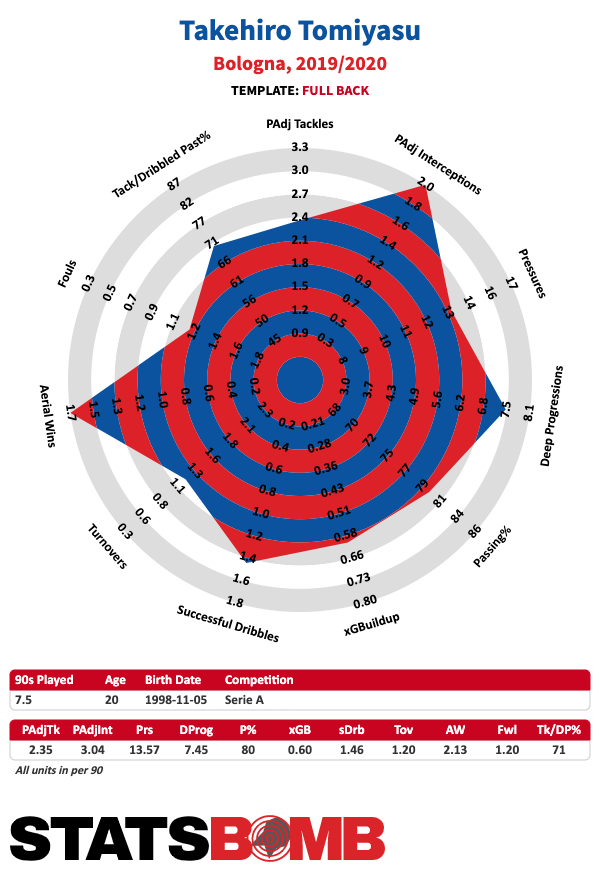
He is definitely a footballer whose anticipation and ability to read the game is his greatest strength as a defender and has proven it with exceptional results. He’s also dominant in the air (2.13 aerial wins per 90), winning not just a high quantity of aerial duels, but a high proportion of them as well (62% of success). Centre back Stefano Denswil is his only teammate who wins more aerial duels and with a higher success rate (3.10 and 71%).
Tomiyasu is also the player from Bologna who has completed the highest number of interceptions, 2.13 per 90, adjusting for possession. In addition, his 71% tackles per dribbled past rate is the highest of the team, while only centerback Mattia Bani does better than him in combined raw tackles and interceptions (3.73 per 90).
What is surprising is his personality with the ball at his feet, a trait that made him immediately become a central element in Bologna’s tactical plans. In fact, along with midfielder Gary Medel, he is the player who plays the most open play passes (52.44 per 90). His ability to move the ball forward has made him pretty much indispensable for Bologna. He has the highest average value of deep progressions of the team (7.45, 4th in the league among players with at least 600 minutes played) and between the Rossoblu is also the player who performs more carries (45.91 per 90). The Japanese fullback is the second-best dribbler of the team behind Riccardo Orsolini if we consider the volume of successful dribbles (1.46 per 90), too.
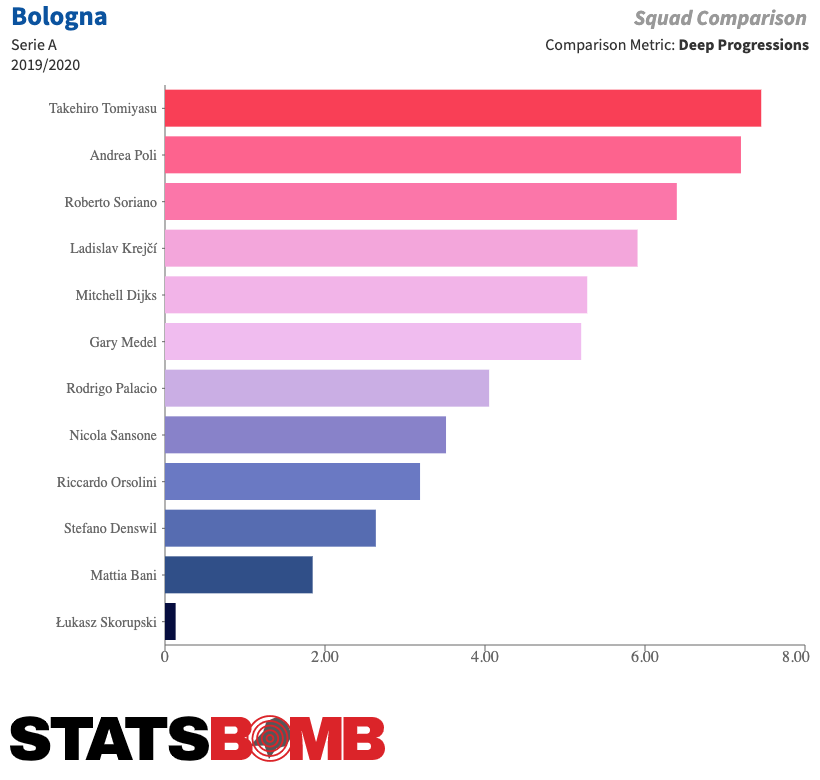
So far Tomiyasu has not been accurate when it comes to crossing, since he has completed only 11% of his total crosses, nor incisive in creating opportunities for teammates, since his xG assisted is almost nil (0.02 per 90). Yet he is always involved, even in the last third of the field where he completes as many passes as his teammates who play as wingers (about 16 per 90), and even though he rarely plays the last pass, he is still instrumental in the dangerous situations created by Bologna.
He is sixth in the league in xG build up per 90 minutes (0.60) among players with at least 600 minutes played, in practice the same value as Kolarov (0.59), who plays an equally important role as fullback in AS Roma’s system. Compared to the Serbian, whose passing game is not influenced by opposing pressure, he still has to improve in tighter situations, since when pressured his success rate in passes drops by 21%.
At the early age of 20, he is already one of the most reliable fullbacks in the Serie A and his game has all the characteristics of the modern defender. In a team of higher level with more offensive fullbacks, he could even be moved back to the center of the defense. Bologna purchased him seven million euros, a figure that could be more than doubled at the time of his next transfer.
Header image courtesy of the Press Association
StatsBomb Conference: Research Papers
A great time was had by all at the first StatsBomb Conference held at Stamford Bridge on Friday 11th October.
The two rooms were frequently packed to enjoy presentations that ranged from experienced sports practitioners through to enthusiastic amateurs. The standard was extremely high throughout. As part of the event the research room saw seven presentations from groups and individuals who had been supplied with StatsBomb Data with a view to creating original research.
The papers devised are available here (click the links to download the pdfs), and videos of the presentations are available via our youtube channel. Enjoy! Tom Decroos, Jesse Davis - Interpretable Prediction of Goals in Soccer
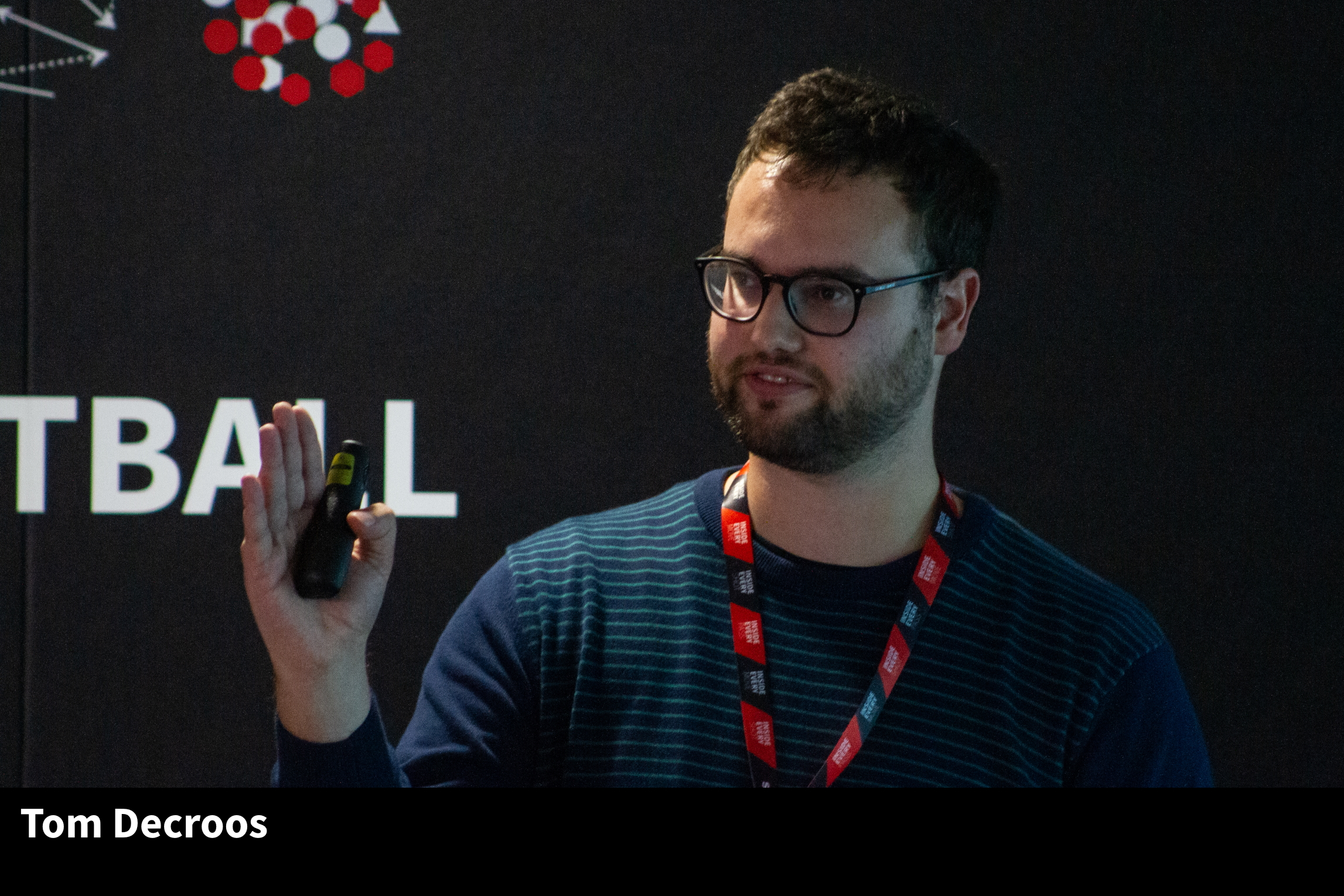 Estefania Vidal - Entry Zones in Football
Estefania Vidal - Entry Zones in Football
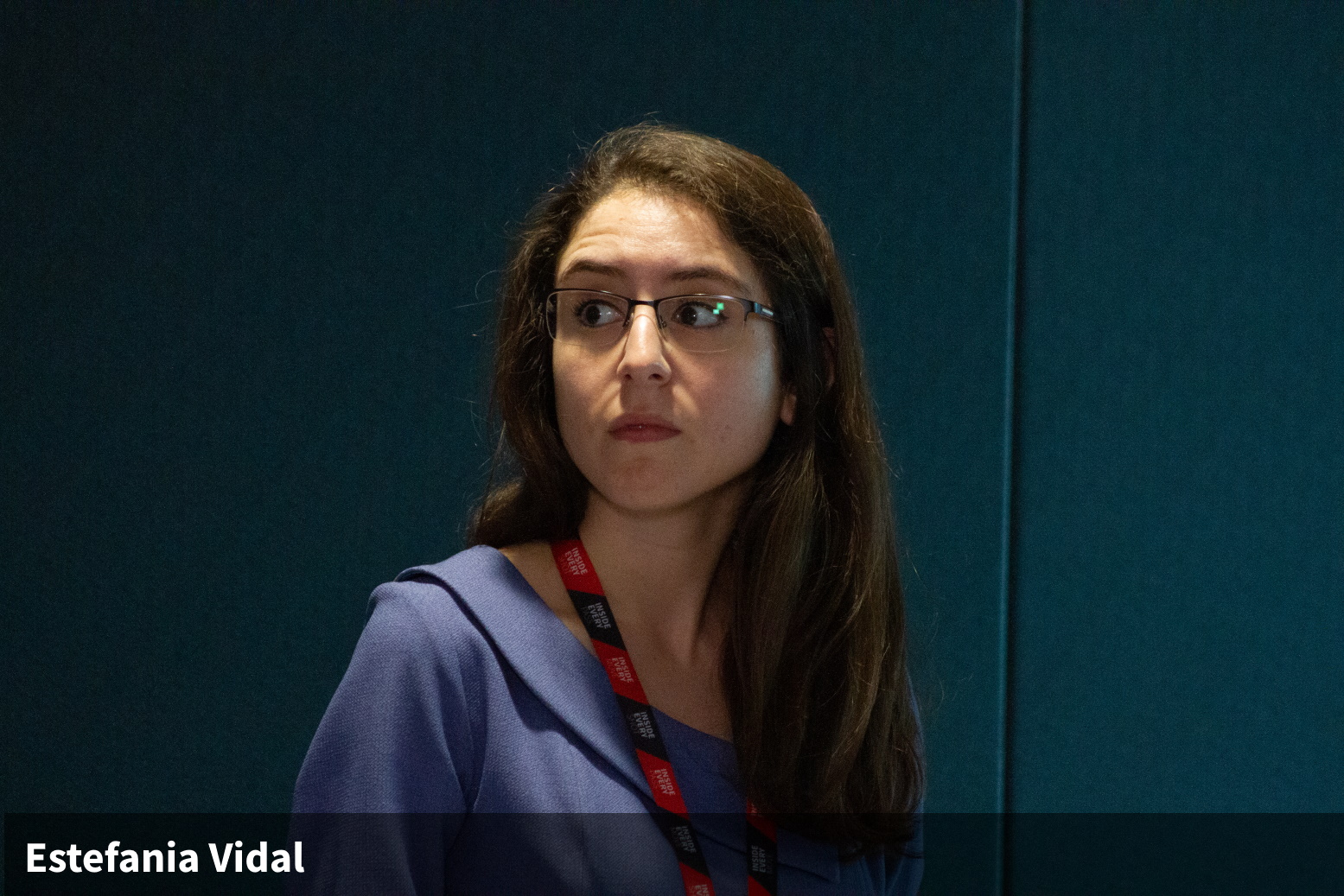 Twenty3 - How to Break Down a Set Defence Pieter Robberechts - Valuing the Art of Pressing Benjamin Larrousse - Improving Decision Making For Shots Ryan Beal - Learning The Value of Teamwork to Form Efficient Teams
Twenty3 - How to Break Down a Set Defence Pieter Robberechts - Valuing the Art of Pressing Benjamin Larrousse - Improving Decision Making For Shots Ryan Beal - Learning The Value of Teamwork to Form Efficient Teams 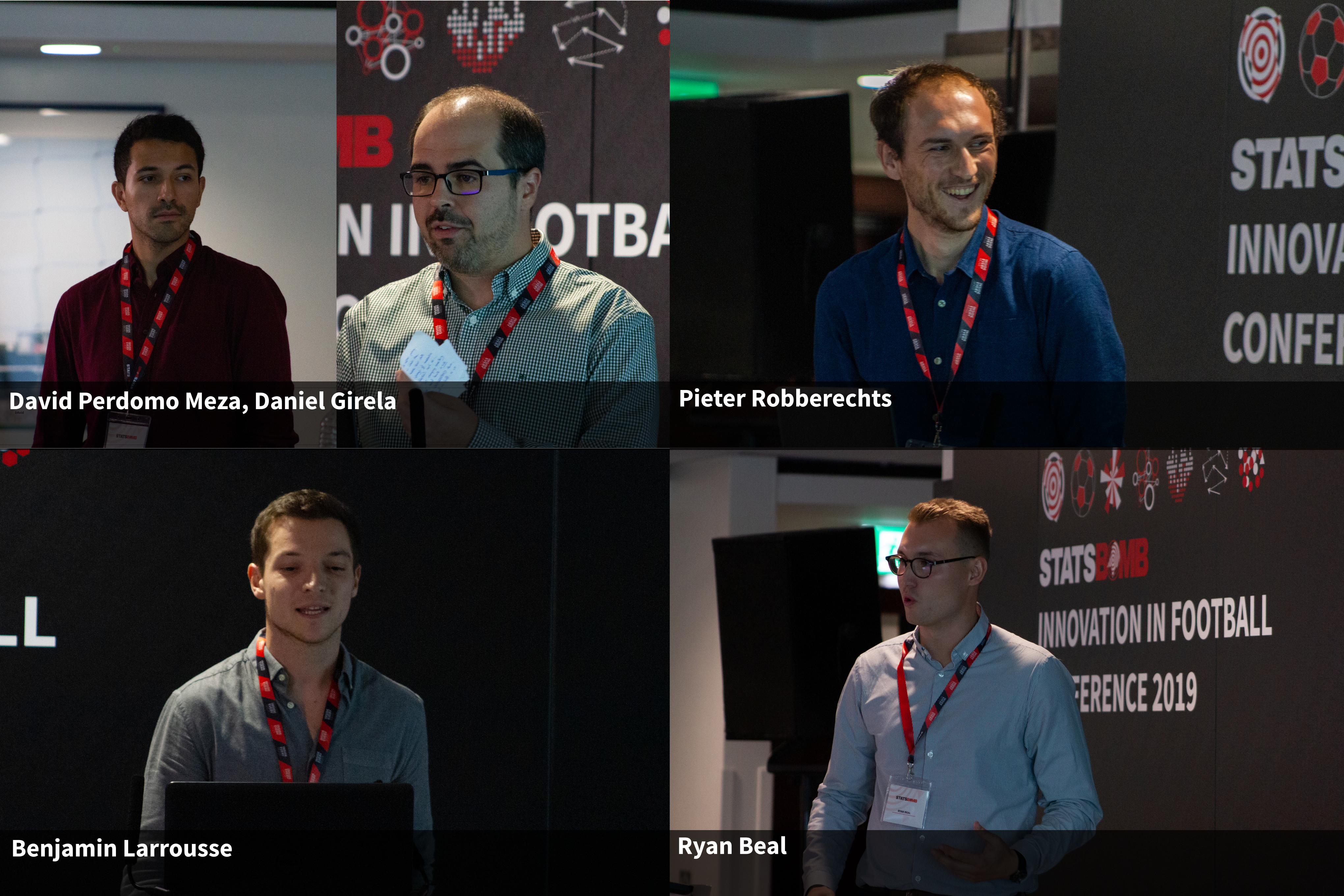
Valencia are hamstrung by chaos (again) ahead of their clash with stable Atlético Madrid
Prior to the start of the season, I suggested that Valencia were as well placed as any side in years to finally break the seven-season dominance of La Liga’s top-three positions by Atlético Madrid, Barcelona and Real Madrid. Valencia came into the campaign on the back of consecutive top-four finishes and having become the first team outside the aforementioned trio to lift domestic silverware since 2010 when they defeated Barcelona in the Copa del Rey final. They had a quality coach, a healthy age profile and good underlying numbers. But their hopes of ending that hegemony were heavily contingent on an uneasy truce holding between head coach Marcelino and the club’s owner Peter Lim. After a series of disputes over transfer targets and the minutes allotted to young players, interspersed with public barbs back and forth, it took just three matches for things to break down. Marcelino was sacked in mid-September and replaced with Albert Celades -- Valencia’s 12th coach since Unai Emery’s departure in 2012. Valencia weren’t all that impressive over those first few matches, but subsequent performances have been even worse. While they find themselves just three points (and five positions) behind third-placed Atlético ahead of their trip to the Wanda Metropolitano on Saturday, they come into the fixture looking more like marginal top-four contenders than genuine top-three aspirants. 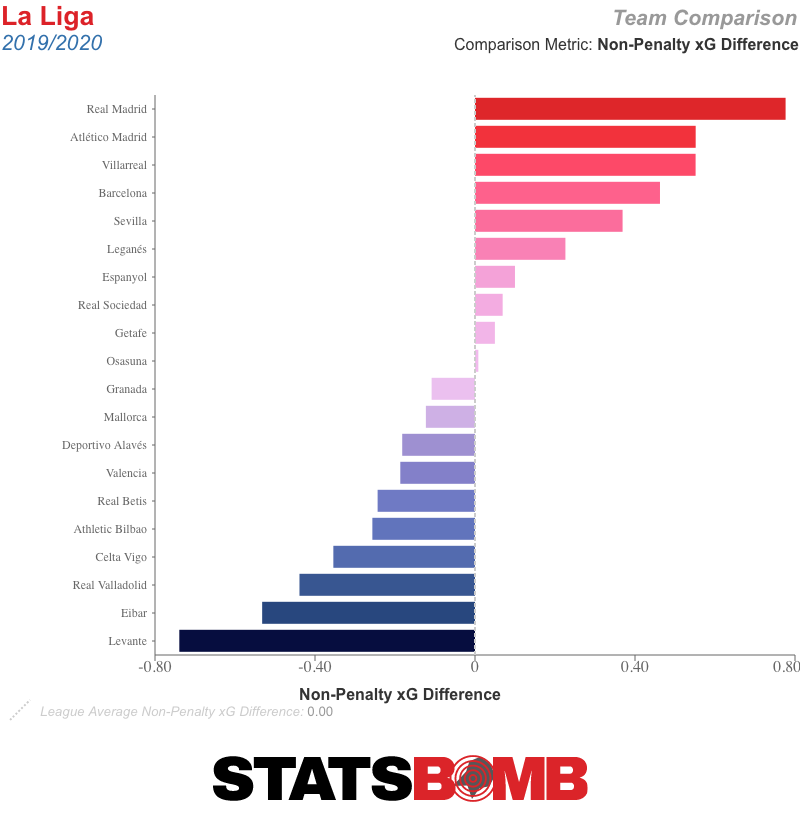 Celades wasn’t dealt the easiest of hands replacing a coach that many of the players were disappointed to see depart, and it will take some time for him to implement some of his own ideas in what is his first senior head coach role. He has only been in charge for five league matches, one of which was a 5-2 defeat away to Barcelona, so it’s not a fair sample, but his short tenure to date has nevertheless been the second worst five-match stretch Valencia have had in terms of expected goal (xG) difference since the start of the 2017-18 season. The worst comprised of his first three matches tacked onto Marcelino’s last two. They have been the worse side in xG terms in four of his first five fixtures -- against Barcelona, Leganés, Getafe and Alavés. Valencia sold none of their key players over the summer and arguably have a slightly stronger squad than they did last season, especially with Maxi Gómez getting off to a good start in front of goal following his move from Celta Vigo. But across the eight matches of the campaign to date, they’ve been worse at both a top-line and underlying level.
Celades wasn’t dealt the easiest of hands replacing a coach that many of the players were disappointed to see depart, and it will take some time for him to implement some of his own ideas in what is his first senior head coach role. He has only been in charge for five league matches, one of which was a 5-2 defeat away to Barcelona, so it’s not a fair sample, but his short tenure to date has nevertheless been the second worst five-match stretch Valencia have had in terms of expected goal (xG) difference since the start of the 2017-18 season. The worst comprised of his first three matches tacked onto Marcelino’s last two. They have been the worse side in xG terms in four of his first five fixtures -- against Barcelona, Leganés, Getafe and Alavés. Valencia sold none of their key players over the summer and arguably have a slightly stronger squad than they did last season, especially with Maxi Gómez getting off to a good start in front of goal following his move from Celta Vigo. But across the eight matches of the campaign to date, they’ve been worse at both a top-line and underlying level. 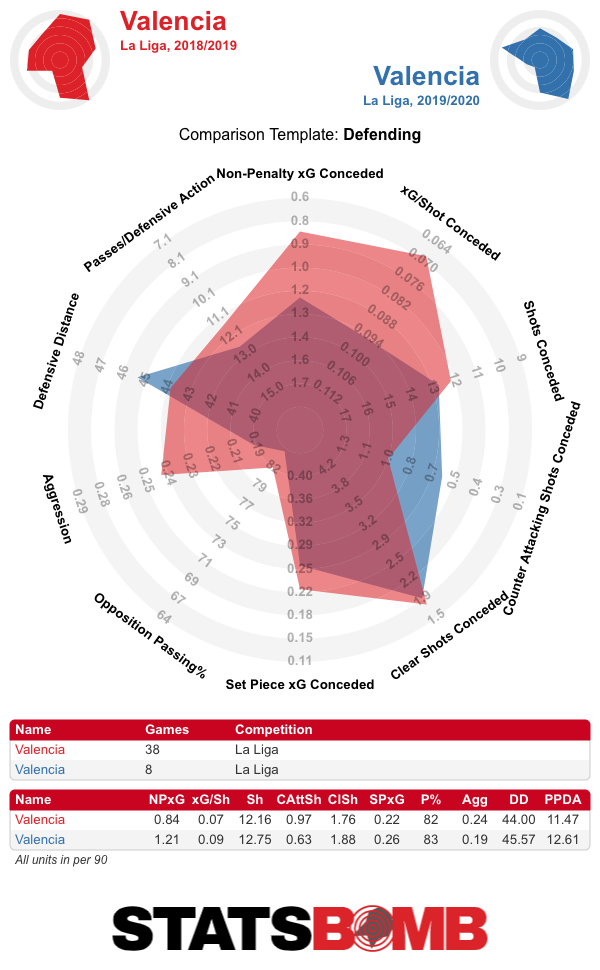
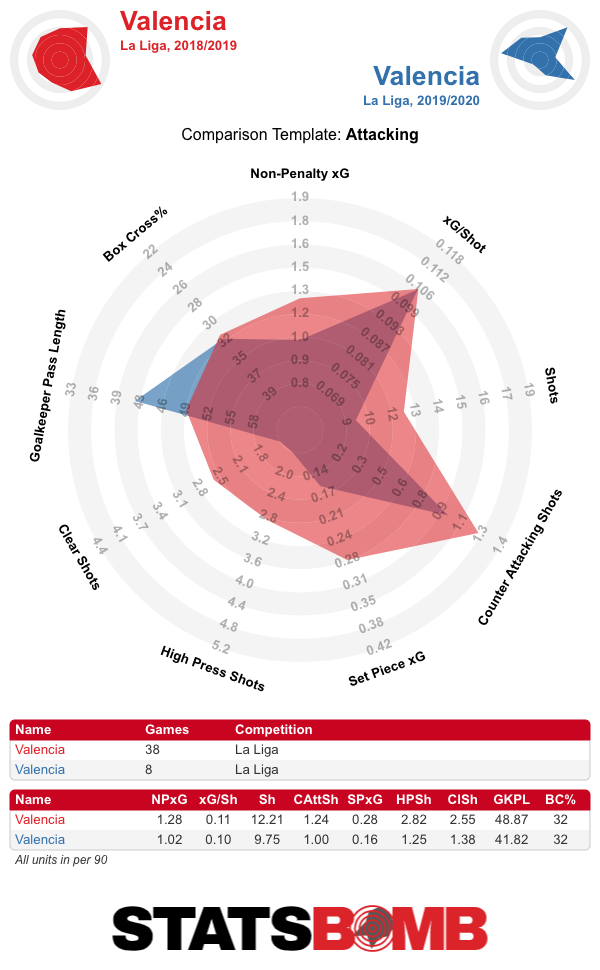 The fact that at least in its early stages, there seems to be little to separate a fairly large chunk of the league this season plays to Valencia’s favour, if they can swiftly find a way to improve performances and results. Consecutive wins away to Athletic Club and at home to Alavés have provided a bit of cautious optimism, but the trip to Atlético could easily temper that. Valencia last defeated them in 2014 and haven’t won away there since 2011. “Against Atlético, we will really see where we stand,” fullback José Gayá said this week. Atlético are certainly as good a barometer as any. Of all the teams who have taken part in La Liga in all of the last five seasons, only Barcelona have had a lower percentage variance between their best and worst points tallies than Diego Simeone’s side. They have been a picture of consistency, regularly converting the league’s third-biggest budget into top-three finishes. Players have come and gone, but Simeone and his staff have maintained a steady level of performance. Until very recently (damn you Espanyol!), Saturday’s match would have pitted La Liga’s longest and shortest-serving coaches against one another. This summer saw huge turnover at Atlético. Four regular starters and other mainstays of the Simeone era departed, and a series of new signings arrived in their place. João Félix and full-backs Kieran Trippier and Renan Lodi have immediately become regulars. As is becoming tradition, pre-season was filled with talk of a switch to a more expansive approach. The reality is that Atlético are the same team as always: very strong defensively and by the underlying numbers at least, above average in attack.
The fact that at least in its early stages, there seems to be little to separate a fairly large chunk of the league this season plays to Valencia’s favour, if they can swiftly find a way to improve performances and results. Consecutive wins away to Athletic Club and at home to Alavés have provided a bit of cautious optimism, but the trip to Atlético could easily temper that. Valencia last defeated them in 2014 and haven’t won away there since 2011. “Against Atlético, we will really see where we stand,” fullback José Gayá said this week. Atlético are certainly as good a barometer as any. Of all the teams who have taken part in La Liga in all of the last five seasons, only Barcelona have had a lower percentage variance between their best and worst points tallies than Diego Simeone’s side. They have been a picture of consistency, regularly converting the league’s third-biggest budget into top-three finishes. Players have come and gone, but Simeone and his staff have maintained a steady level of performance. Until very recently (damn you Espanyol!), Saturday’s match would have pitted La Liga’s longest and shortest-serving coaches against one another. This summer saw huge turnover at Atlético. Four regular starters and other mainstays of the Simeone era departed, and a series of new signings arrived in their place. João Félix and full-backs Kieran Trippier and Renan Lodi have immediately become regulars. As is becoming tradition, pre-season was filled with talk of a switch to a more expansive approach. The reality is that Atlético are the same team as always: very strong defensively and by the underlying numbers at least, above average in attack. 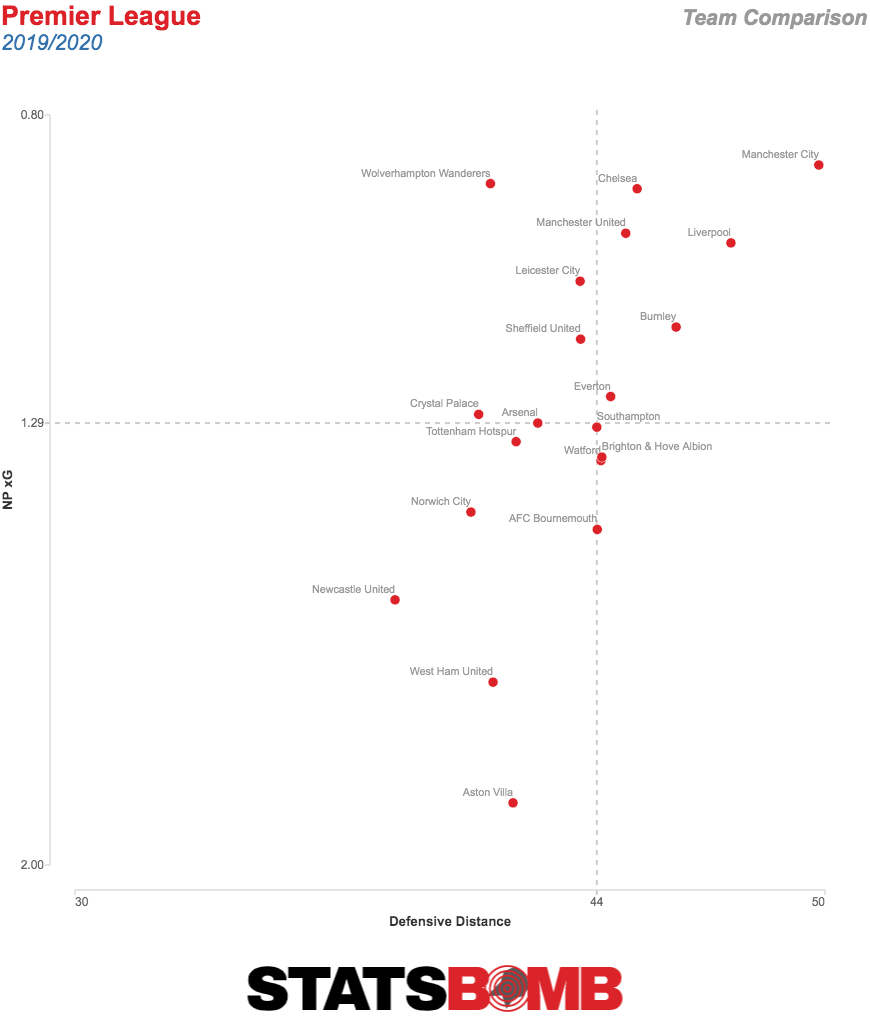 Simeone has really leaned hard on his defence so far. Atlético have kept clean sheets in seven of their 10 matches in league and Champions League play, including in each of the last five. Three of their last four league matches have ended 0-0. Their 0.52 xG conceded per match is comfortably the lowest mark in La Liga. Only three teams are conceding less shots, and no one is giving up such low-quality ones.
Simeone has really leaned hard on his defence so far. Atlético have kept clean sheets in seven of their 10 matches in league and Champions League play, including in each of the last five. Three of their last four league matches have ended 0-0. Their 0.52 xG conceded per match is comfortably the lowest mark in La Liga. Only three teams are conceding less shots, and no one is giving up such low-quality ones. 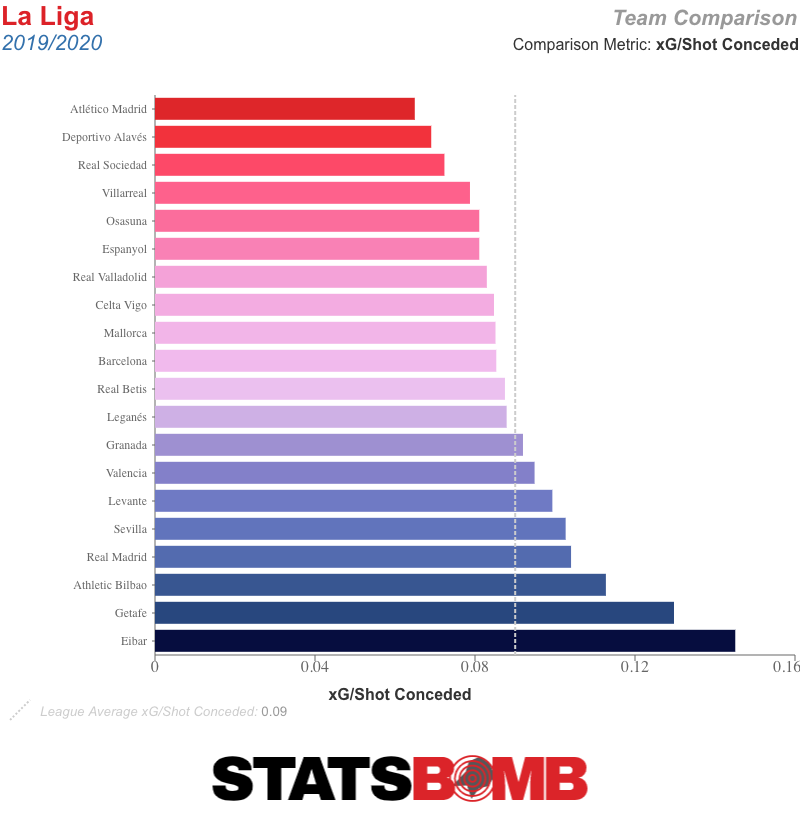 That is providing a stable base for Simeone’s experiments (including a midfield diamond with Thomas Lemar at its tip) as he reaches for a coherent attack. Antoine Griezmann was such an important cog in their previous set up that it was always going to take some time to work out an alternative. Atlético’s unsuccessful late-window attempts at signing Rodrigo from Valencia -- a relatively close stylistic match -- illustrated his lack of confidence that existing options would prove sufficient. So far, his side are doing enough to get by with a mix of average open play numbers and better than average set-piece output. Atlético’s supporters are likely to suffer through a fair number of low-scoring slogs this season (no other team’s matches have seen less goals so far; only those of two have seen less xG), but that might just be what is required to keep them in the realm of their usual points tally and so continue their run of top-three finishes through an eighth consecutive season. It is a bet on no one emerging from the pack below. Valencia were the most likely candidates before internecine squabbles intervened. Unless Sevilla, Real Sociedad or Villarreal show themselves to be genuine contenders over the next couple of months, it will probably prove quite a safe one.
That is providing a stable base for Simeone’s experiments (including a midfield diamond with Thomas Lemar at its tip) as he reaches for a coherent attack. Antoine Griezmann was such an important cog in their previous set up that it was always going to take some time to work out an alternative. Atlético’s unsuccessful late-window attempts at signing Rodrigo from Valencia -- a relatively close stylistic match -- illustrated his lack of confidence that existing options would prove sufficient. So far, his side are doing enough to get by with a mix of average open play numbers and better than average set-piece output. Atlético’s supporters are likely to suffer through a fair number of low-scoring slogs this season (no other team’s matches have seen less goals so far; only those of two have seen less xG), but that might just be what is required to keep them in the realm of their usual points tally and so continue their run of top-three finishes through an eighth consecutive season. It is a bet on no one emerging from the pack below. Valencia were the most likely candidates before internecine squabbles intervened. Unless Sevilla, Real Sociedad or Villarreal show themselves to be genuine contenders over the next couple of months, it will probably prove quite a safe one.
Stats of Interest
Speaking of Atlético’s attack, Diego Costa’s radar is pretty grim (albeit marginally improved in shot output from last season). 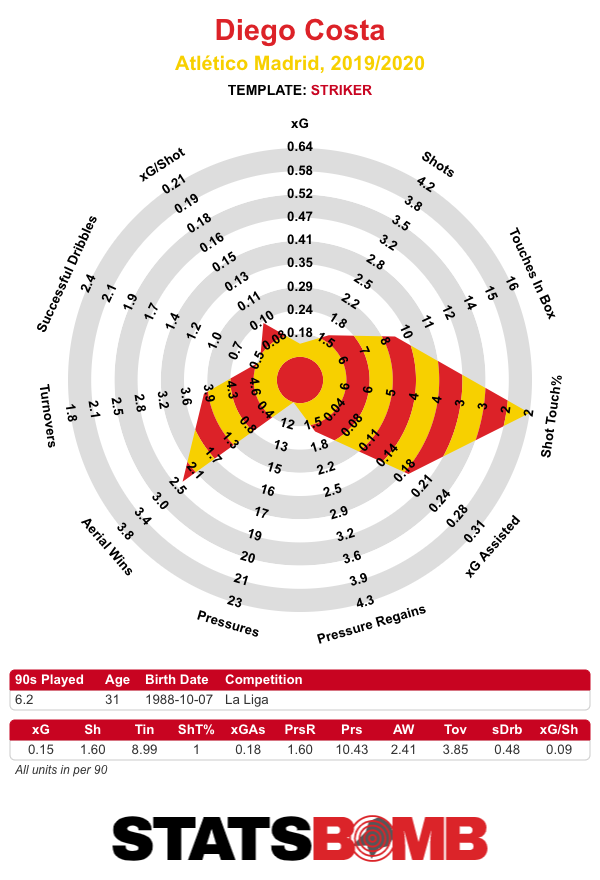 Care to venture a guess at La Liga’s most two-footed player so far this season? No, not him. Or him. Or him. Nope. It’s Tomás Pina of Alavés, with a near perfect 50/50 split between his left and right foot.
Care to venture a guess at La Liga’s most two-footed player so far this season? No, not him. Or him. Or him. Nope. It’s Tomás Pina of Alavés, with a near perfect 50/50 split between his left and right foot.
Should Everton stick or twist with Marco Silva?
It took some time, but Everton got exactly the manager they wanted. It’s fair to say Farhad Moshiri didn’t entirely know what he was doing when he bought the Blues. Transforming things from the kind of old fashioned outfit Bill Kenwright ran to a thoroughly modern football club was obviously the aim, but it was tough to figure out where to start that transition. Perhaps lacking in good advice, he went straight in for Ronald Koeman, with Steve Walsh brought in as director of football, a position he had no real experience in. After significant investment in the first team, it became apparent that Koeman was not the man for the job, and he got the boot. Walsh eventually got his preferred coach in Sam Allardyce, but the mere fact that this was his preference showed his unsuitability for the role at Everton, and both were kicked out before too long. Throughout most of this, there was a certain Portuguese sparkle in Moshiri’s eye. Marco Silva was who the owner craved. He had to wait, but eventually Moshiri got his man. Alongside actual director of football Marcel Brands, Silva was deemed the person to build the kind of football, and results, Moshiri felt was befitting of his considerable investment in the club. It took some time, but this was the Everton he had envisioned. All plain sailing from there, right? Well, not exactly. Everton currently sit in the relegation zone in the Premier League table, having picked up just 7 points from 8 games and lost all of the last 4. It was in October 2017 when the club sacked Koeman with the side in the bottom three, so it’s hardly a surprise to see the vultures circling at Goodison Park again. But should they be? A basic glance at the expected goals at least paints a better picture than the league table. On the attacking side, Everton have created 10.39 expected goals, ninth best in the league, but found the back of the net just six times. It’s much the same story at the back. Everton’s 10.55 xG conceded is a hair above league average, but chances have been finished at a better than usual rate and the Toffees find themselves having conceded 13. So the xG suggests Everton have performed like a midtable side so far. This is obviously better than results, and Silva’s job presumably wouldn’t be in such danger if the club were sitting in tenth. But at the same time, it’s still short of what the club have been aiming and spending for in recent years. xG isn’t going to save Silva’s job, so we’ll have to look a little deeper for redemption. The main thing Everton do in the numbers is press. The Blues allow the opponents to have fewer passes before attempting to win the ball back than any team other than Leicester. StatsBomb contributor Paul Riley’s personal research found Everton to be the highest pressing side in the league in his own numbers. Their defensive distance, how high up the pitch they attempt to win the ball back, is only fifth best, but some of that is likely because they are not able to pen teams into their own half the way Liverpool and Manchester City do. Everton certainly set out to press early and press often. The main aim of this, at least in a defensive sense, is to suppress shots, and Everton are successful in this. Their 9.63 shots per game conceded is the fourth best in the league. 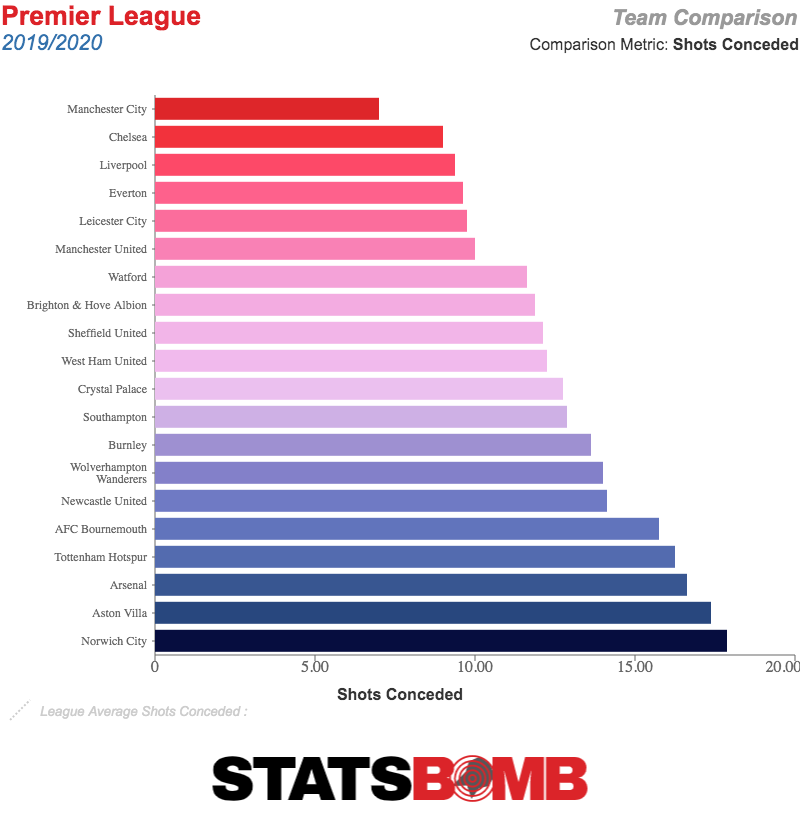 The trick, of course, is to make sure the shots you do concede aren’t horrific ones. If teams are able to break through the high press, they might find plenty of space in behind to really cut you open. And it does look like Everton are finding it difficult here. Their xG per shot conceded of 0.13 is fourth worst in the league and 30% worse than last season. When you look at the shot map, what stands out is the number of chances against that come from throughballs. Teams are able to play incisive passes through Everton’s defence and produce some very good scoring opportunities from it.
The trick, of course, is to make sure the shots you do concede aren’t horrific ones. If teams are able to break through the high press, they might find plenty of space in behind to really cut you open. And it does look like Everton are finding it difficult here. Their xG per shot conceded of 0.13 is fourth worst in the league and 30% worse than last season. When you look at the shot map, what stands out is the number of chances against that come from throughballs. Teams are able to play incisive passes through Everton’s defence and produce some very good scoring opportunities from it. 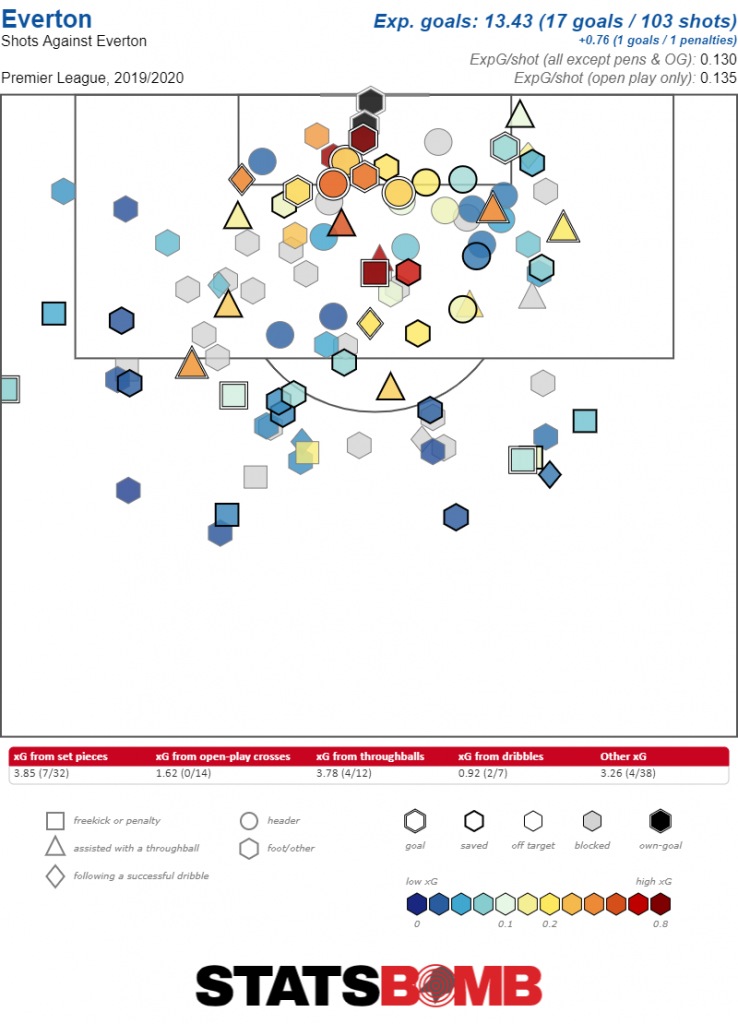 In terms of what has changed, it’s hard not to point towards the sale of Idrissa Gueye. The Senegal international was one of the better ball winning midfielders in the league without costing Everton too much on the ball. Injuries and perhaps genuine questions over personnel have meant that Everton haven’t quite had an obvious first choice midfield pair this season. The past four games have seen Fabian Delph and Morgan Schneiderlin selected to less than ideal results. Schneiderlin has never been able to recreate his aggressive defensive output from his Southampton years at Goodison and his limits are fairly well known at this point. With Jean-Philippe Gbamin’s injury, Delph has really been asked to take up the role as the Gueye replacement. Delph has shown a lot of tactical intelligence and flexibility throughout his career, particularly in his ability to seamlessly adapt from a box to box shuttler to an inverted left back under Pep Guardiola. He can be an excellent utility option, but he’s not a specialist for the defensive midfield role. Looking at his radar, it’s obvious that he just doesn’t actively involve himself in defending the way Gueye does.
In terms of what has changed, it’s hard not to point towards the sale of Idrissa Gueye. The Senegal international was one of the better ball winning midfielders in the league without costing Everton too much on the ball. Injuries and perhaps genuine questions over personnel have meant that Everton haven’t quite had an obvious first choice midfield pair this season. The past four games have seen Fabian Delph and Morgan Schneiderlin selected to less than ideal results. Schneiderlin has never been able to recreate his aggressive defensive output from his Southampton years at Goodison and his limits are fairly well known at this point. With Jean-Philippe Gbamin’s injury, Delph has really been asked to take up the role as the Gueye replacement. Delph has shown a lot of tactical intelligence and flexibility throughout his career, particularly in his ability to seamlessly adapt from a box to box shuttler to an inverted left back under Pep Guardiola. He can be an excellent utility option, but he’s not a specialist for the defensive midfield role. Looking at his radar, it’s obvious that he just doesn’t actively involve himself in defending the way Gueye does. 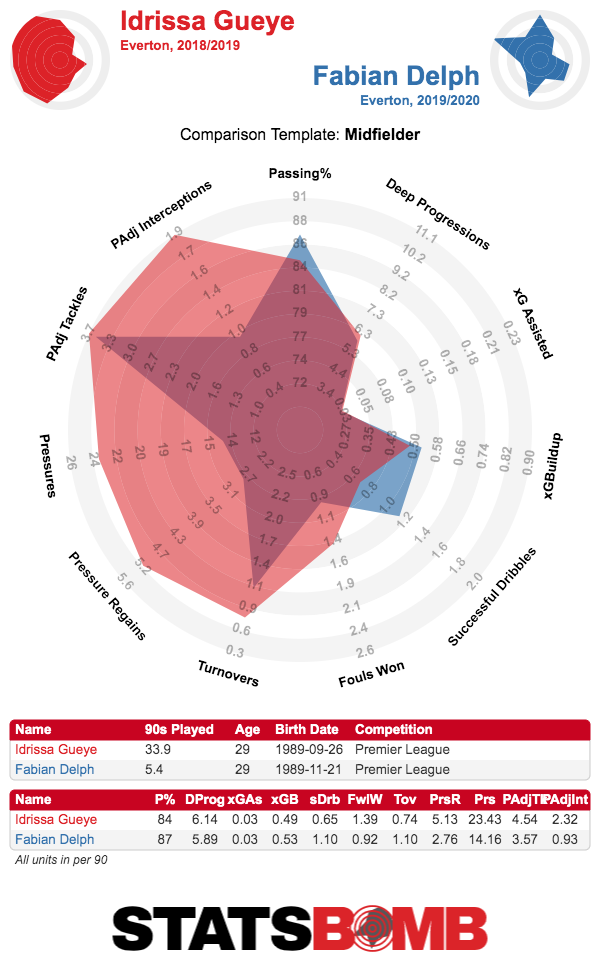 There’s not much that’s particularly special about Everton’s midfielders when they have the ball, either. Recently injured Andre Gomes is the player expected to really progress the ball in central areas, but he’s never really shown much in that regard through the numbers. He’s not moving the ball into the final third at a notably better rate than Schneiderlin or Delph. What this does is put more pressure on the fullbacks, with Seamus Coleman leading this stat. To be the side’s leading ball progressor without significant protection from the midfield is something of an impossible task, so it’s not shocking that there are some frustrations here.
There’s not much that’s particularly special about Everton’s midfielders when they have the ball, either. Recently injured Andre Gomes is the player expected to really progress the ball in central areas, but he’s never really shown much in that regard through the numbers. He’s not moving the ball into the final third at a notably better rate than Schneiderlin or Delph. What this does is put more pressure on the fullbacks, with Seamus Coleman leading this stat. To be the side’s leading ball progressor without significant protection from the midfield is something of an impossible task, so it’s not shocking that there are some frustrations here.  Everton don’t have a clearly defined plan once they get the ball into the final third either. The two ever presents here are Gylfi Sigurdsson and Richarlison. Both press well and take shots of questionable quality, but offer little in terms of really moving the ball into dangerous areas. In terms of offering creative passing, it seems to be a competition between Bernard and Alex Iwobi to fill that role. Bernard offers virtually nothing in terms of goal and assist threat, so it seems likely that Iwobi should take over in due course. A combination of Iwobi, Sigurdsson and Richarlison behind either Dominic Calvert-Lewin or Moise Kean depending on the opposition could potentially be a flexible and fluid attack, but we’ve yet to see any real evidence of it. It’s not really clear what this Everton squad is built to be doing. Silva wants to play a high line, aggressive pressing style, but this requires fast centre backs capable of covering a lot of ground, while Michael Keane is a regular fixture at centre back. The midfield contains a selection of players who offer flexibility and a solid range of skills, but no one who is truly outstanding at anything. The attack has various different options, but no clear hierarchy. Perhaps this shouldn’t be a surprise after four different managers and two directors of football in the last two years. The most important job for Everton, ahead of dealing with the manager question, is for Brands to move towards a coherent squad where everyone is suited to playing the same kind of football. Considering he has a seat on the board, his job is almost certainly safe for the foreseeable future, so this will be a squad very much shaped by the Dutchman. If the club truly believe in Silva, the squad certainly needs more overhauling to fit his “press high and play nice football or death” approach. But there’s also not a lot of evidence that this would be an especially good idea. Silva is at his third Premier League club and at no point has he coached a particularly solid defence. He can make excuses in terms of the players he had available, but there’s slim evidence that he’s more Mauricio Pochettino than Roberto Martinez. Changing the manager has its obvious risks, and would require serious thought in terms of what Everton’s long term strategy should be. The priority, though, is ensuring that there is a plan, with or without Silva. Header image courtesy of the Press Association
Everton don’t have a clearly defined plan once they get the ball into the final third either. The two ever presents here are Gylfi Sigurdsson and Richarlison. Both press well and take shots of questionable quality, but offer little in terms of really moving the ball into dangerous areas. In terms of offering creative passing, it seems to be a competition between Bernard and Alex Iwobi to fill that role. Bernard offers virtually nothing in terms of goal and assist threat, so it seems likely that Iwobi should take over in due course. A combination of Iwobi, Sigurdsson and Richarlison behind either Dominic Calvert-Lewin or Moise Kean depending on the opposition could potentially be a flexible and fluid attack, but we’ve yet to see any real evidence of it. It’s not really clear what this Everton squad is built to be doing. Silva wants to play a high line, aggressive pressing style, but this requires fast centre backs capable of covering a lot of ground, while Michael Keane is a regular fixture at centre back. The midfield contains a selection of players who offer flexibility and a solid range of skills, but no one who is truly outstanding at anything. The attack has various different options, but no clear hierarchy. Perhaps this shouldn’t be a surprise after four different managers and two directors of football in the last two years. The most important job for Everton, ahead of dealing with the manager question, is for Brands to move towards a coherent squad where everyone is suited to playing the same kind of football. Considering he has a seat on the board, his job is almost certainly safe for the foreseeable future, so this will be a squad very much shaped by the Dutchman. If the club truly believe in Silva, the squad certainly needs more overhauling to fit his “press high and play nice football or death” approach. But there’s also not a lot of evidence that this would be an especially good idea. Silva is at his third Premier League club and at no point has he coached a particularly solid defence. He can make excuses in terms of the players he had available, but there’s slim evidence that he’s more Mauricio Pochettino than Roberto Martinez. Changing the manager has its obvious risks, and would require serious thought in terms of what Everton’s long term strategy should be. The priority, though, is ensuring that there is a plan, with or without Silva. Header image courtesy of the Press Association
I’ll be right back: The Héctor Bellerín and Ainsley Maitland-Niles Arsenal story
There is no right back controversy at Arsenal. Internet boyfriend Héctor Bellerín, who recently returned from a long-term injury, is the starter. Academy product Ainsley Maitland-Niles is once again his backup. This formulation — a starter and his young understudy — flattens the difference between the two players. It suggests that Maitland-Niles is simply a lesser player. While possibly true, that is not a good way to understand either player. Maitland-Niles isn’t a copy of a copy of Bellerín. Arsenal just so happens to have two young, interesting and very different right backs in its squad. 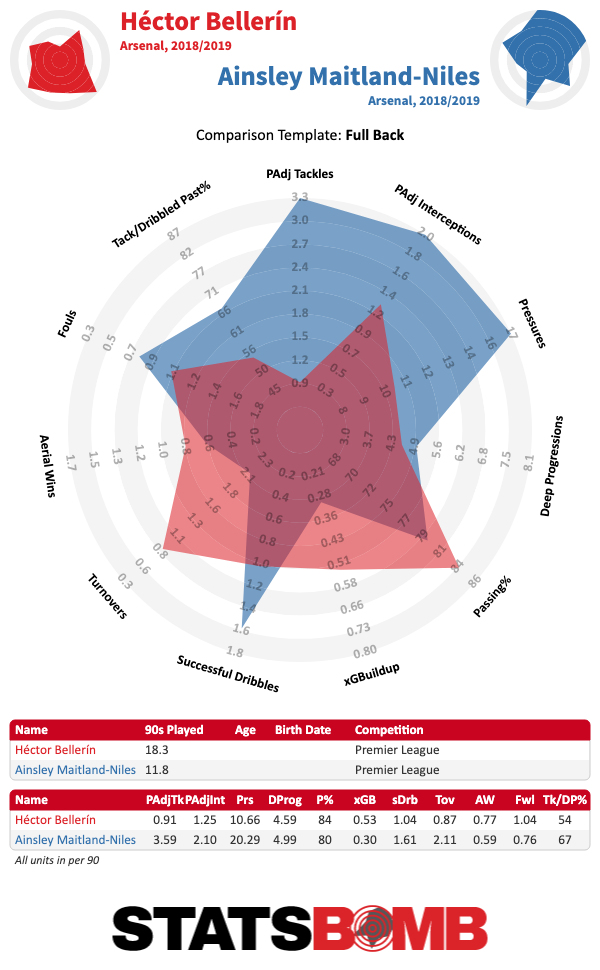 This was not the plan — at least not exactly. The point of Bellerín has never been a mystery: He offers a mix of speed and good passing with just enough defence to justify his presence on the pitch. In Arsène Wenger’s final season, when he was last healthy, Bellerín was a passable defender: his tackles and interception rates were roughly average; he was a decent presser; opposing players dribbled past him a fair bit, which tended to result in him picking up fouls. He didn’t progress the ball so much as he served as an additional creative player higher up the pitch. He passed well enough to make that role work, and was heavily involved in the team’s attack.
This was not the plan — at least not exactly. The point of Bellerín has never been a mystery: He offers a mix of speed and good passing with just enough defence to justify his presence on the pitch. In Arsène Wenger’s final season, when he was last healthy, Bellerín was a passable defender: his tackles and interception rates were roughly average; he was a decent presser; opposing players dribbled past him a fair bit, which tended to result in him picking up fouls. He didn’t progress the ball so much as he served as an additional creative player higher up the pitch. He passed well enough to make that role work, and was heavily involved in the team’s attack. 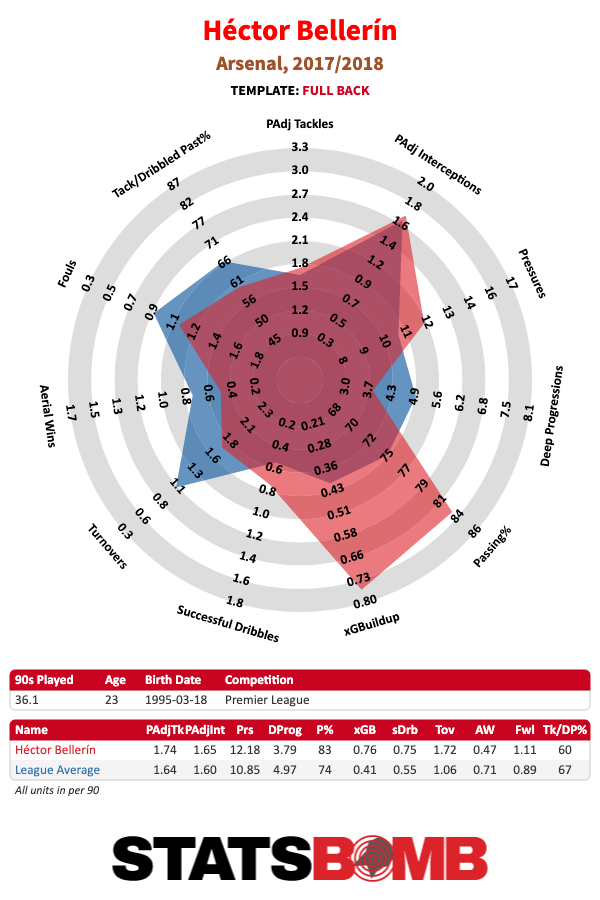 When Unai Emery took over Arsenal, the club tried to bring in a more defensively-minded backup for Bellerín. This likely reflected the new manager’s preferences. It was also, at least in part, a function of Mathieu Debuchy finally being off the club’s books. Maitland-Niles had filled in during the Frenchman’s tenure, but it was unclear if the club even saw him as a fullback (more on that later). Arsenal needed somebody — anybody, really — to serve as a backup right back. Intelligent people can debate whether Stephan Lichsteiner, signed in the summer of 2018, fit that billing. On the one hand, he had a corporeal presence and had played right (sometimes wing) back. He also had a “winning mentality,” whatever that is. On the other hand, it wasn’t clear his legs actually worked at the time he signed. It quickly became clear, through a combination of injuries and statuesque performances, that even if they had been operational before, those legs certainly didn’t make the trip from England to North London with the rest of him. Maitland-Niles was once again the de facto backup, which might not have mattered all that much if Bellerín’s leg had not also exploded. All of which is to say that Ainsley Maitland-Niles wound up playing more than 2,100 minutes for Arsenal in 2018-19 and was fine, basically. He played nothing like Bellerin, but a team that’s on its third right back can’t really be picky. It also helped that he played like a budget version of Aaron Wan-Bissaka.
When Unai Emery took over Arsenal, the club tried to bring in a more defensively-minded backup for Bellerín. This likely reflected the new manager’s preferences. It was also, at least in part, a function of Mathieu Debuchy finally being off the club’s books. Maitland-Niles had filled in during the Frenchman’s tenure, but it was unclear if the club even saw him as a fullback (more on that later). Arsenal needed somebody — anybody, really — to serve as a backup right back. Intelligent people can debate whether Stephan Lichsteiner, signed in the summer of 2018, fit that billing. On the one hand, he had a corporeal presence and had played right (sometimes wing) back. He also had a “winning mentality,” whatever that is. On the other hand, it wasn’t clear his legs actually worked at the time he signed. It quickly became clear, through a combination of injuries and statuesque performances, that even if they had been operational before, those legs certainly didn’t make the trip from England to North London with the rest of him. Maitland-Niles was once again the de facto backup, which might not have mattered all that much if Bellerín’s leg had not also exploded. All of which is to say that Ainsley Maitland-Niles wound up playing more than 2,100 minutes for Arsenal in 2018-19 and was fine, basically. He played nothing like Bellerin, but a team that’s on its third right back can’t really be picky. It also helped that he played like a budget version of Aaron Wan-Bissaka. 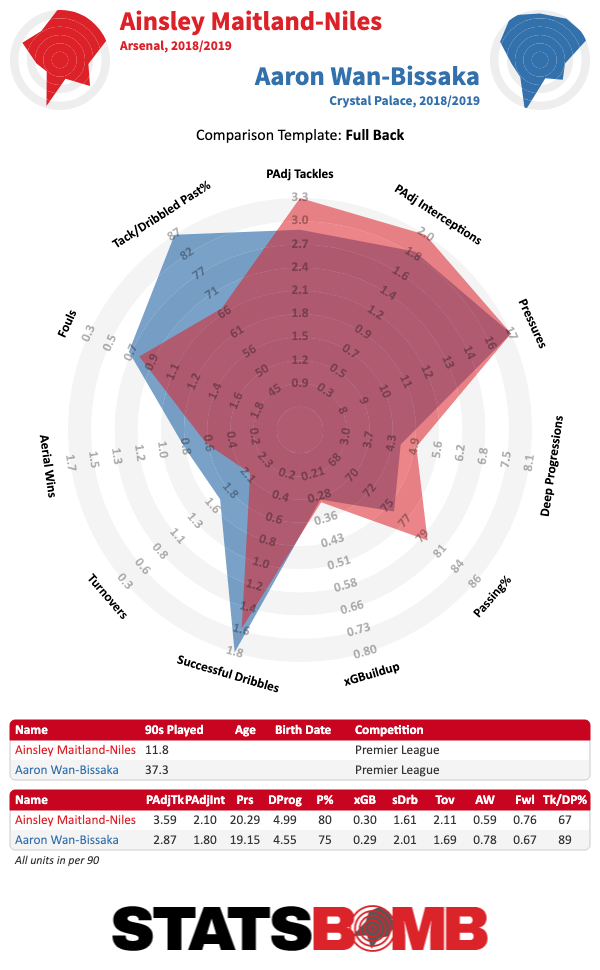 Let’s pause her for a brief digression about Aaron Wan-Bissaka. The comparison with Maitland-Niles is instructive insofar as it shows what Manchester United paid for this summer: A right back who opponents can’t escape on the dribble. The tackles and interceptions and pressures are all nice, but the point of Wan-Bissaka is that you can’t dribble past him. That’s what you pay $60 million for. Still, if you don’t have $60 million to spend and are just fishing around the academy for solutions, as is the late-period Arsenal way, a fullback who does lots of defensive work is a handy find. The high tackle, interception and pressure rates have been a consistent part of Maitland-Niles’ game dating back to Wenger’s final season. (His attacking contribution has been more variable.) He defends slightly deeper than Bellerín, but not in a way that can explain away the substantial difference in outcomes. They’re just different players.
Let’s pause her for a brief digression about Aaron Wan-Bissaka. The comparison with Maitland-Niles is instructive insofar as it shows what Manchester United paid for this summer: A right back who opponents can’t escape on the dribble. The tackles and interceptions and pressures are all nice, but the point of Wan-Bissaka is that you can’t dribble past him. That’s what you pay $60 million for. Still, if you don’t have $60 million to spend and are just fishing around the academy for solutions, as is the late-period Arsenal way, a fullback who does lots of defensive work is a handy find. The high tackle, interception and pressure rates have been a consistent part of Maitland-Niles’ game dating back to Wenger’s final season. (His attacking contribution has been more variable.) He defends slightly deeper than Bellerín, but not in a way that can explain away the substantial difference in outcomes. They’re just different players. 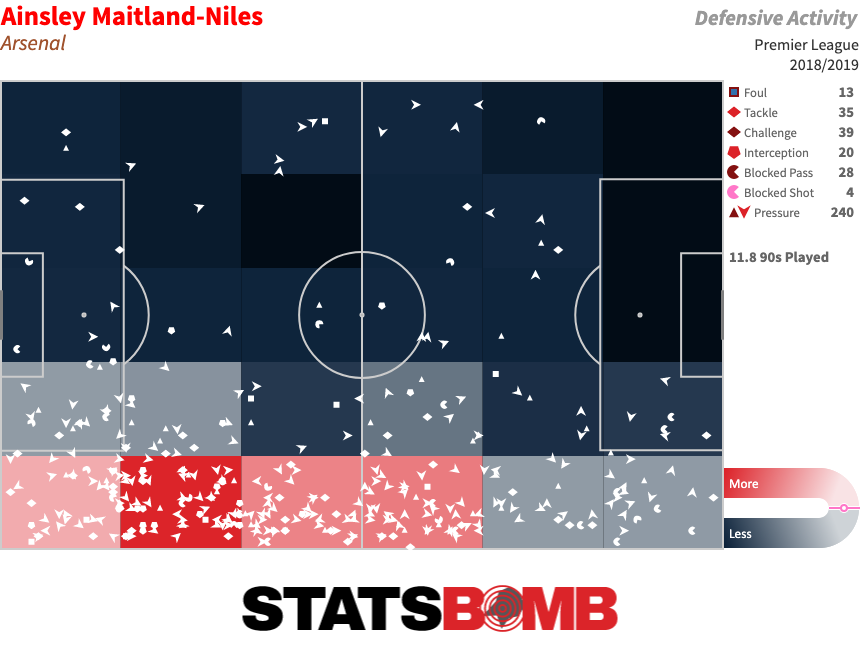 There’s a certain ambiguity to the things Maitland-Niles does well. Some of the tackling, for instance, might be explained away as recovering after opponents dribble past him. Recovering in such situations is good, but it doesn’t always inspire confidence. It’s easy to overstate the extent of the concern here. Opponents have dribbled past Maitland-Niles at a league-average rate in each of the last two seasons. He’s not Wan-Bissaka, obviously, but he does not have a history of getting roasted on the dribble. (So far this year, in a small sample, he’s been well below average.) Sometimes a tackle is just a tackle. Imagine a player who has played more than 2,100 minutes in consecutive seasons before his 22nd birthday. He’s a league-average defender against opposing players on the dribble but elite when it comes to pressing, tackling and intercepting. He’s a good dribbler, but doesn’t contribute much else in attack. Would you dispute that he’s a fullback? Would you dispute that he is of value? Such is the case with Ainsley Maitland-Niles, who some Arsenologists still insist is a defensive midfielder filling in at fullback in the club’s frequent times of crisis. (Some reporting suggests Maitland-Niles also feels this way.) About which, maybe??? Players can move between being defensive midfielders and fullbacks. That may be the biggest tactical legacy of Pep Guardiola’s Bayern Munich. But football is also rife with fullbacks who began their careers as midfielders. Maitland-Niles might one day be a midfielder, but it seems clear enough that he is already an interesting defensive fullback. This leaves Arsenal in an interesting position. There is no fullback competition. Bellerín is the starter when healthy, and Maitland-Niles’ defensive performances have done little to solidify the team in his absence. He is nevertheless an interesting piece, and definitely more than a squad player to be called upon in emergencies. Arsenal set out to get a defensive backup for Bellerín in 2018 only to find him already within the squad. What would be more Arsenal than lucking into such a player only to have no plan for using him?
There’s a certain ambiguity to the things Maitland-Niles does well. Some of the tackling, for instance, might be explained away as recovering after opponents dribble past him. Recovering in such situations is good, but it doesn’t always inspire confidence. It’s easy to overstate the extent of the concern here. Opponents have dribbled past Maitland-Niles at a league-average rate in each of the last two seasons. He’s not Wan-Bissaka, obviously, but he does not have a history of getting roasted on the dribble. (So far this year, in a small sample, he’s been well below average.) Sometimes a tackle is just a tackle. Imagine a player who has played more than 2,100 minutes in consecutive seasons before his 22nd birthday. He’s a league-average defender against opposing players on the dribble but elite when it comes to pressing, tackling and intercepting. He’s a good dribbler, but doesn’t contribute much else in attack. Would you dispute that he’s a fullback? Would you dispute that he is of value? Such is the case with Ainsley Maitland-Niles, who some Arsenologists still insist is a defensive midfielder filling in at fullback in the club’s frequent times of crisis. (Some reporting suggests Maitland-Niles also feels this way.) About which, maybe??? Players can move between being defensive midfielders and fullbacks. That may be the biggest tactical legacy of Pep Guardiola’s Bayern Munich. But football is also rife with fullbacks who began their careers as midfielders. Maitland-Niles might one day be a midfielder, but it seems clear enough that he is already an interesting defensive fullback. This leaves Arsenal in an interesting position. There is no fullback competition. Bellerín is the starter when healthy, and Maitland-Niles’ defensive performances have done little to solidify the team in his absence. He is nevertheless an interesting piece, and definitely more than a squad player to be called upon in emergencies. Arsenal set out to get a defensive backup for Bellerín in 2018 only to find him already within the squad. What would be more Arsenal than lucking into such a player only to have no plan for using him?
Borussia Mönchengladbach’s high speed attack is dominating the Bundesliga
Even though the term gets thrown around willy-nilly on this here internet, allow me to state that the current Bundesliga truly is… wild. Like, wild-wild. After seven matchdays, the glorious amount of two (!) total points separates the league leaders from seventh place - and that doesn’t even take into consideration that the team in eighth place is supposed title contender Borussia Dortmund, who’ve had a slow start under Lucien Favre this year. Fittingly, the surprise-filled start to this Bundesliga campaign has produced a surprise outfit at the very top of the standings: Borussia Mönchengladbach. After a disappointing 2018-19, where they squandered Champions League qualification after seemingly having sat comfortably in a top four spot for most of the season, but being leapfrogged by Bayer Leverkusen in the final weeks - after taking only nine total points from their last 12 games of the campaign - Die Fohlen (The Foals) were expected to have somewhat of a down year. Star player Thorgan Hazard moves to Dortmund and big-time prospect Mickaël Cuissance jumped to Bayern Munich, while captain Lars Stindl and midfield mainstay Jonas Hofmann has long term injury absences in the opening months. But newly appointed manager Marco Rose, who’s come over from Red Bull Salzburg - and has taken assistant René Maric, he of Spielverlagerung fame, with him - has transformed his new team in rapid fashion. Of course, Gladbach is enjoying the benefits of some overperformances in certain areas (we’ll get to that), but this side really seems to be a legit top four candidate. Let’s take a look at the surprise team of this young Bundesliga season, by looking at the team per positional group, starting with the attack.
Attack
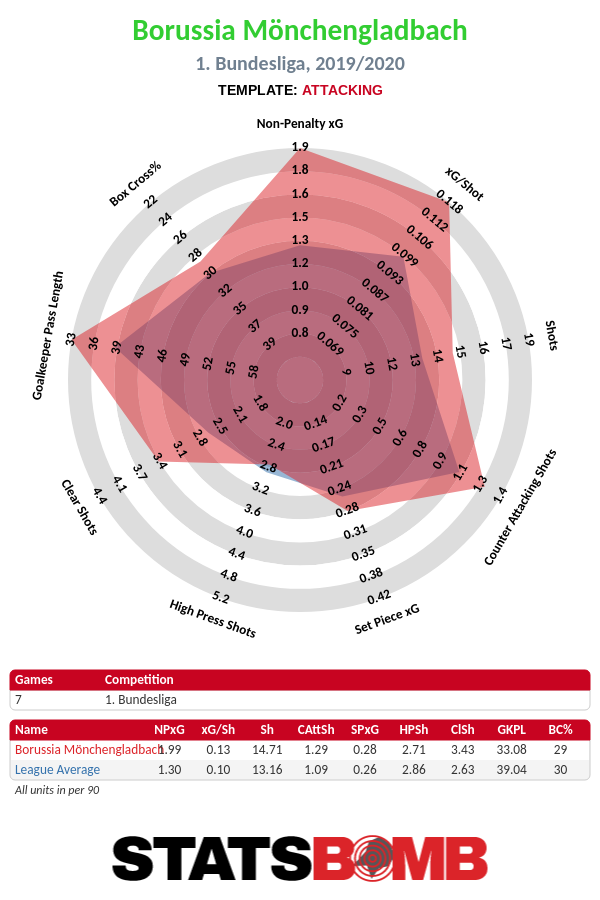 As you can see in the plot above, Mönchengladbach have all the makings of a genuinely good offensive team. The difference in attacking output with last year, where they were almost the definition of a league-average team, is quite staggering.
As you can see in the plot above, Mönchengladbach have all the makings of a genuinely good offensive team. The difference in attacking output with last year, where they were almost the definition of a league-average team, is quite staggering. 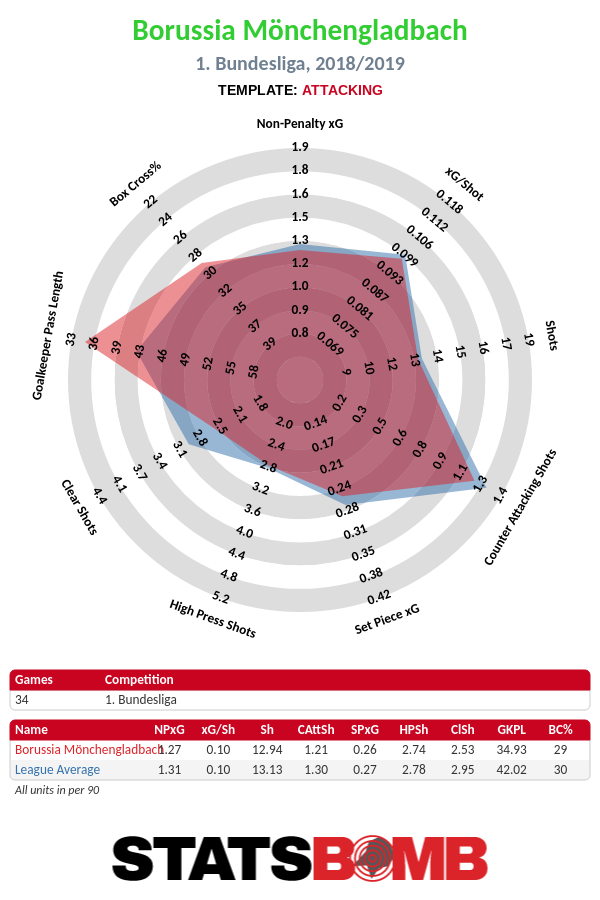 With four goals and four assists in the first seven matchdays, Alassane Pléa is the first player that jumps out, if you’ve only seen glimpses of Gladbach this year. The French attacker, who turned 26 years old in March, should earn some national team consideration from manager Didier Deschamps. But yeah… no need to dreg open the Sébastien Haller-and-other-strikers-who-are-not-Olivier-Giroud-wormhole again here. With 24 goals and assists combined in his first 41 league games for Mönchengladbach, Pléa is starting to justify the relatively hefty price tag that Die Fohlen had to pay OGC Nice in the summer of 2018 (23 million Euros).
With four goals and four assists in the first seven matchdays, Alassane Pléa is the first player that jumps out, if you’ve only seen glimpses of Gladbach this year. The French attacker, who turned 26 years old in March, should earn some national team consideration from manager Didier Deschamps. But yeah… no need to dreg open the Sébastien Haller-and-other-strikers-who-are-not-Olivier-Giroud-wormhole again here. With 24 goals and assists combined in his first 41 league games for Mönchengladbach, Pléa is starting to justify the relatively hefty price tag that Die Fohlen had to pay OGC Nice in the summer of 2018 (23 million Euros). 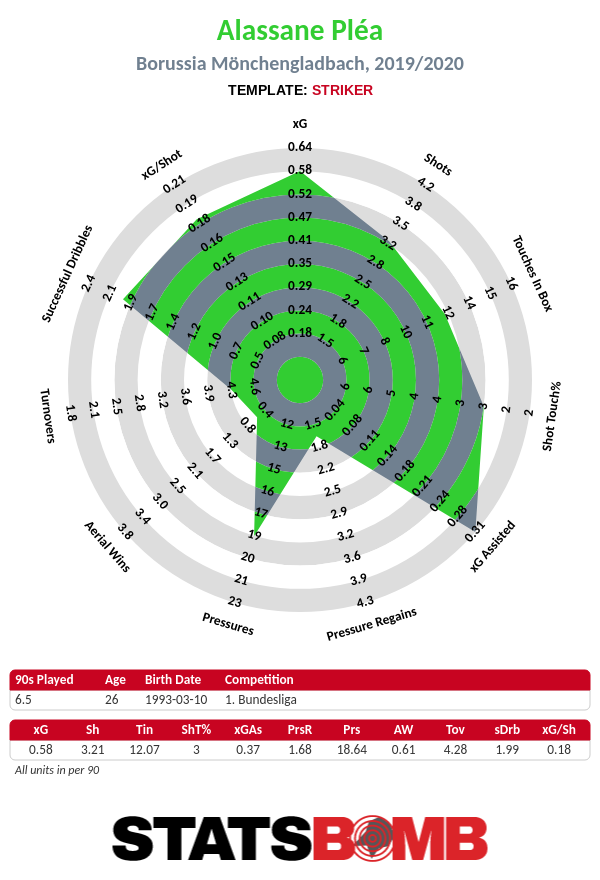 Mönchengladbach also bought Pléa’s striking partner in France. But, in contrast to the Pléa fee, the 9 million Euros that relegated EA Guingamp asked for Marcus Thuram, son of Lillian, seemed to be an absurdly low amount for such a solid young attacking talent. Thuram (22) is one of the rare cases of an offensive player that combines above average speed, strength, shooting skills and ball control, but was inconsistent enough in his first few years in the tough Ligue 1 to come at an affordable rate for Mönchengladbach.
Mönchengladbach also bought Pléa’s striking partner in France. But, in contrast to the Pléa fee, the 9 million Euros that relegated EA Guingamp asked for Marcus Thuram, son of Lillian, seemed to be an absurdly low amount for such a solid young attacking talent. Thuram (22) is one of the rare cases of an offensive player that combines above average speed, strength, shooting skills and ball control, but was inconsistent enough in his first few years in the tough Ligue 1 to come at an affordable rate for Mönchengladbach. 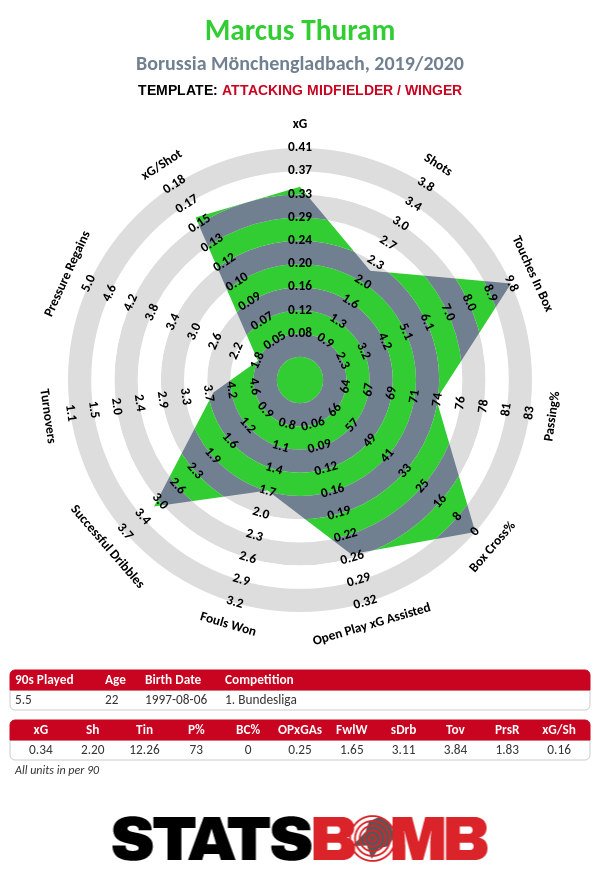 Like Pléa, Thuram is speedy enough to either play as aN out-and-out central striker or as an inverted winger, which really helps in Gladbach’s new system. In possession, Rose’s squad lines up in an unconventional version of a 4-4-2 diamond shape - whilst in defense, they press and drop back in the frames of a 4-2-3-1 shape - with both strikers alternately occupying (semi-)winger positions, especially when they break.
Like Pléa, Thuram is speedy enough to either play as aN out-and-out central striker or as an inverted winger, which really helps in Gladbach’s new system. In possession, Rose’s squad lines up in an unconventional version of a 4-4-2 diamond shape - whilst in defense, they press and drop back in the frames of a 4-2-3-1 shape - with both strikers alternately occupying (semi-)winger positions, especially when they break. 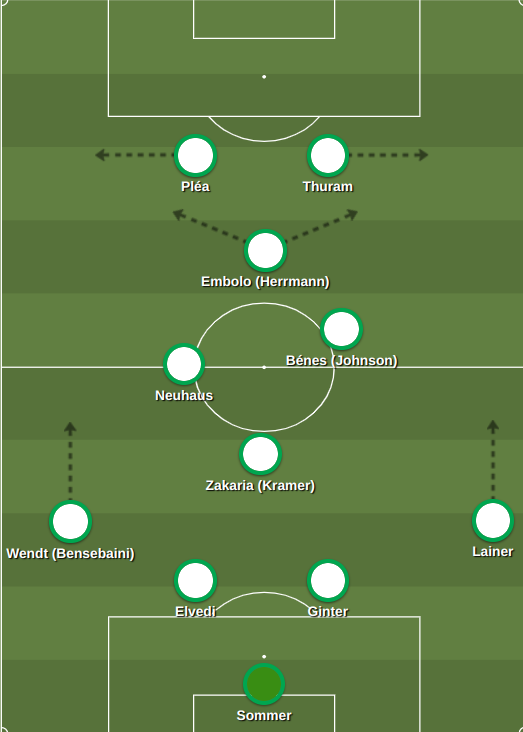 And whoo boy, Mönchengladbach can certainly play some fast-break ball at breakneck speed. Of the fifteen goals Die Fohlen have scored this season, only three were preceded by an attack consisting of more than five passes in the build-up to the final shot. Rose’s squad plays extremely vertical, even though they rarely hoof a desperate long ball up the pitch. The fact that Rose & co. have managed to significantly up Gladbach’s high-press of the opponent’s buildup in such a short time is quite impressive. But the improvement of razor sharp attacking patterns in their transition from defense to offense has been truly remarkable. The individual performances and skill-sets from the three players up top - Pléa and Thuram assisted by either Breel Embolo (attempting a comeback from a horrible form spell at Schalke) or Patrick Herrmann - have really helped this quick turnaround. Put it all together and you have a team averaging 0.13 expected goals per shot, the second highest total in the league. Combine that with the third highest shot total in it leaves Gladbach as the most potent attacking Bundesliga team to date with 1.99 non-penalty xG per match this season.
And whoo boy, Mönchengladbach can certainly play some fast-break ball at breakneck speed. Of the fifteen goals Die Fohlen have scored this season, only three were preceded by an attack consisting of more than five passes in the build-up to the final shot. Rose’s squad plays extremely vertical, even though they rarely hoof a desperate long ball up the pitch. The fact that Rose & co. have managed to significantly up Gladbach’s high-press of the opponent’s buildup in such a short time is quite impressive. But the improvement of razor sharp attacking patterns in their transition from defense to offense has been truly remarkable. The individual performances and skill-sets from the three players up top - Pléa and Thuram assisted by either Breel Embolo (attempting a comeback from a horrible form spell at Schalke) or Patrick Herrmann - have really helped this quick turnaround. Put it all together and you have a team averaging 0.13 expected goals per shot, the second highest total in the league. Combine that with the third highest shot total in it leaves Gladbach as the most potent attacking Bundesliga team to date with 1.99 non-penalty xG per match this season.
Midfield
Former manager Dieter Hecking opted for a 4-3-3 formation last season, with a frontline of dribbling master Hazard on the left, captain Stindl as a useful, team-oriented Falscher Neun (‘false nine’), and Pléa as a striker-on-the-wing as the team’s main calling card. Hecking’s player preferences were a lot less interesting: his favorite midfield seem to consist of the talented Florian Neuhaus and bankable Hofmann in the more attacking roles, with the unspectacular Tobias Strobl as the defensive counter-balance behind them. Swiss midfield talent Denis Zakaria only played in about half the available minutes, last season. A larger role for Zakaria is one of the major changes in midfield this season. The former BSC Young Boys dynamo is a true physical presence in this area, but is also a tactically smart cog in Gladbach’s up-tempo build-up from the back. 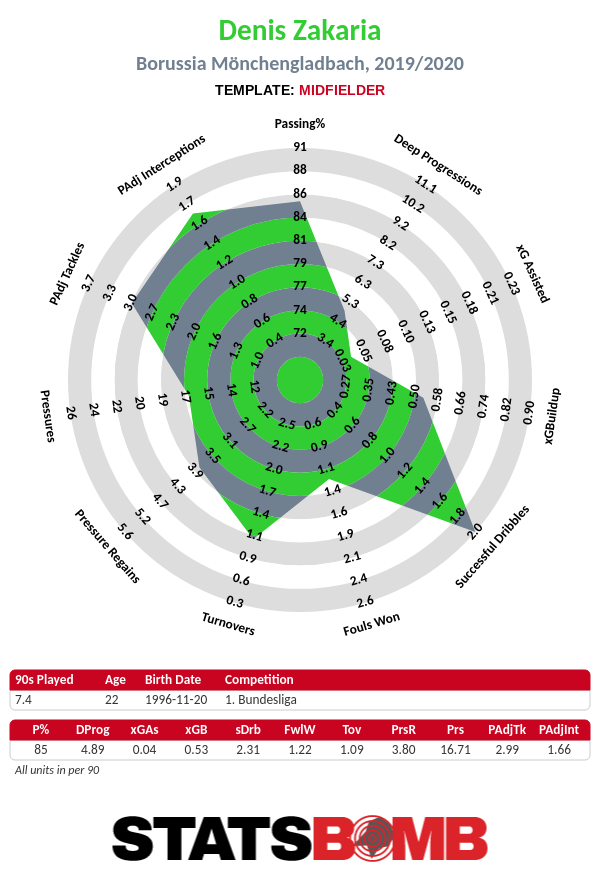 In the two box-to-box slots of the diamond, Rose had handed the keys to the two creatively talented youngsters of the squad, Neuhaus and the 22 year-old Slovakian László Bénes. The stylish allrounder Neuhaus (also 22) seems to be the prime candidate as a future record-sell for Mönchengladbach. He has the ball control, vision and positional smarts to excel in a multitude of midfield roles, and combines these skills with some very deft dribbling.
In the two box-to-box slots of the diamond, Rose had handed the keys to the two creatively talented youngsters of the squad, Neuhaus and the 22 year-old Slovakian László Bénes. The stylish allrounder Neuhaus (also 22) seems to be the prime candidate as a future record-sell for Mönchengladbach. He has the ball control, vision and positional smarts to excel in a multitude of midfield roles, and combines these skills with some very deft dribbling.
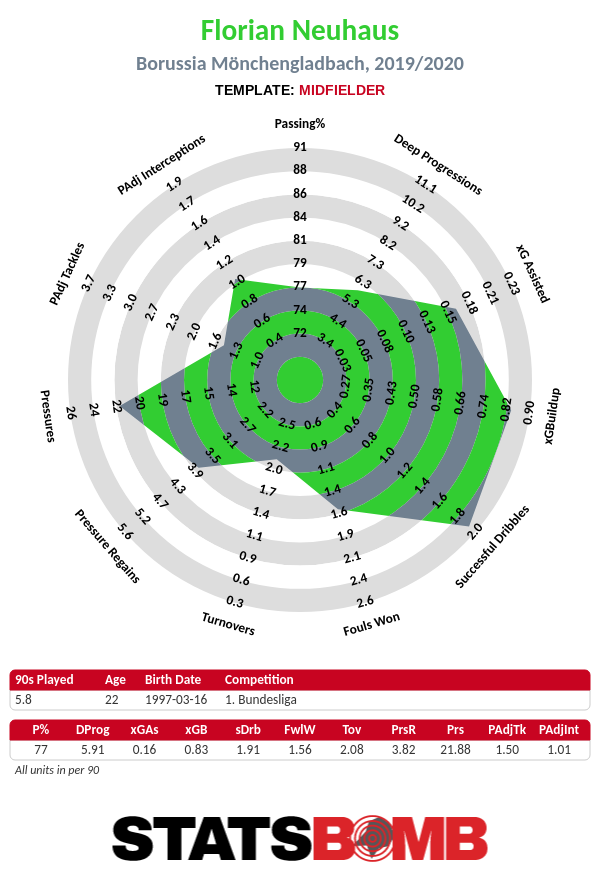 Defense
Defense
At right-back, Stefan Lainer, who joined Rose and Maric in their switch to the Ruhrgebiet city, is enjoying a very pleasant first couple of months in the German Bundesliga, after years of being a solid contributor in the Austrian one. But Gladbach’s backline gets defined by their central pairing, German international Matthias Ginter (25) and Swiss international Nico Elvedi (23), who have already tallied up a combined total of 328 top-flight Bundesliga games, despite their age. 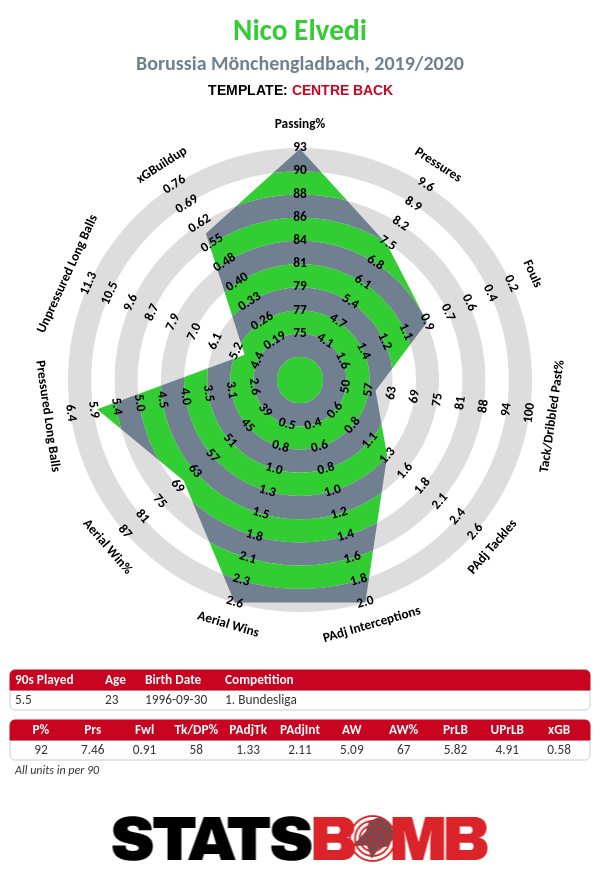
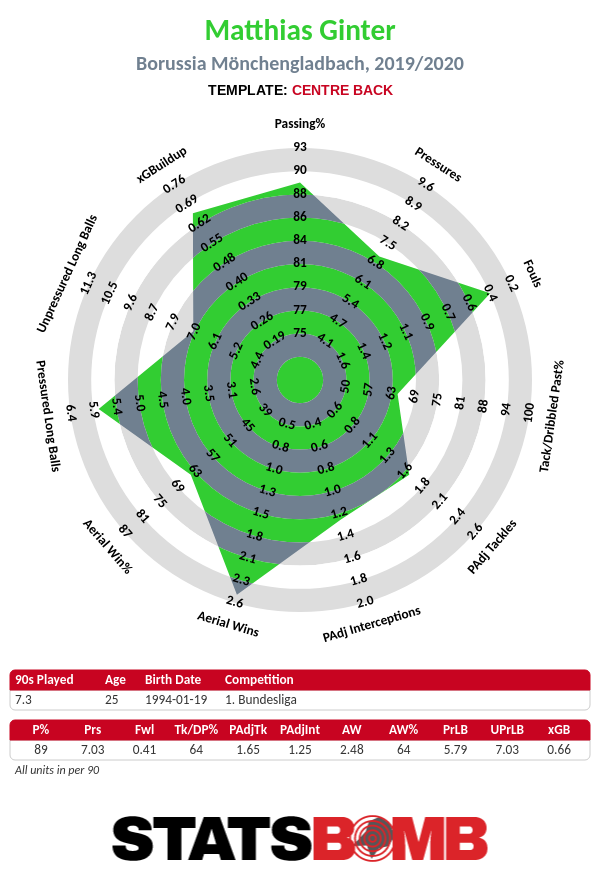 Neither Ginter nor Elvedi possess elite speed for central defenders for a top club in an elite competition, but they are both very good passers of the ball. Their swift and accurate ball movement in the early stages of Mönchengladbach’s possessions is a necessity with the current playing style.
Neither Ginter nor Elvedi possess elite speed for central defenders for a top club in an elite competition, but they are both very good passers of the ball. Their swift and accurate ball movement in the early stages of Mönchengladbach’s possessions is a necessity with the current playing style.
Goalkeeper
But, I promised you some Debbie Downer-y talk of overperformance, so here we go. While the offensive numbers of Mönchengladbach have been downright impressive, such is not the case on the defensive end. Their high-octane press has been very effective, and has thrown many of their opponents visibly off their game, while also serving as a springboard for their quick, decisive counter-attacks. But their current total of 6 goals conceded is thanks in large part to opposing offenses underperforming with regards to their finishing, and, even more importantly, to a spell of absolutely ridiculous super-form of goalie Yann Sommer. 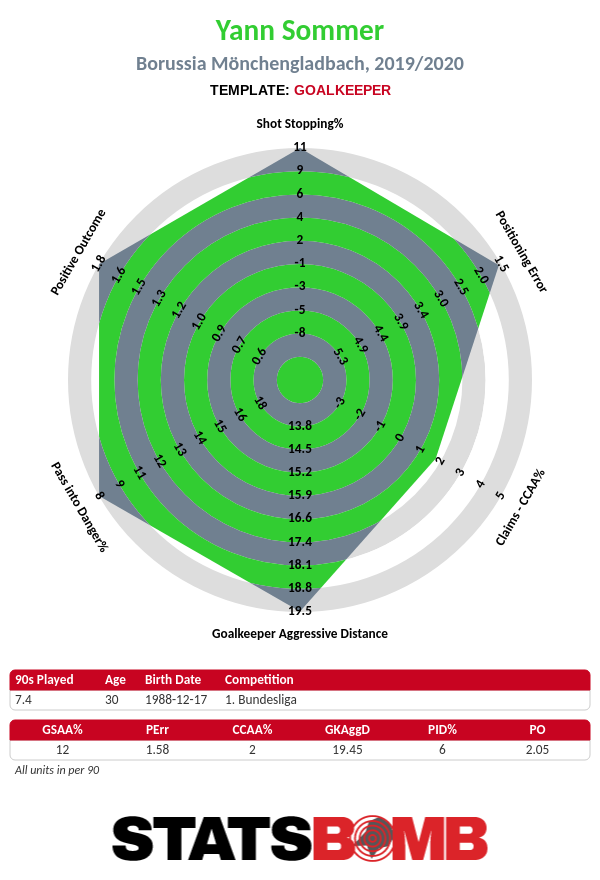
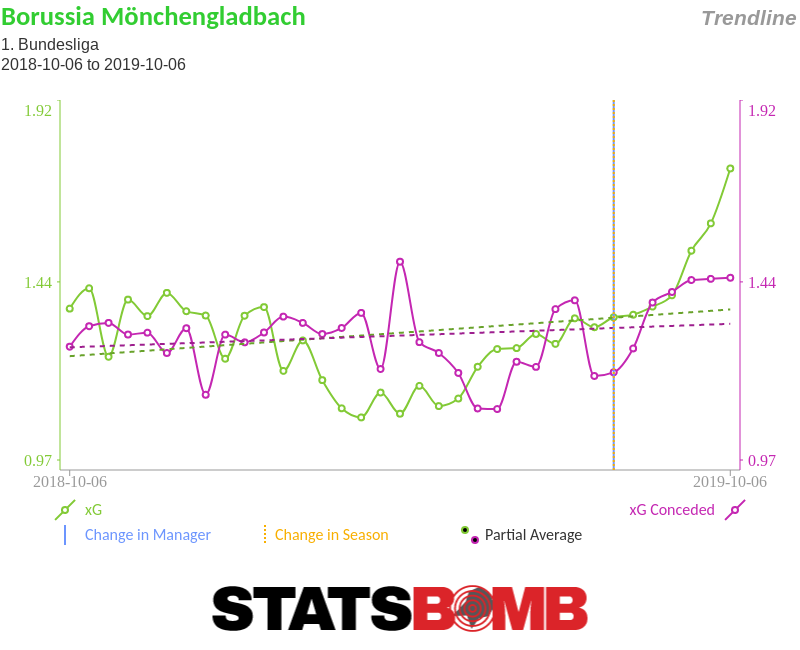 The Swiss goalkeeper‘s performance this season should be mentioned in debates about the best in the world. He’s saved 11.8% more goals than an average keeper would be expected to save given the set of shots he’s faced, that’s the second biggest gap in the league. He might just singlehandedly will Gladbach on a hot streak in his current form. But, defensively, this team is mortal, that’s for sure. Lucky for them that they are downright sexy, when it comes to attack.
The Swiss goalkeeper‘s performance this season should be mentioned in debates about the best in the world. He’s saved 11.8% more goals than an average keeper would be expected to save given the set of shots he’s faced, that’s the second biggest gap in the league. He might just singlehandedly will Gladbach on a hot streak in his current form. But, defensively, this team is mortal, that’s for sure. Lucky for them that they are downright sexy, when it comes to attack.
Can Pablo Machín help Espanyol recapture last year’s magic?
The second international break of the season is always a time when clubs who have made bad starts seriously consider the continuation of their head coaches. In La Liga, Espanyol were the first to act, firing David Gallego after taking just five points from their first eight fixtures -- the joint-worst start to a campaign in the club’s history. Last season, Espanyol secured European football for the first time in over a decade by converting the league’s eighth-best expected goal (xG) difference into a seventh-place finish. Hopes were high ahead of the new campaign, even following the departure of coach Rubi and top scorer Borja Iglesias to Real Betis, and defender Mario Hermoso to Atlético Madrid. The assumption was that their early start to the season in the Europa League qualifiers would help them fly out of the blocks in La Liga. That hasn’t proved to be the case at all. Espanyol sit second bottom with the league’s worst goal difference. No team has scored less than them, and only one has conceded more. They’ve led just twice all season, for a grand total of 58 minutes. They’ve lost all four of their home matches, scoring once while conceding 10. Supporters were already calling for Gallego’s head prior to Sunday’s 2-0 defeat away to Mallorca. In truth, those are the sort of results that would have any coach under pressure, although the underlying numbers suggest all isn’t quite as bad as it seems on the surface. Espanyol have been worse in attack than they were last season, taking less shots of lower average quality, but they’ve also given less away defensively. The balance is an xG difference of 0.10 per match -- marginally better than their season-long rate of the previous campaign. 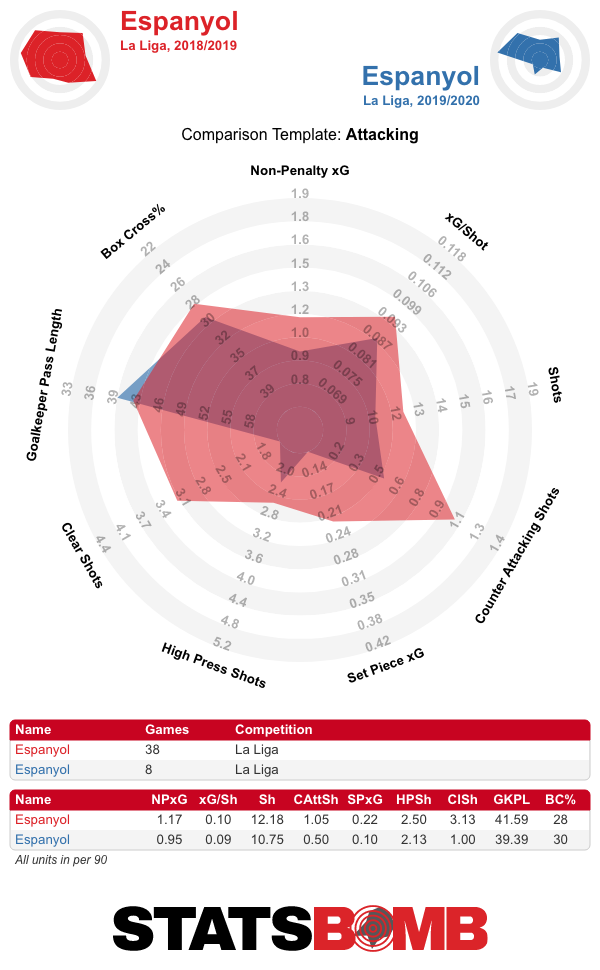
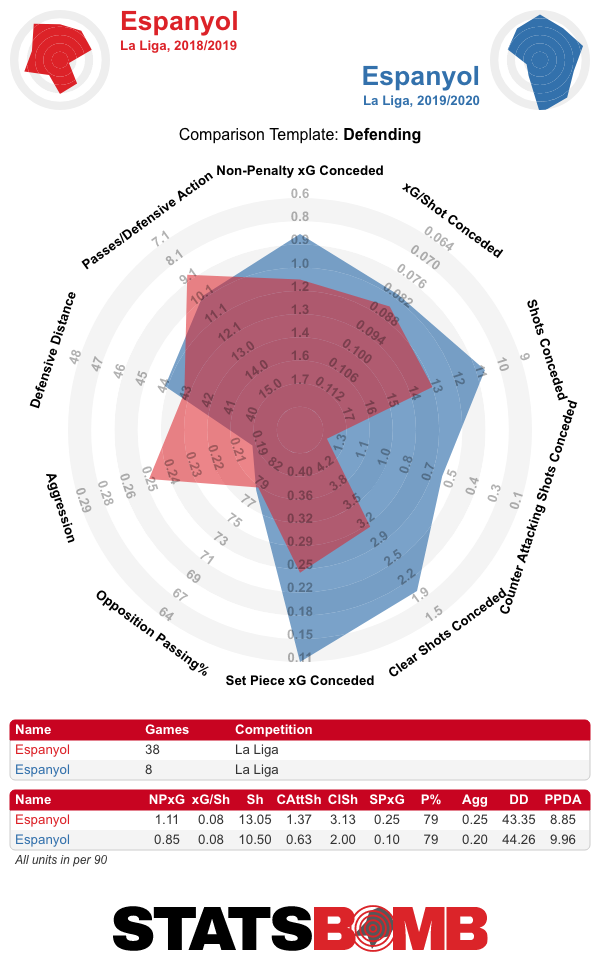 The main problem is that they are underperforming those numbers at both ends of the pitch. They’ve scored 3.8 less goals than expected and conceded 5.74 more -- a near 10-goal negative swing in comparison to their xG difference. In attack, they’ve converted three of the four highest-quality chances they’ve created, while getting nothing out of their remaining 83 shots (their other goal this season was an own goal):
The main problem is that they are underperforming those numbers at both ends of the pitch. They’ve scored 3.8 less goals than expected and conceded 5.74 more -- a near 10-goal negative swing in comparison to their xG difference. In attack, they’ve converted three of the four highest-quality chances they’ve created, while getting nothing out of their remaining 83 shots (their other goal this season was an own goal): 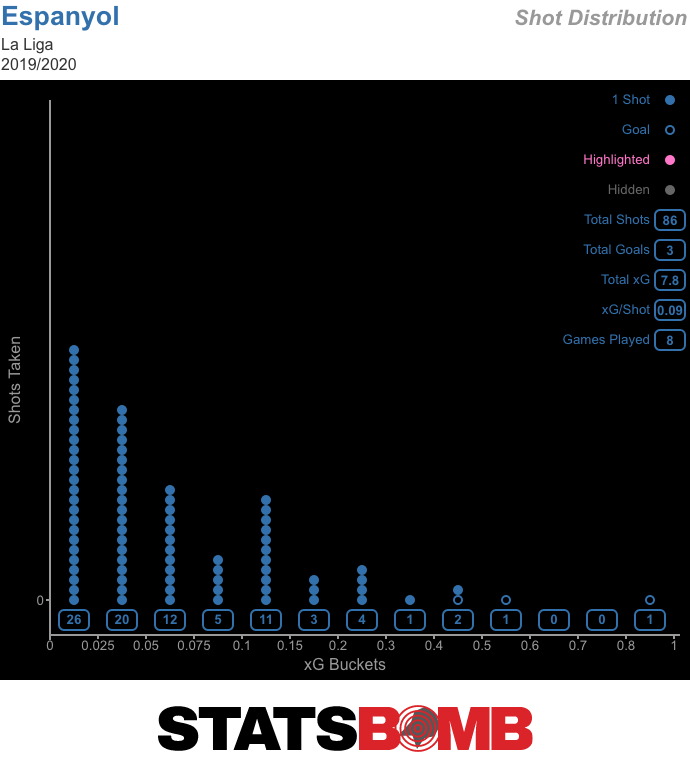 At the other end, opponents have likewise converted five of the six highest-quality chances Espanyol have conceded, but they have also scored seven times off shots in the five lowest-quality brackets -- all less than one-in-six opportunities:
At the other end, opponents have likewise converted five of the six highest-quality chances Espanyol have conceded, but they have also scored seven times off shots in the five lowest-quality brackets -- all less than one-in-six opportunities: 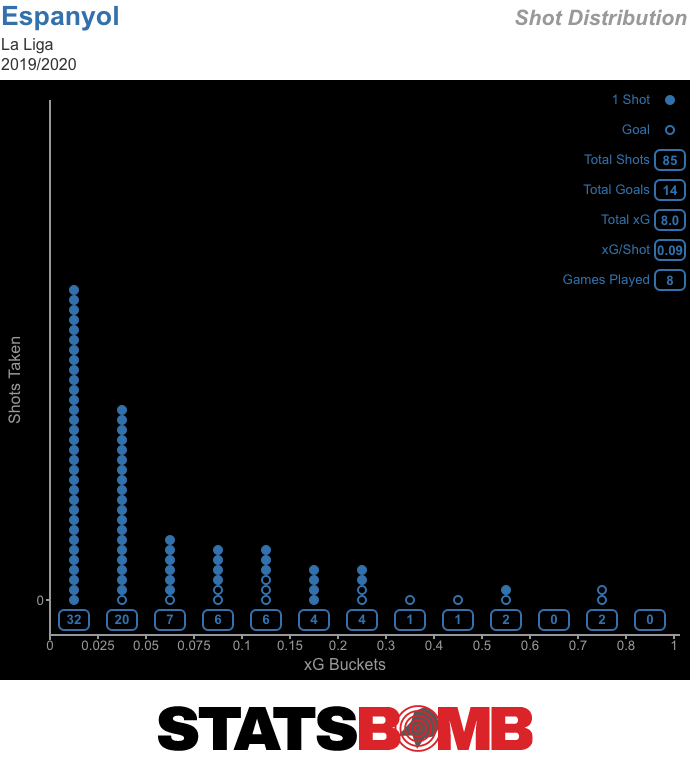 Those are the kinds of things that tend to even out over time. Having successfully led the team through the Europa League qualifying rounds into the group stage, Gallego may feel that he deserved some more of that. It bears noting that the lowest any team with a positive xG difference has finished in La Liga in either of the last two seasons is 12th. Perhaps reality would eventually have caught up with the underlying numbers. That would be the generous reading. We are only eight matches into the campaign and so difficulty of schedule is still a prominent factor in team performance. Espanyol’s has been very mild to date, pitting them against two of the three promoted teams, two teams who narrowly avoided relegation last season, an Alavés side who have looked one of the weakest in La Liga so far, and none of last season’s top five. It is questionable whether their positive underlying numbers would have held through the tougher fixtures now to come. In whatever terms you look at it, Espanyol have been dreadful in the first halves of their matches to date, being comfortably outshot, outscored and out-xG’d. They’ve only taken four shots on target, to 17 against, and just one from inside the area, to 12 against. Regardless of the degree to which you are later able to create chances (Espanyol’s second-half balance is 5.94 xG to 2.13 xG conceded), consistently putting yourself at that sort of disadvantage is a recipe for failure. And then there are the subjective impressions. Gallego’s Espanyol didn’t seem to have a clear idea of how to progress the ball upfield and were heavily reliant on individual inspiration to create opportunities in attack. Summer signing Matías Vargas, the most expensive in the club’s history, took on the large majority of the creative burden (he currently leads the team in dribbles, throughballs, xG assisted and open play passes into the box). The lack of systemised ball progression surely contributed to three giveaways in defensive territory that led directly to opposition goals. In that context, and with some interesting coaches with experience and previous success freely available to take over, it is fairly easy to make a case for Espanyol’s decision to replace Gallego.
Those are the kinds of things that tend to even out over time. Having successfully led the team through the Europa League qualifying rounds into the group stage, Gallego may feel that he deserved some more of that. It bears noting that the lowest any team with a positive xG difference has finished in La Liga in either of the last two seasons is 12th. Perhaps reality would eventually have caught up with the underlying numbers. That would be the generous reading. We are only eight matches into the campaign and so difficulty of schedule is still a prominent factor in team performance. Espanyol’s has been very mild to date, pitting them against two of the three promoted teams, two teams who narrowly avoided relegation last season, an Alavés side who have looked one of the weakest in La Liga so far, and none of last season’s top five. It is questionable whether their positive underlying numbers would have held through the tougher fixtures now to come. In whatever terms you look at it, Espanyol have been dreadful in the first halves of their matches to date, being comfortably outshot, outscored and out-xG’d. They’ve only taken four shots on target, to 17 against, and just one from inside the area, to 12 against. Regardless of the degree to which you are later able to create chances (Espanyol’s second-half balance is 5.94 xG to 2.13 xG conceded), consistently putting yourself at that sort of disadvantage is a recipe for failure. And then there are the subjective impressions. Gallego’s Espanyol didn’t seem to have a clear idea of how to progress the ball upfield and were heavily reliant on individual inspiration to create opportunities in attack. Summer signing Matías Vargas, the most expensive in the club’s history, took on the large majority of the creative burden (he currently leads the team in dribbles, throughballs, xG assisted and open play passes into the box). The lack of systemised ball progression surely contributed to three giveaways in defensive territory that led directly to opposition goals. In that context, and with some interesting coaches with experience and previous success freely available to take over, it is fairly easy to make a case for Espanyol’s decision to replace Gallego.
The Replacement: Pablo Machín
His successor is Pablo Machín, out of work since being sacked by Sevilla in March. It looks a good appointment. In his two top-flight seasons, Machín has shown himself to be a highly competent and somewhat adaptable coach. After securing Girona’s first-ever promotion to the Primera División, he led them to a 10th place finish in 2017-18 with a fairly industrial attack built around crosses and set-pieces, and a high-lined defence that did a very solid job of both breaking up opposing passing chains and suppressing shots. They finished the campaign with a positive shot ratio and the division’s 10th-best xG difference, at -0.03 per match. That campaign earned him the opportunity to move up to Sevilla. Machín made full use of the increased talent level, achieving a league third-best 0.52 xGD per match through his 27 matches at the helm. He instituted an open, run-and-gun approach that saw Sevilla outscore all but Barcelona and Real Madrid. His previous reliance on set-pieces and crosses eased considerably. Everything was going well until accumulated fatigue from an early start to the season in the Europa League qualifying rounds and a slump in form for goalkeeper Tomáš Vaclík (one that appears to have continued into the current campaign, as can be seen at the bottom of this piece) combined to produce a run of just two wins in 11 matches. Sevilla dropped out of the top four. Machín was sacked. 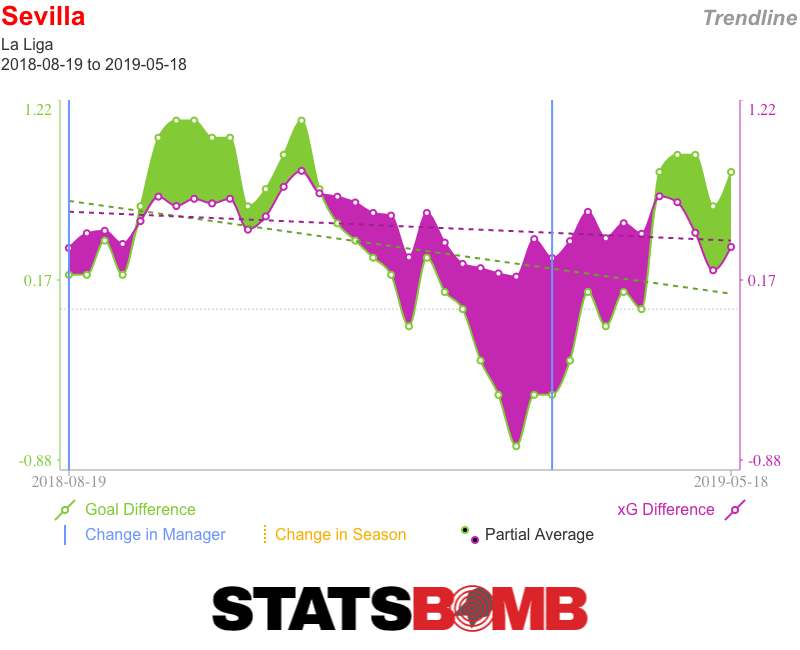 Espanyol provide him with the opportunity to prove that was a mistake. “It is a club that is improving, that wants to progress,” he said at his presentation. “And I am a coach with room still to improve. I’d like us to do it together.” Machín certainly inherits a squad that looks well-suited to his preferred setup, with different attacking configurations but always three central defenders and a pair of wing-backs. It will be particularly interesting to see what he is able to do with Adriá Pedrosa, a vibrant youngster somewhere between full-back and winger who should prosper at wing-back. His former Girona charge Bernardo Espinosa will be glad to see him after receiving no league action under Gallego. Marc Roca and Sergi Darder are very much capable of holding things together in midfield, while Óscar Melendo, one of the more promising young creative passers in La Liga, will hopefully get more chances than he latterly did under Gallego. There are a couple of question marks. Without Iglesias, Espanyol lack a proven goalscorer. Jonathan Calleri is physical, hard-working and good in the air (four of his nine goals at Alavés last season were from headers), but there has been little evidence to date to suggest he’ll be capable of Christian Stuani-like numbers at the head of a Machín attack. And will the squad be able to meet the physical demands of his approach over the full course of the campaign given that whether in terms of xG or results, both his Girona and Sevilla sides suffered a drop off in the second half of the season? But those are fairly minor concerns. There are worse teams than Espanyol in La Liga this season, and with a good coach now in charge, they should be expected to edge up towards the middle of the pack as the season progresses.
Espanyol provide him with the opportunity to prove that was a mistake. “It is a club that is improving, that wants to progress,” he said at his presentation. “And I am a coach with room still to improve. I’d like us to do it together.” Machín certainly inherits a squad that looks well-suited to his preferred setup, with different attacking configurations but always three central defenders and a pair of wing-backs. It will be particularly interesting to see what he is able to do with Adriá Pedrosa, a vibrant youngster somewhere between full-back and winger who should prosper at wing-back. His former Girona charge Bernardo Espinosa will be glad to see him after receiving no league action under Gallego. Marc Roca and Sergi Darder are very much capable of holding things together in midfield, while Óscar Melendo, one of the more promising young creative passers in La Liga, will hopefully get more chances than he latterly did under Gallego. There are a couple of question marks. Without Iglesias, Espanyol lack a proven goalscorer. Jonathan Calleri is physical, hard-working and good in the air (four of his nine goals at Alavés last season were from headers), but there has been little evidence to date to suggest he’ll be capable of Christian Stuani-like numbers at the head of a Machín attack. And will the squad be able to meet the physical demands of his approach over the full course of the campaign given that whether in terms of xG or results, both his Girona and Sevilla sides suffered a drop off in the second half of the season? But those are fairly minor concerns. There are worse teams than Espanyol in La Liga this season, and with a good coach now in charge, they should be expected to edge up towards the middle of the pack as the season progresses.
Stats of Interest
Luuk de Jong received plenty of stick after missing some good chances for Sevilla in their 4-0 defeat away to Barcelona on Sunday. He’s getting in the positions often enough this season, but sooner or later he needs to convert that into goals. 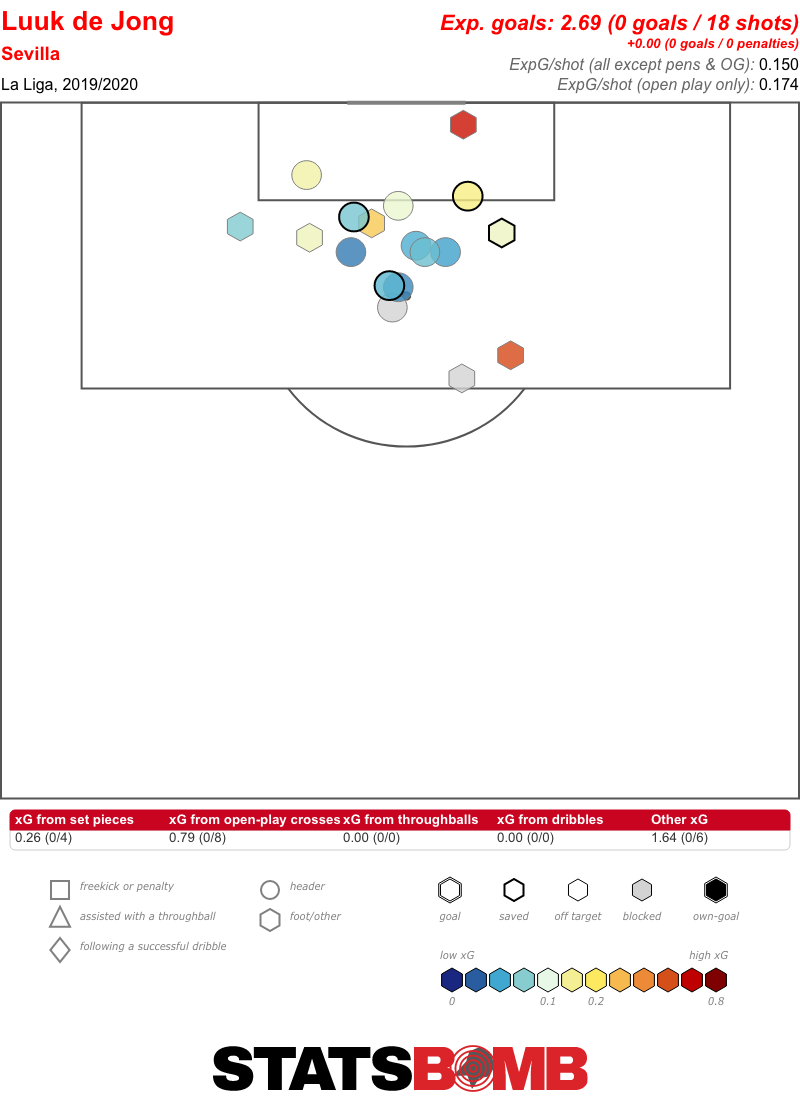 Sevilla also have problems in the other penalty area. Goalkeeper Vaclík has been pretty bad so far this season, conceding four more goals than expected -- the biggest underperformance of any goalkeeper in La Liga to date.
Sevilla also have problems in the other penalty area. Goalkeeper Vaclík has been pretty bad so far this season, conceding four more goals than expected -- the biggest underperformance of any goalkeeper in La Liga to date.  The only team currently below Espanyol in the table are a Leganés side on two points. Their underlying numbers have been solid enough to suggest they are capable of more, and the club’s confidence in coach Mauricio Pellegrino rightly persists. But they really have to start getting some points on the board.
The only team currently below Espanyol in the table are a Leganés side on two points. Their underlying numbers have been solid enough to suggest they are capable of more, and the club’s confidence in coach Mauricio Pellegrino rightly persists. But they really have to start getting some points on the board. 